
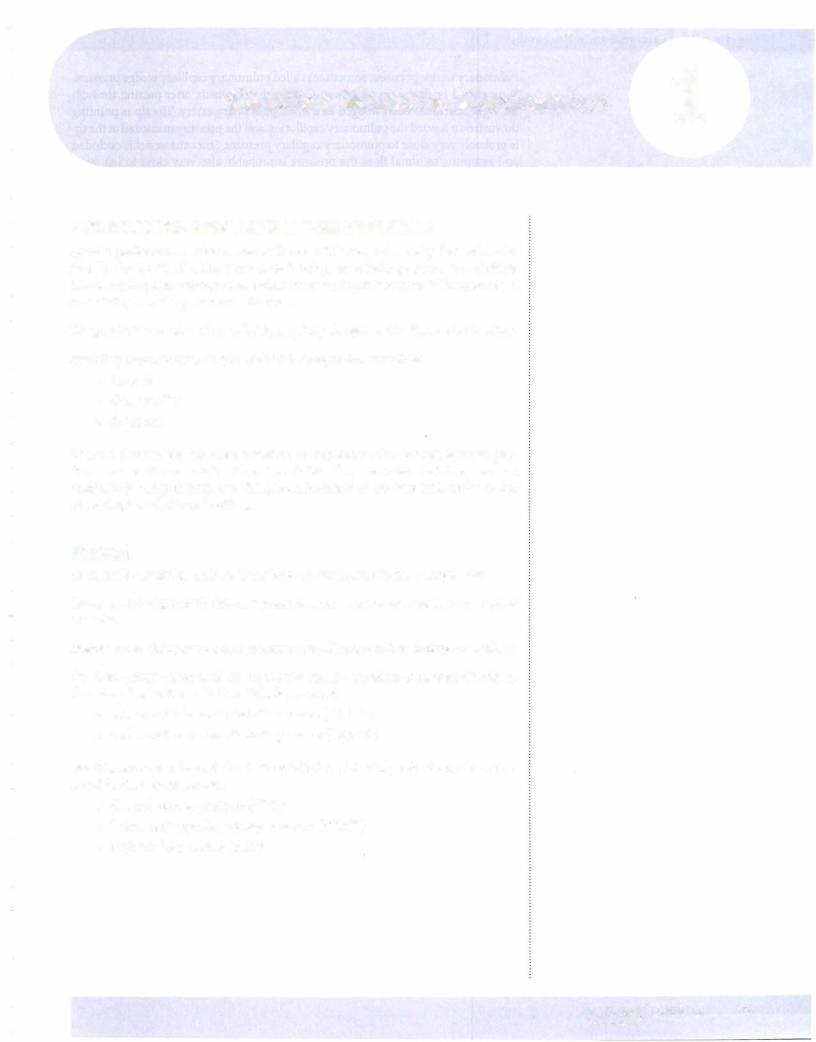
Cardiac Muscle Mechanics |
1 |
SYSTOLIC PERFORMANCE OF THE VENTRICLE
Systolic performance actuallymeansthe overall force generatedbythe ventricular muscle during systole. The heart does 2 things in systole: pressurizes and ejects blood. An important factor influencingthis systolic performance is the number of cross-bridges cycling during contraction.
The greater the numberofcross-bridges cycling, the greaterthe force ofcontraction.
Systolic performance is determined by 3 independent variables:
•Preload
•Contractility
•Afterload
These 3 factors are summed together to determine the overall systolic per formance of the ventricle. Recent work has demonstrated that they are not completely independent, but the generalizations made here will apply to the physiologic and clinical setting.
Preload
As in skeletal muscle,preload is the load on the muscle in the relaxed state.
More specifically, it is the load or prestretch on ventricular muscle at the end of diastole.
Preload on ventricularmuscle is not measured directly; rather, indices are utilized.
The best indices of preload on ventricular muscle are those measured directly in the ventricles. Indices of left ventricular preload:
•Left ventricular end-diastolic volume (LVEDV)
•Left ventricular end-diastolic pressure (LVEDP)
Possibly somewhat less reliable indices ofleft ventricular preload arethose mea sured in the venous system.
•Central venous pressure (CVP)
•Pulmonary capillary wedge pressure (PCWP)
•Right atrial pressure (RAP)
MEDICAL 73
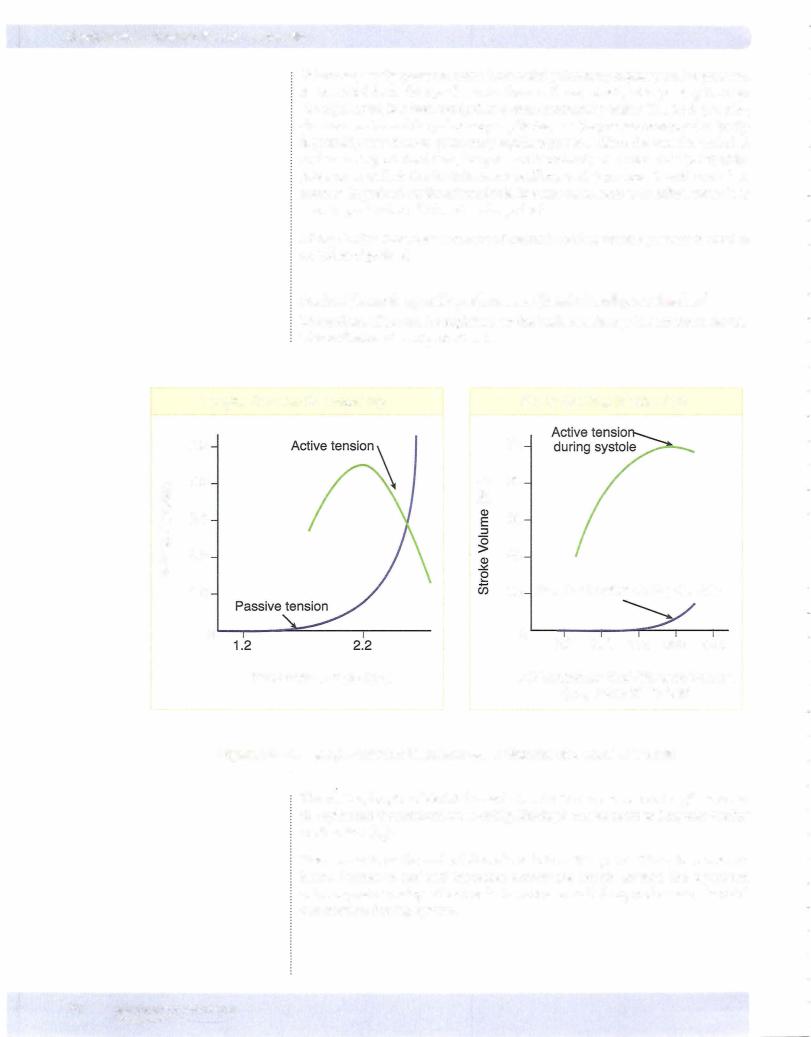
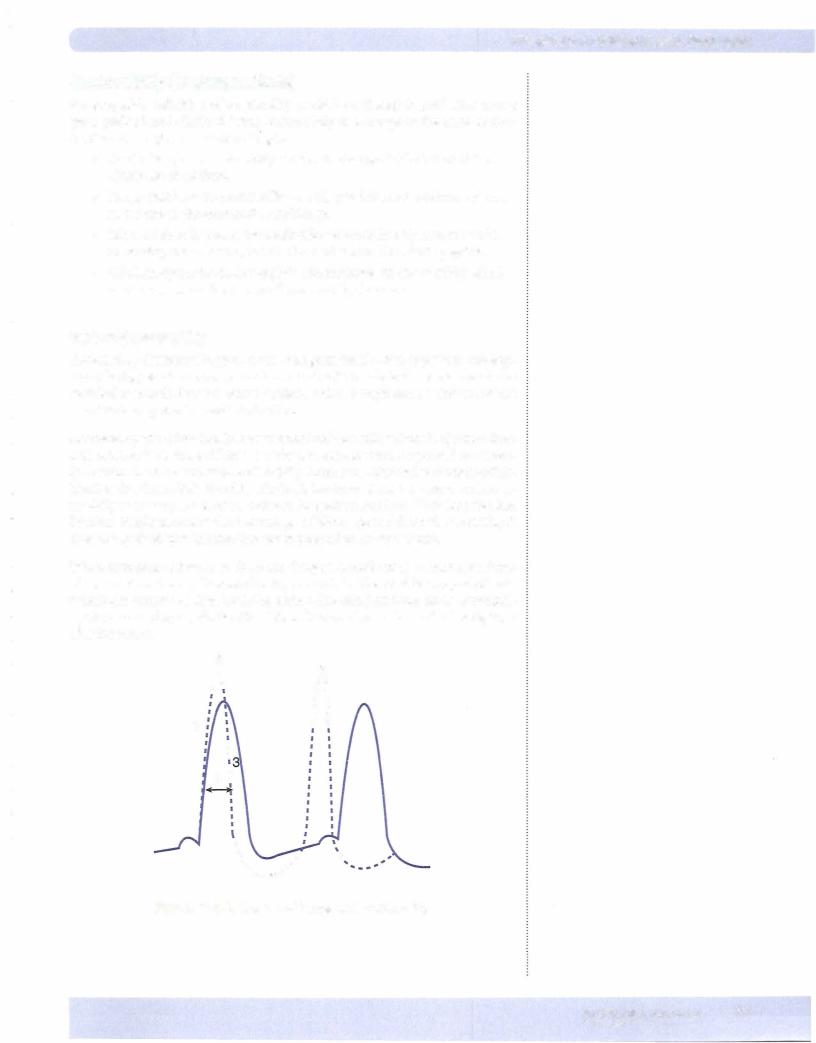
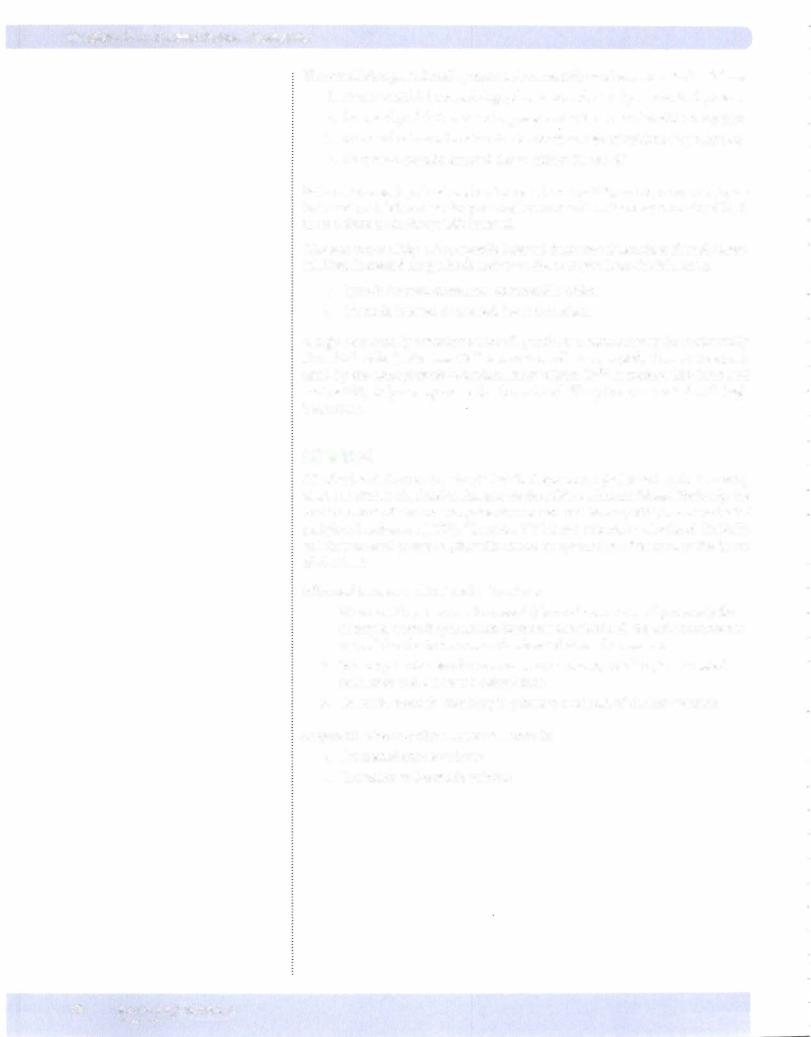
Section IV • Cardiac Muscle Mechanics
The overall changes induced by increased contractility canbe summarized as follows:
1.Increased dp!dt increased slope, thus increased rate ofpressure development
2.Increased peak left ventricular pressure due to a more forceful contraction
3.Increased rate of relaxation due to increased rate of calcium sequestration
4.Decreased systolic interval due to effects #1 and #3
Both an increased preload and an increased contractility are accompanied by an increased peak left ventricular pressure, but onlywith an increase in contractility is there a decrease in the systolic interval.
Whereas contractility affects systolic interval, heart rate determines diastolic inter val.Thus, increased sympathetic activity to the heart produces the following:
•Systolic interval decreased: contractility effect
•Diastolic interval decreased: heart rate effect
A high heart rate (pacemaker-induced) produces a small increase in contractility (Bowditch effect). Because Ca2+ enters the cell more rapidly than it is seques tered by the sarcoplasmic reticulum, intracellular Ca2+ increases. The increased contractility helps compensate for the reduced filling time associated with high heart rates.
Afterload
Afterload is defined as the "load" that the heart must eject blood against. Exactly what constitutes afterload to the heart is the subject ofmuch debate. Probably, the best "marker" of afterload is systemic vascular resistance (SVR), also called total peripheral resistance (TPR). However, TPR is not routinely calculated clinically and thus arterial pressure (diastolic, mean, or systolic) is often used as the index of afterload.
Afterload is increased in 3 main situations:
1.When aortic pressure is increased (elevated mean arterial pressure); for example, when hypertension increases the afterload, the left ventricle has to work harder to overcome the elevated arterial pressures.
2.When systemic vascular resistance is increased, resulting in increased resistance and decreased compliance
3.In aortic stenosis, resulting in pressure overload of the left ventricle
.In general, when afterload increases, there is:
•Decreased stroke volume
•Increased end-systolic volume
76 MEDICAL
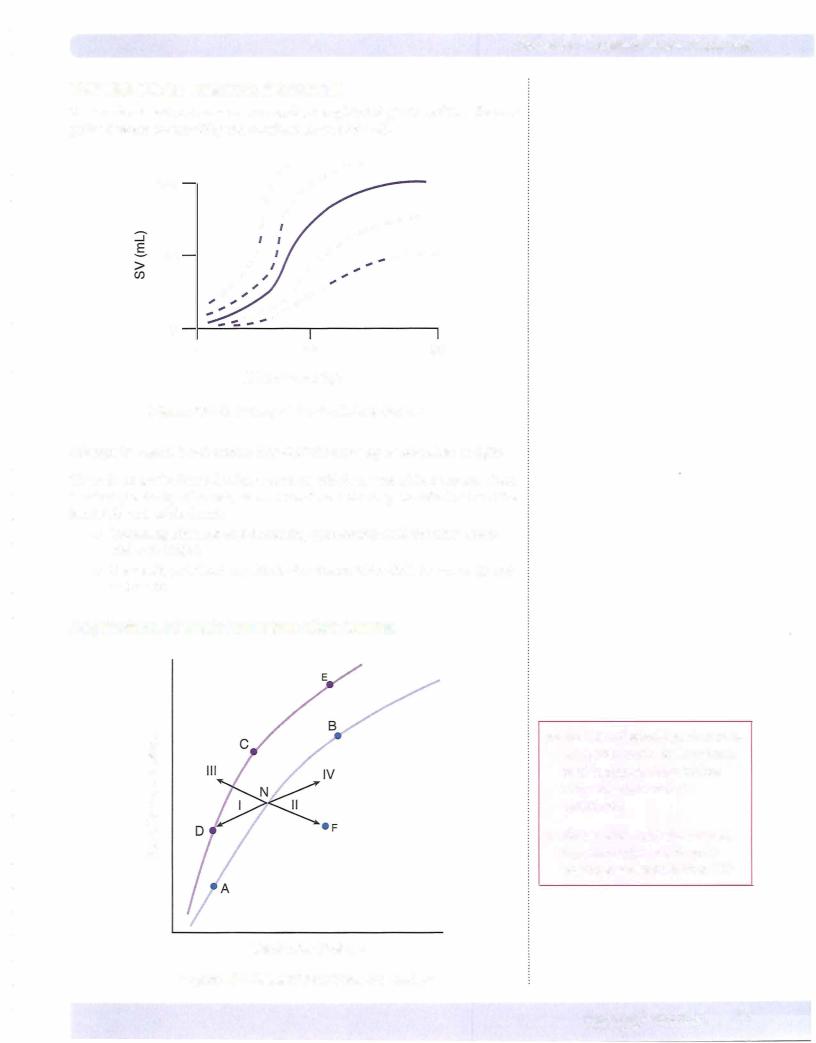
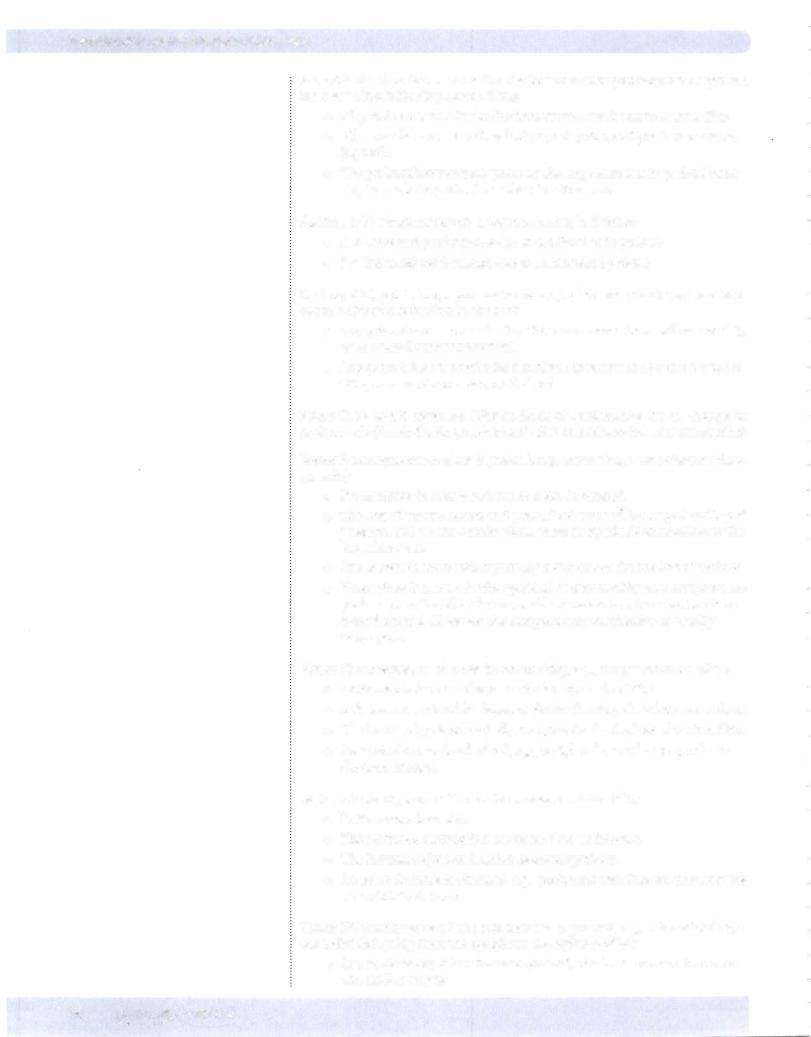
Section IV • Cardiac Muscle Mechanics
A ventricular function curve is the rise in ventricular performance as preload increases (Frank-Starling curve). Thus:
•Allpoints on a ventricular function curve have the same contractility.
•Allcurves have an ascending limb, a peak point, and possibly a descend ing limb.
•The pericardium normallyprevents the large increases in preload neces sary to reach the peak of a cardiac function curve.
Starting at N, which represents a normal, resting individual:
•A = decreased performance due to a reduction in preload
•B = increased performance due to an increased preload
Starting at N, point C represents an increased performance due to an increase in contractility or a reduction in afterload.
•Anypoint above aventricular function curve means increased contractility, or an acute decrease in afterload.
•Any point below a ventricular function curve means decreased contrac tility, or an acute increase in afterload..
Points C, D, and E represent different levels of performance due to changes in preload only (Frank-Starling mechanism); all 3 points have the same contractility.
Vector I: consequences ofa loss in preload, e.g., hemorrhage, venodilators (nitro glycerin)
•Performance decreases because of a loss in preload.
•The loss ofvenous return and preload reduces cardiac output and blood pressure, and via the carotid sinus, reflex sympathetic stimulation to the heart increases.
•The increased contractility partially compensates for the loss of preload.
•When there is a loss of either preload or contractility that compromises performance, the other factor usually increases to return performance toward normal. However, the compensatory mechanism is usually incomplete.
Vector II: consequences of a loss in contractility, e.g., congestive heart failure
•Performance decreases because of a loss in contractility.
•Adecreasein contractilitydecreases ejection fraction,whichincreasespreload.
•The increased preload partially compensates for the loss of contractility.
•An acute decrease in afterload, e.g., peripheral vasodilation, produces the same change.
Vector III: consequences of an acute increase in contractility
•Performance increases.
•The increased contractility increases ejection fraction.
•The increased ejection fraction decreases preload.
•An acute decrease is afterload, e.g., peripheral vasodilation, produces the same shift in the curve.
Vector IV: consequences of an acute increase in preload, e.g., volume loading in the individual going from the upright to the supine position.
•Increased venous return increases preload, which increases performance and cardiac output.
78 MEDICAL
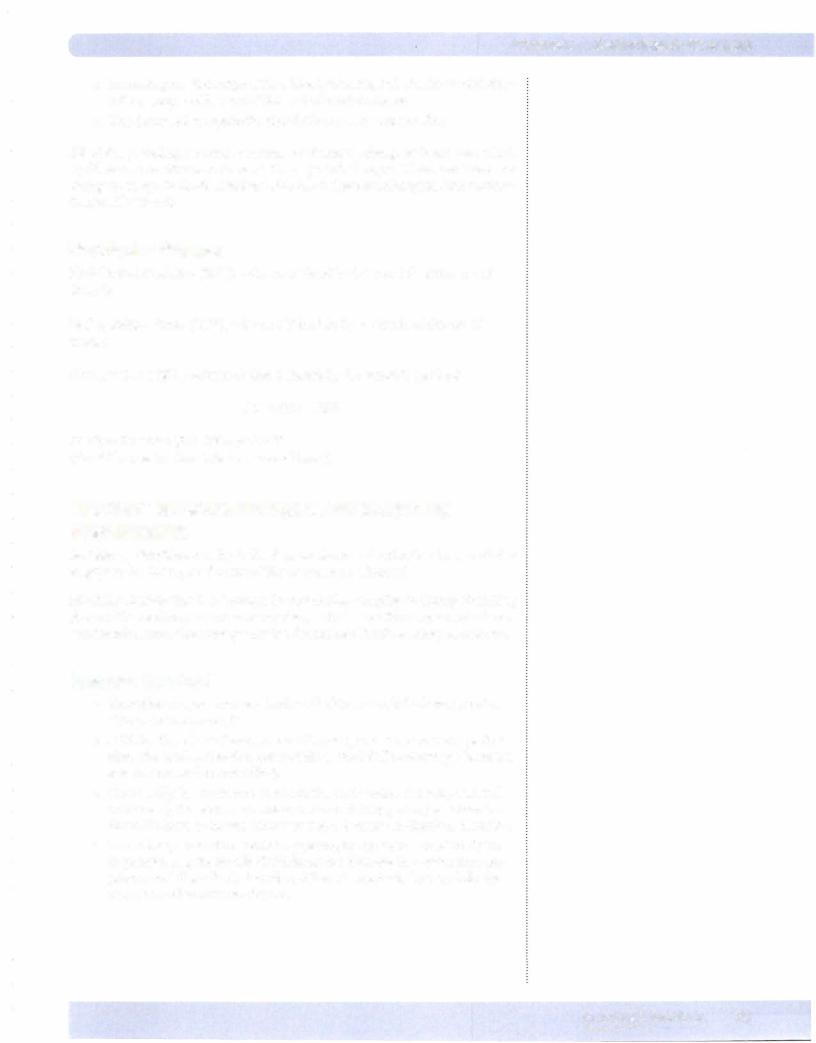
Chapter s • Cardiac Muscle Mechanics
•Increasing cardiac output raises blood pressure, and via the carotid sinus reflex, sympathetic stimulation to the heart decreases.
•The decreased sympathetic stimulation reduces contractility.
Allof the preceding sequences assume no dramatic change in heart rate, which could reduce or eliminate some of the expected changes. Whenever there is a change in sympathetic stimulation to the heart, there is a change in both contrac tility and heart rate.
VentricularVolumes
End-diastolic volume (EDV): volume ofblood in the ventricle at the end of diastole
End-systolic volume (ESV): volume ofblood in the ventricle at the end of systole
Stroke volume (SV): volume ofblood ejected by the ventricle per beat
SV = EDV - ESV
Ejection Fraction (EF): EF = SV/EDV (should be greater than 55% in a normal heart)
CHRONIC CHANGES: SYSTOLIC AND DIASTOLIC DYSFUNCTION
Systolic dysfunction can be defined as an abnormal reduction in ventricular emptying due to impaired contractility or excessive aft:erload.
Diastolic dysfunction is a decrease in ventricular compliance during the filling phase ofthe cardiac cycle due to either changes in tissue stiffness or impaired ven tricular relaxation. The consequence is a diminished Frank-Starling mechanism.
Pressure Overload
•Examples of a pressure overload on the left ventricle include hyperten sion and aortic stenosis.
•Initially, there is no decrease in cardiac output or an increase in preload since the cardiac function curve shifts to the left (increased performance due to increased contractility).
•Chronically, in an attempt to normalize wall tension (actually internal wall stress), the ventricle develops a concentric hypertrophy. There is a dramatic increase in wall thickness and a decrease in chamber diameter.
•The consequence of concentric hypertrophy (new sarcomes laid down in parallel, i.e., the myofibril thickens) is a decrease in ventricular com pliance and diastolic dysfunction, followed eventually by a systolic dys function and ventricular failure.
MEDICAL 79
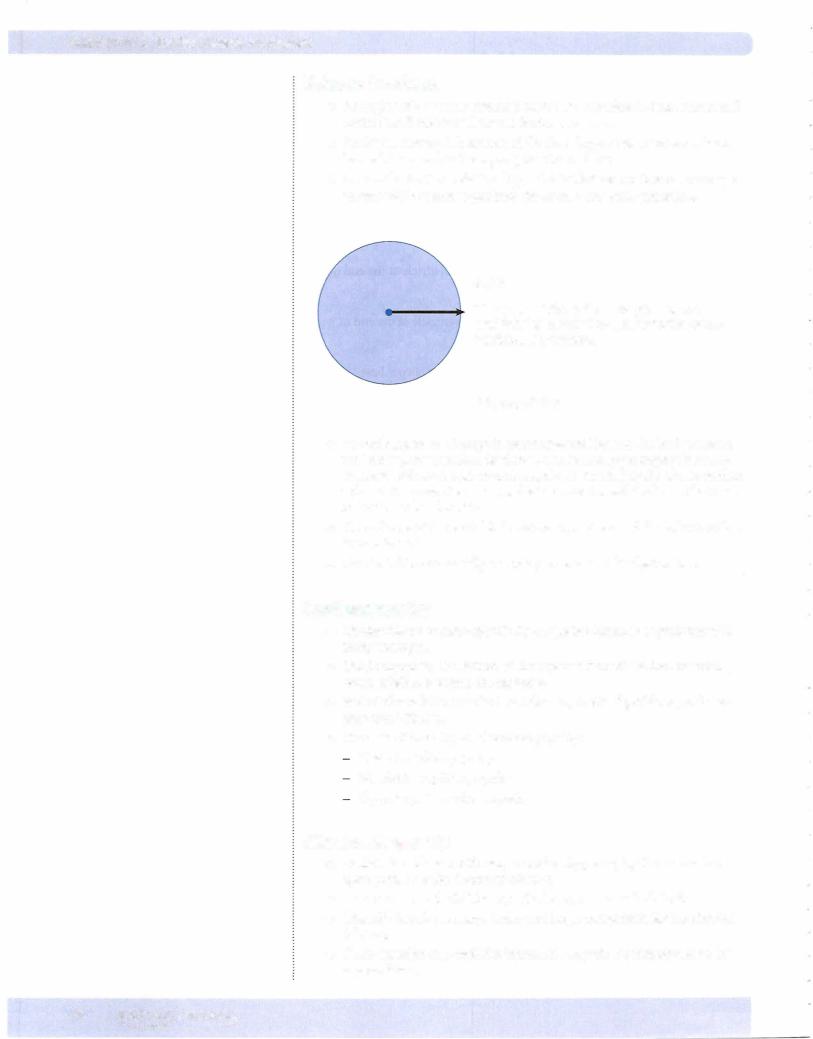
Section IV • cardiac Muscle Mechanics
Volume Overload
•Examples of a volume overload on the left ventricle include mitral and aortic insufficiency and patent ductus arteriosus.
•Fairly well tolerated ifdeveloped slowly. A large acute volume overload less well tolerated and can precipitate heart failure.
•Due to the LaPlace relationship, a dilated left ventricle must develop a greater wall tension to produce the same ventricular pressures.
rP=T/r
The greater the radius, the greater the wall tension needed to generate the same ventricular pressure.
Figure IV-1-5
•Chronically, in an attempt to normalize wall tension (actually internal wall stress), the ventricle develops an eccentric hypertrophy (new sar comeres laid down end-to-end, i.e., the myofibril lengthens) . As cardiac volumes increase, there is a modest increase in wall thickness that does not reduce chamber size.
•Compliance of the ventricle is not compromised and diastolic function is maintained.
•Eventual failure is usually a consequence of systolic dysfunction.
Cardiomyopathy
•Cardiac failure or more specifically congestive failure is a syndrome with many etiologies.
•Cardiomyopathy is a failure of the myocardium where the underlying cause originates within the myocyte.
•Excluded would be valvular heart disease, afterload problems, and coro nary heart disease.
•There are 3 basic types of cardiomyopathy:
Dilated cardiomyopathy
Restrictive cardiomyopathy
Hypertrophic cardiomyopathy
Dilated cardiomyopathy
•Ventricular dilation with only a modest hypertrophy that is less than appropriate for the degree of dilation
•It can occur for the left heart, right heart, or can include both.
•Diastolic function remains intact and helps compensate for the chamber dilation.
•Compensation also includes increased sympathetic stimulation to the myocardium.
80 MEDICAL
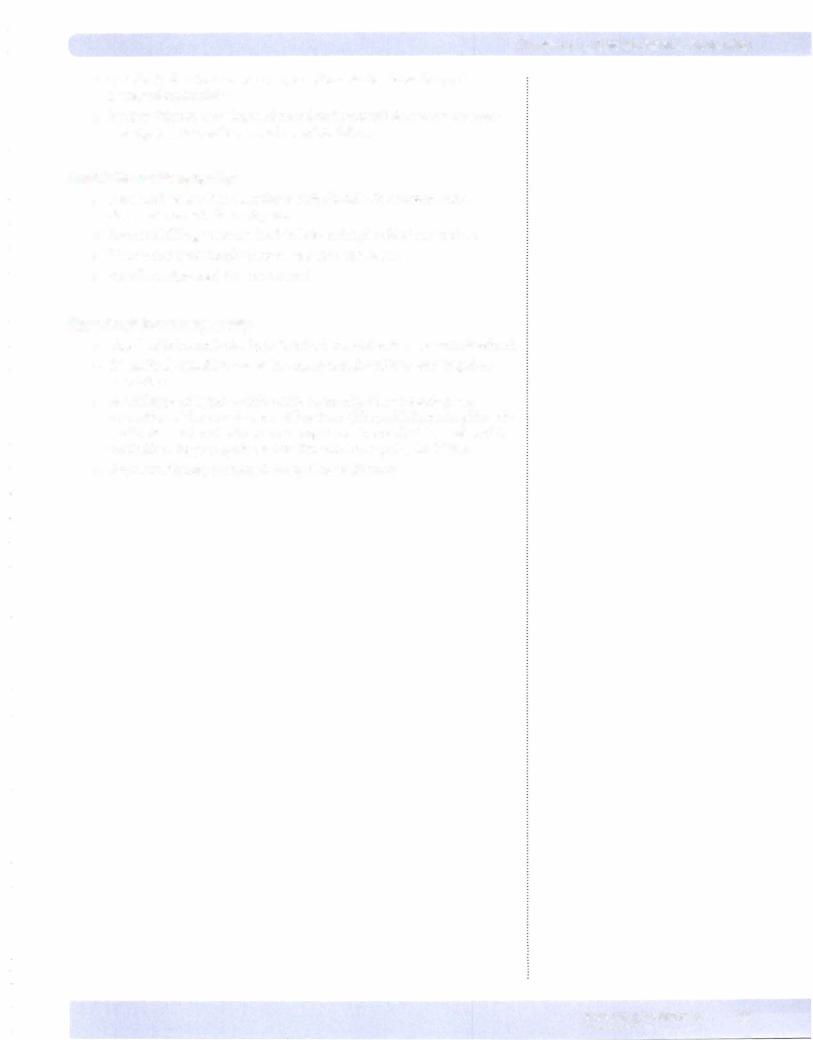
Chapter 1 • cardiac Muscle Mechanics
•Systolic dysfunction despite compensations via Frank-Starling and increased contractility
•Further dilation over time and mitral and tricuspid failure enhance sys tolic dysfunction with eventual complete failure.
Restrictive canliomyopathy
•Decreased ventricular compliance with diastolic dysfunction and a decrease in ventricular cavity size
•Increased fillingpressures lead to leftand right-sided congestion.
•Ventricular hypertrophy may or may not be present.
•Systolic maintained close to normal
Hypertrophic cardiomyop athy
•Septal or left ventricular hypertrophy is unrelated to a pressure overload.
•Diastolic dysfunction due to increased muscle stiffness and impaired relaxation
•Is a subtype ofhypertrophic cardiomyopathy, often resulting in a restriction ofthe ventricular outflow tract (idiopathic hypertrophic sub aortic stenosis) and pulmonary congestion. Currently this is referred to clinically as hypertrophic obstructive cardiomyopathy (HOCM).
•Hypertrophy may be related to septal fiber disarray.
':'1EDICAL |
81 |
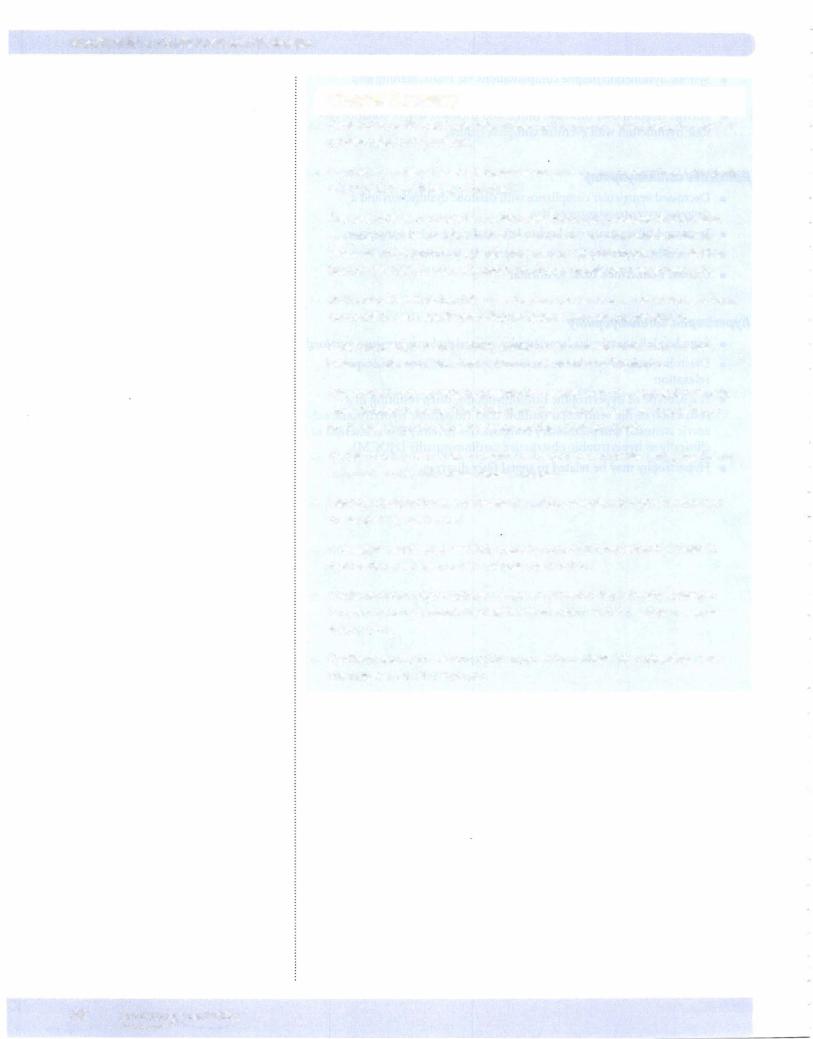
Section IV • cardiac Muscle Mechanics
Chapter Summary
•Ventricular performance is determined by the amount of preload, the level of contractility, and afterload.
•Acutely, the preload effect determines sarcomere length, and the contractility effect by the availability of calcium.
•The best indices ofpreload are ventricular end-diastolic volume and pressure, and indices ofcontractility include the rate of pressure development during isovolumetric contraction, systolic interval, and ejection fraction. The ejection fraction (SV/EDV) in normal individuals should usually be greaterthan 55%.
•Both preload and contractility alterthe force ofventricular contraction, but only contractility has a significant effect on systolic interval (decreasing it).
•A loss of preload or contractility produces an increase in the otherfactor, which functions to minimize the loss in ventricular performance.
•Afterload on the ventricle represents the overall force the ventricular muscle must develop to pump the blood out ofthe ventricle. A close approximation for the left ventricle is the resistance ofthe arterioles (TPR).
•Systolic dysfunction is an abnormal reduction in ventricular emptying due to impaired contractility or excessive afterload.
•Diastolic dysfunction is a decrease in muscle compliance and a diminished Frank-Starling mechanism.
•A pressure overloaded ventricle causes a concentric hypertrophy, diastolic dysfunction, and eventually a systolic dysfunction.
•A volume overloaded ventricle causes an eccentric hypertrophy. Diastolic function is usually maintained with failure, which is the result of a systolic dysfunction.
•Cardiomyopathy is a failure ofthe myocardium where the underlying cause originates within the myocyte.
82 MEDICAL
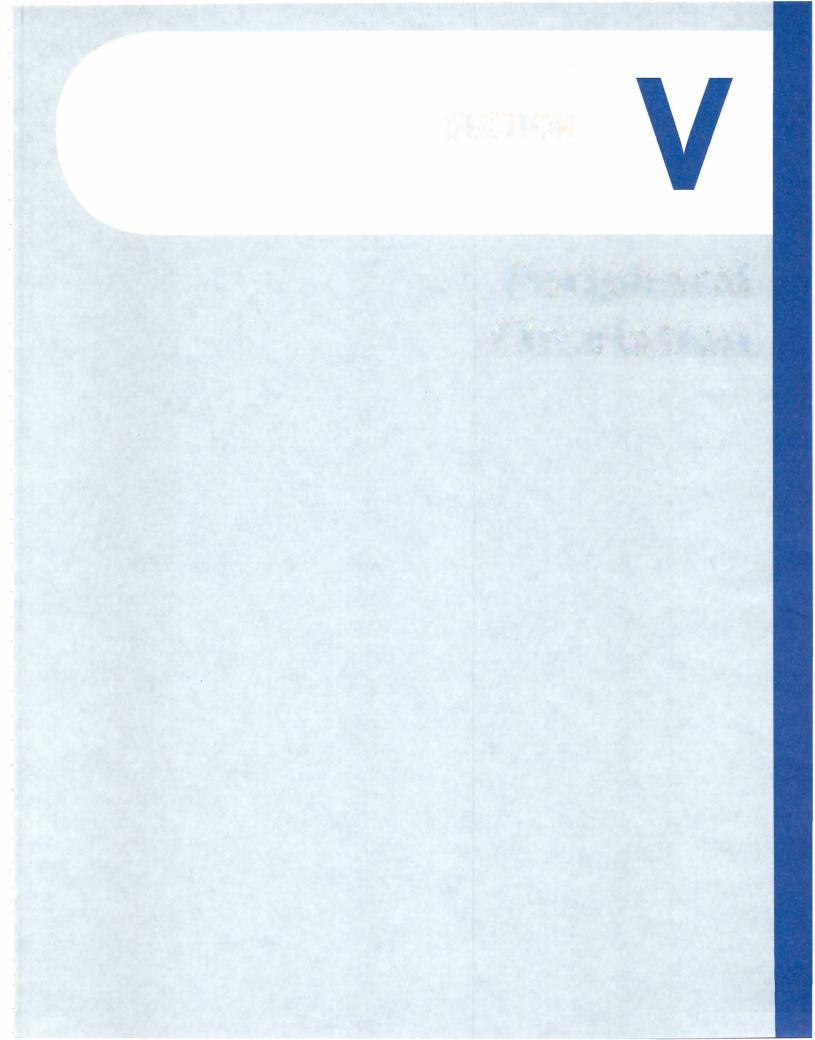
SECTION
Peripheral
Circulation

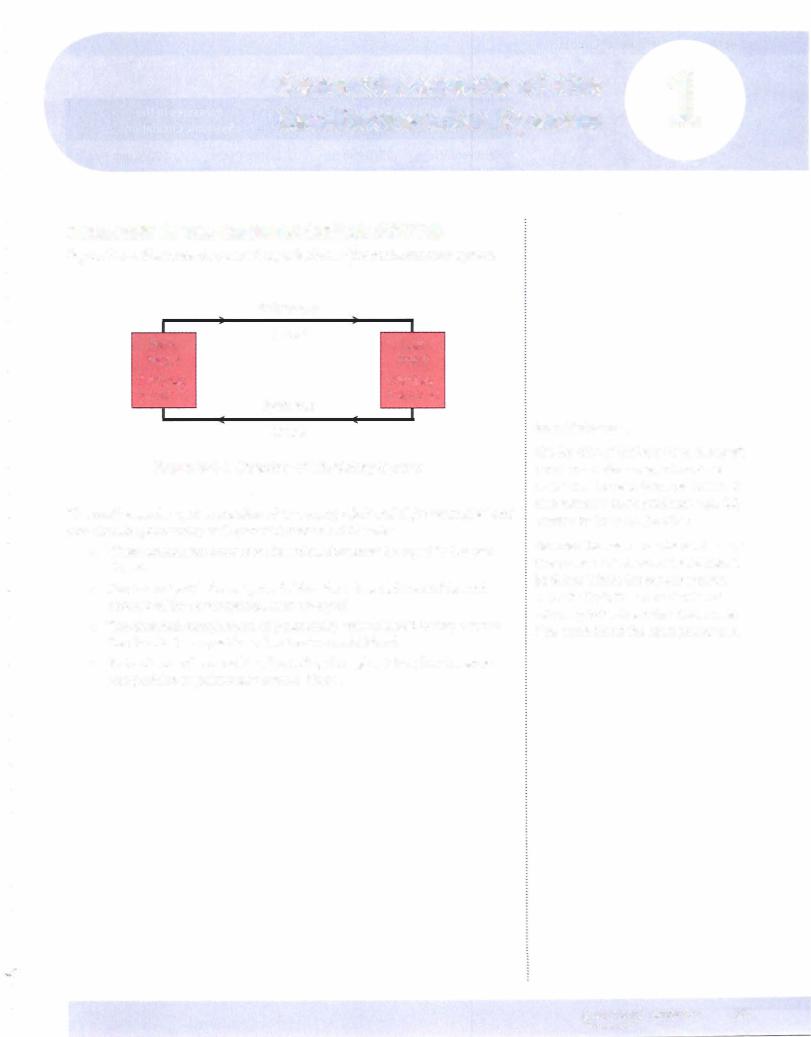
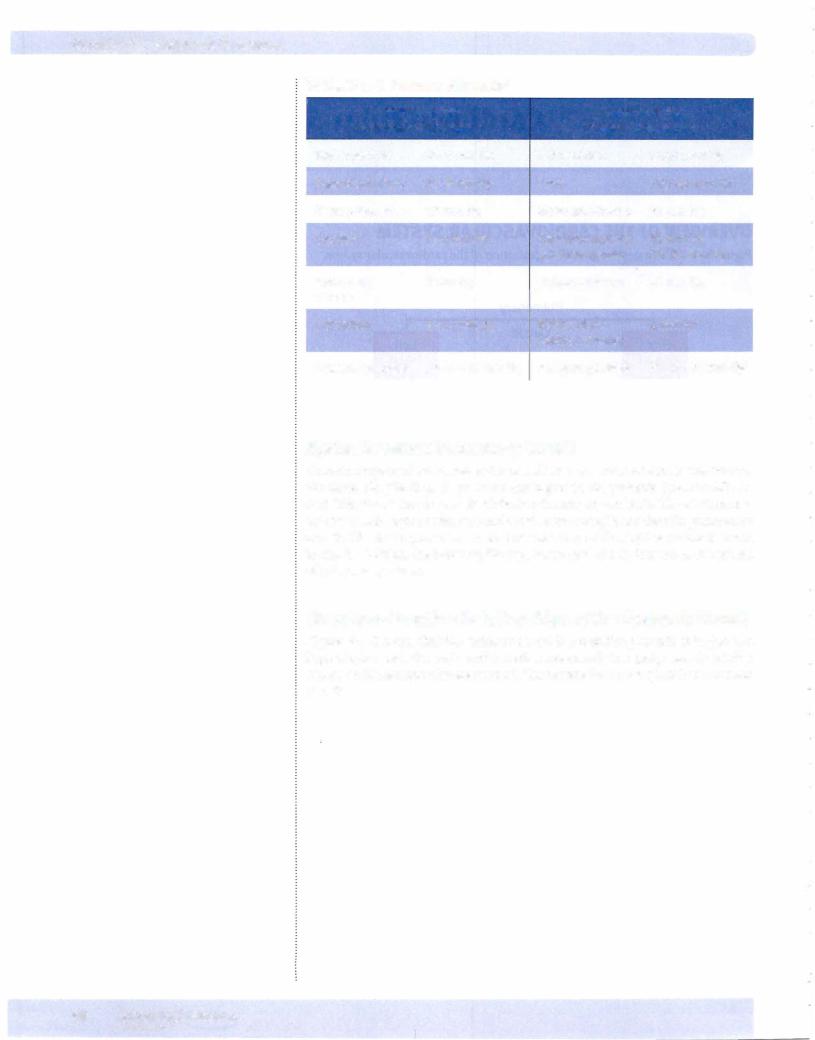
Section V • Peripheral Circulation
Table V-1-1. Pressure Differential
Pressures in the |
Pressures in the |
||
Pulmonary Circulation |
Systemic Circulation |
||
Right ventricle |
25/0 mm Hg |
Leftventricle |
120/0 mm Hg |
Pulmonary artery |
25/8 mm Hg |
Aorta |
120/80 mm Hg |
Mean pulm. art. |
1 5 mm Hg |
Mean art. blood p |
93 mm Hg |
Capillary |
7-9 mm Hg |
Capillary: skeletal |
30 mm Hg |
|
|
renal glomerular |
45-50 mm Hg |
Pulmonary |
5 mm Hg |
Peripheral veins |
15 mm Hg |
venous |
|
|
|
Left atrium |
5-10 mm Hg |
Right atrium |
O mm Hg |
|
|
(central venous) |
|
Pressure gradient |
1 5-5 = 10 mm Hg |
Pressure gradient |
93-0 = 93 mm Hg |
|
|
|
|
Systemicversus Pulmonary Circuit
Cardiac output andheart rate ofthe two circuits are equal, so stroke volumes are the same. Despite this, all pressures are higher in the systemic (peripheral) cir cuit. This shows that the vessels ofthe circuits are very different. The systemic cir cuit has much higher resistance and much lower compliance than the pulmonary circuit. The lower pressures mean that the work of the right ventricle is much lower. In addition, the lower capillary pressure protects against the development ofpulmonary edema.
Structure-Function Relationships ofthe Systemic Circuit
Figure V-1-2 shows that the systemic circuit is a branching circuit. It begins as a large single vessel, the aorta, and branches extensively into progressively smaller vessels until the capillaries are reached. Thereversethen takes place in thevenous circuit.
86 M EDICAL
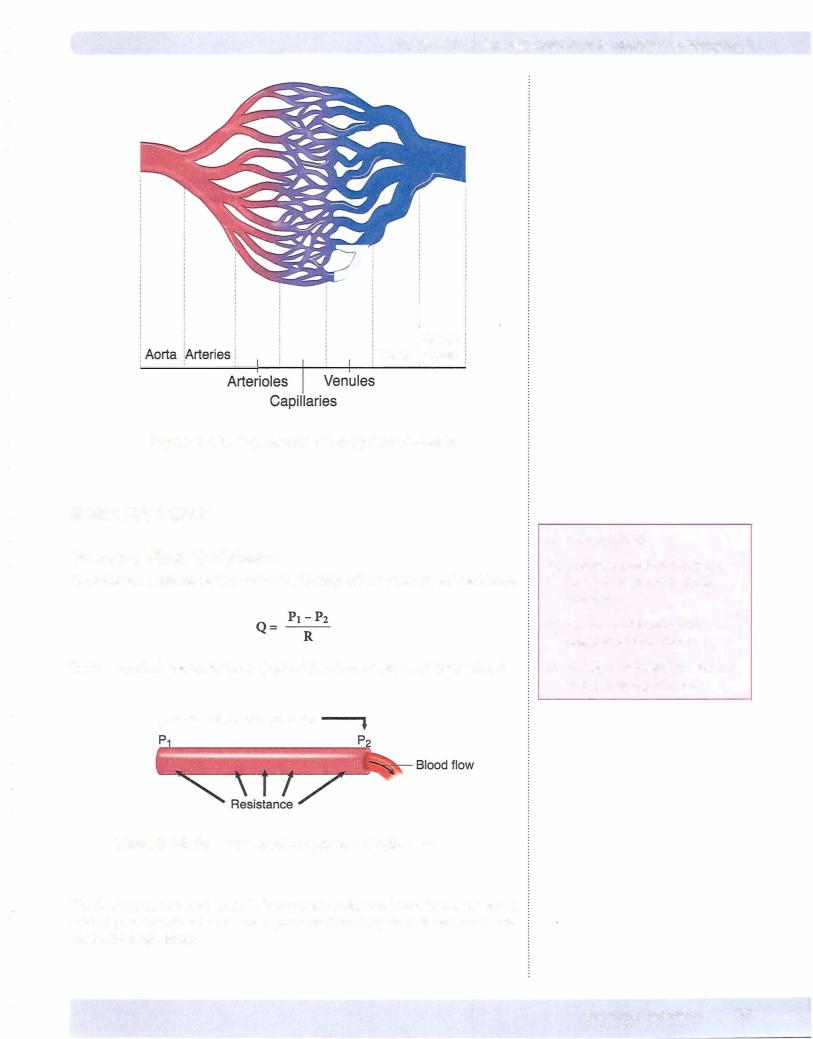
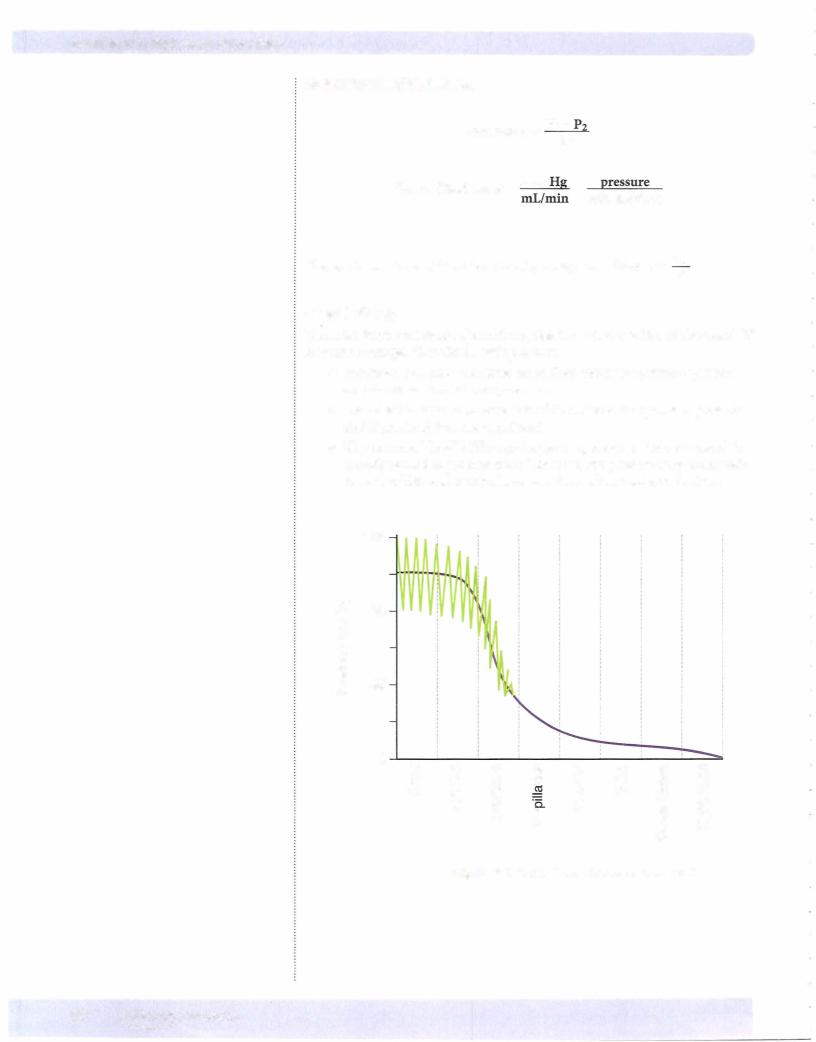

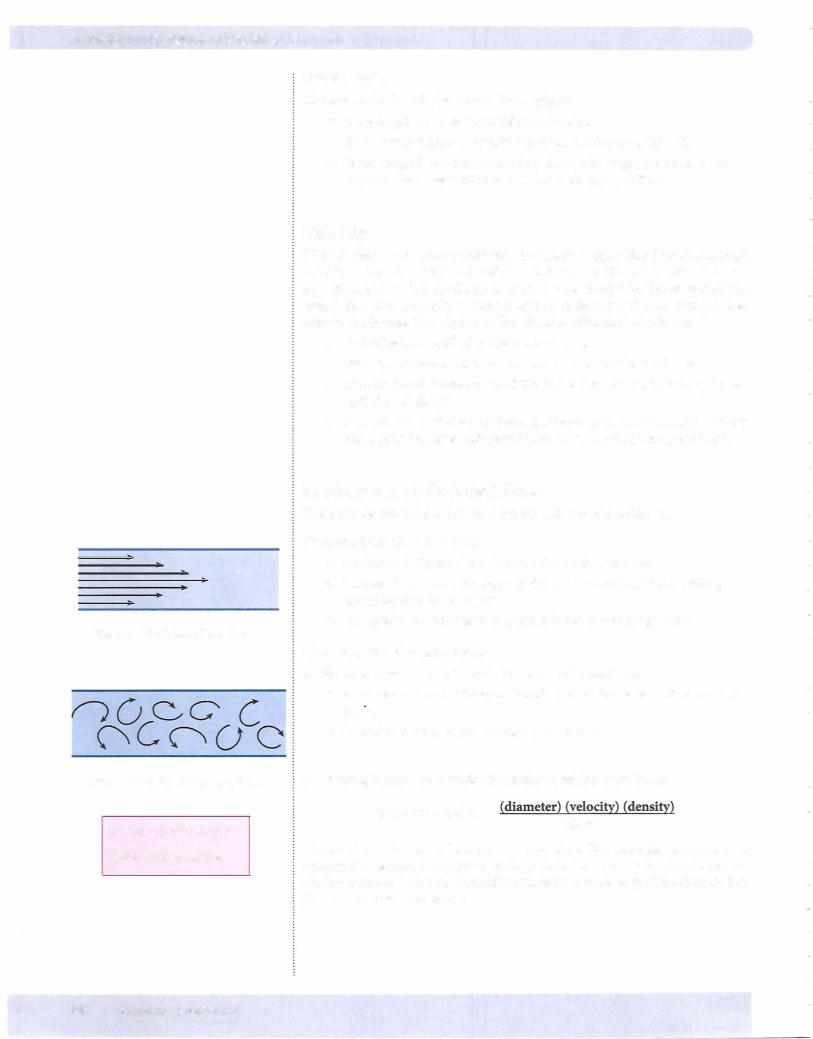
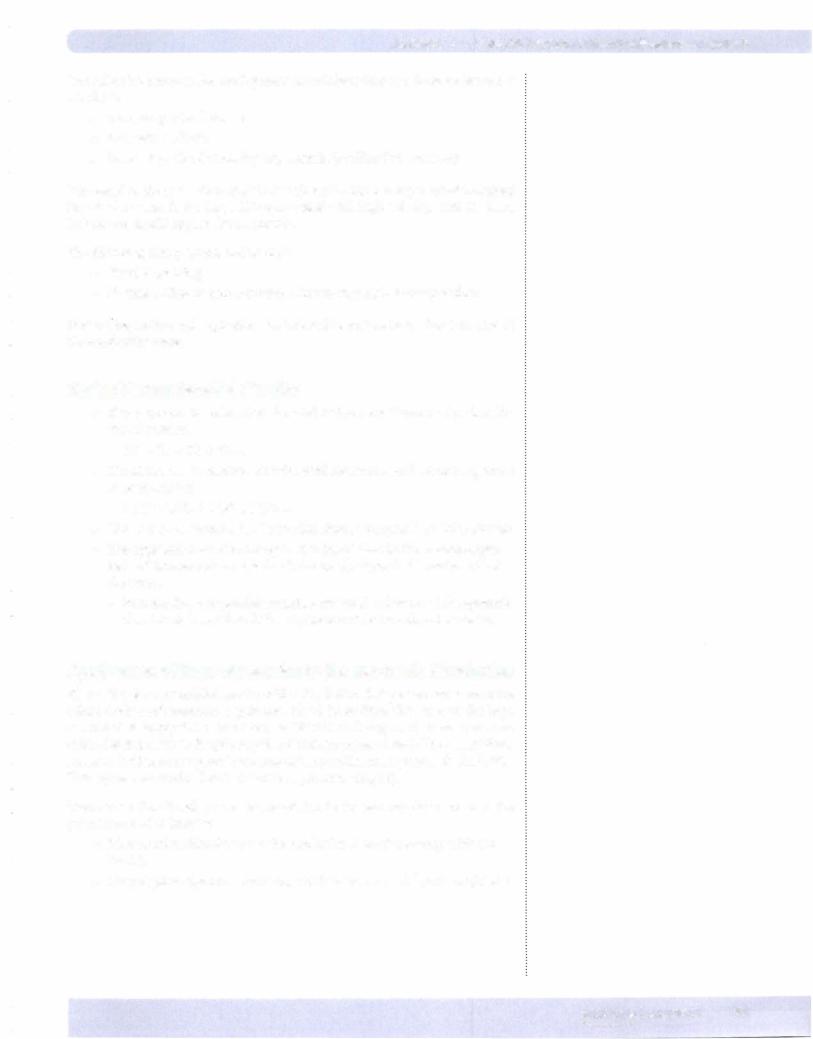
Chapter 1 • GeneralAspects of the Cardiovascular System
The following promote the development ofturbulent flow (i.e., increase Reynolds' number):
•Increasing tube diameter
•Increasing velocity
•Decreasing blood viscosity, e.g., anemia (cardiac flow murmer)
The vessel in the systemic circuit that is closest to the development ofturbulent flow is the aorta. It is a large-diameter vessel with high velocity. This is where turbulence should appear first in anemia.
The following also promote turbulence:
•Vessel branching
•Narrow orifice (severe stenosis)-due to very high velocity of flow
During inspiration and expiration, turbulent flow occurs in the large airways of the conducting zone.
SeriesVersus Parallel Circuits
•If resistors are in series, then the total resistance is the sum ofeach indi vidual resistor.
RT = Rl + R2 + R3...
•Ifresistors are in parallel, then the total resistance is added as reciprocals of each resistor.
l/RT = l/Rl + l/R2 + l/R3...
• Thus, total resistance is less in parallel circuits compared to series circuits.
• The application of this concept is that blood flow to the various organ beds of the systemic circulation is the result of parallel branches off of the aorta.
- Because they are parallel branches, the total resistance ofthe systemic circulation is less than if the organs were in series bloodflow-wise.
Application of Hemodynamics to the Systemic Circulation
Figure V-1-8 is a simplified model ofthe circulation that we can use to examine whole-body cardiovascular regulation. Blood flows from the aorta to the large arteries that supply the various organs. Within each organ, there are muscular arterioles that serve as the primarysite ofresistance (see above). The sum ofthese resistors (added as reciprocals because ofthe parallel arrangement) is TPR/SVR. This represents afterload to the heart (see previous chapter).
There are 2 functional consequences related to the fact arterioles serve as the primarysite of resistance:
•They regulate blood flow to the capillaries (site of exchange with the tissue).
•They regulate upstream pressure, which is mean arterial pressure (MAP).
MEDICAL 91
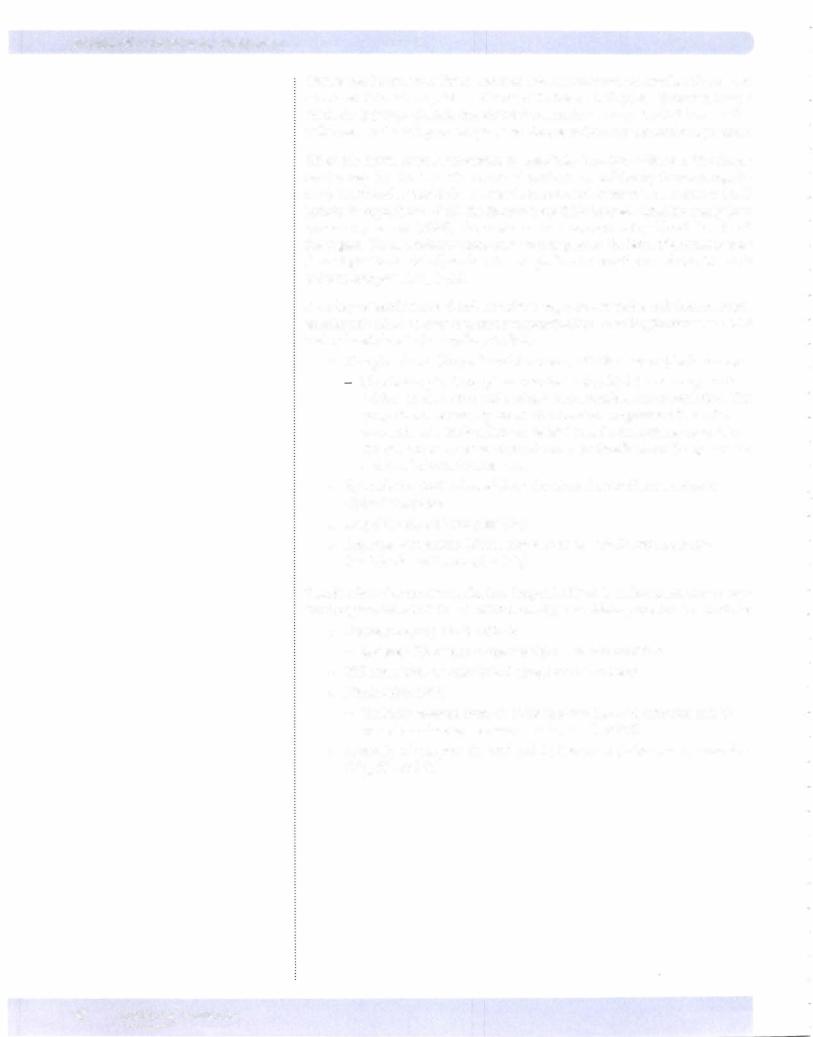
Section V • Peripheral Circulation
92 MEDICAL
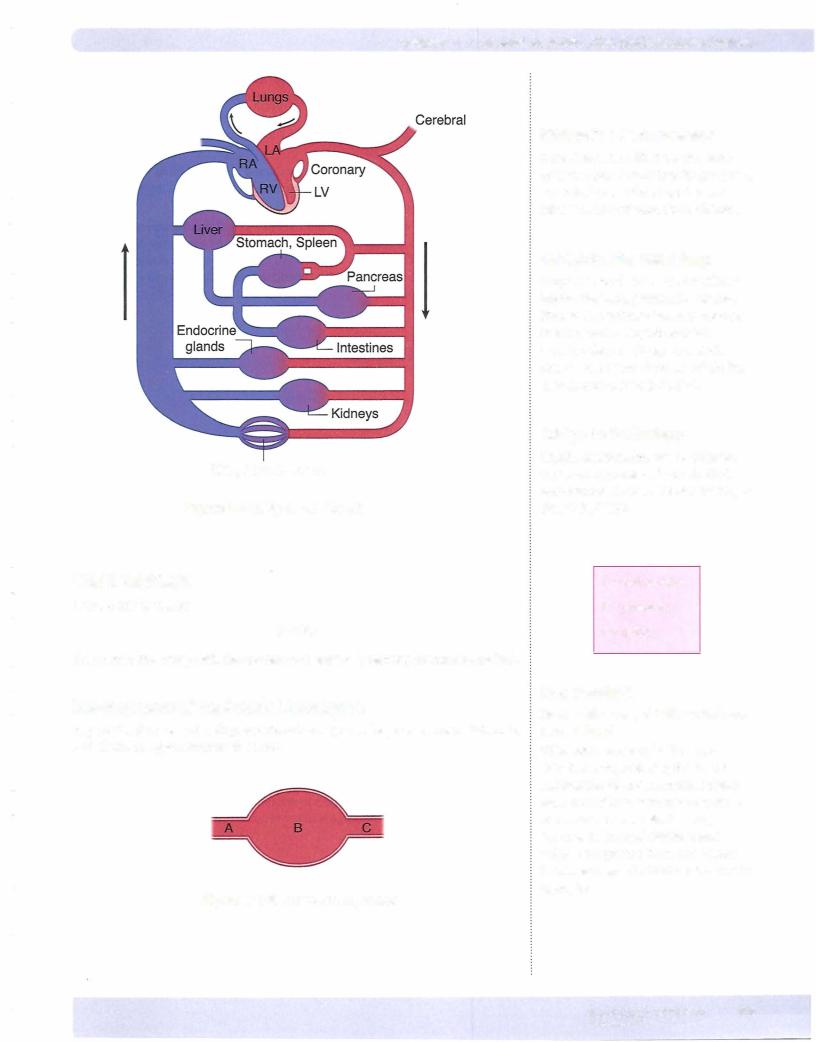
Chapter 1 • GeneralAspects of the Cardiovascular System
Skin, Muscle, Bone
Figure V-1-8. Systemic Circuit
WALL TENSION
LaPlace relationship:
T o ePr
The aortais thearterywith the greatestwalltension (greatestpressure and radius).
Development ofan ArterialAneurysm
Figure V- 1-9 shows a developing arterial aneurysm. The pressures at points A, B, and C will be approximately the same.
Figure V-1-9. Aortic Enlargement
Bridge to Pharmacology
Drugs that mimic NE cause the same cardiovascular effects that NE produces. These include alpha-1 agonists, NE releasers, and NE reuptake inhibitors.
Bridge to Pharmacology
Drugs that block NE's vascular effects (alpha blockers), prevent NE release, liberate NO, activate beta-2 receptors, block calcium entry into smooth muscle cells, and/or open smooth muscle potassium channels mimic the vasodilatory effects indicated.
Bridge to Pathology
Sepsis, anaphylaxis, and neurogenic shock are examples of uncontrolled vasodilation in the periphery, leading to diminished MAP.
T = wall tension
P = pressure
r = radius
In a Nutshell
Heart with a dilated left ventricle vs. normal heart
If the aortic pressure is the same in both hearts, following the law of
LaPlace the dilated heart must create greater tension to overcome the same aortic pressure and eject blood, because its internal diameter and volume are greater. Thus, the dilated heart exerts greater total tension on the myocytes.
MEDICAL 93
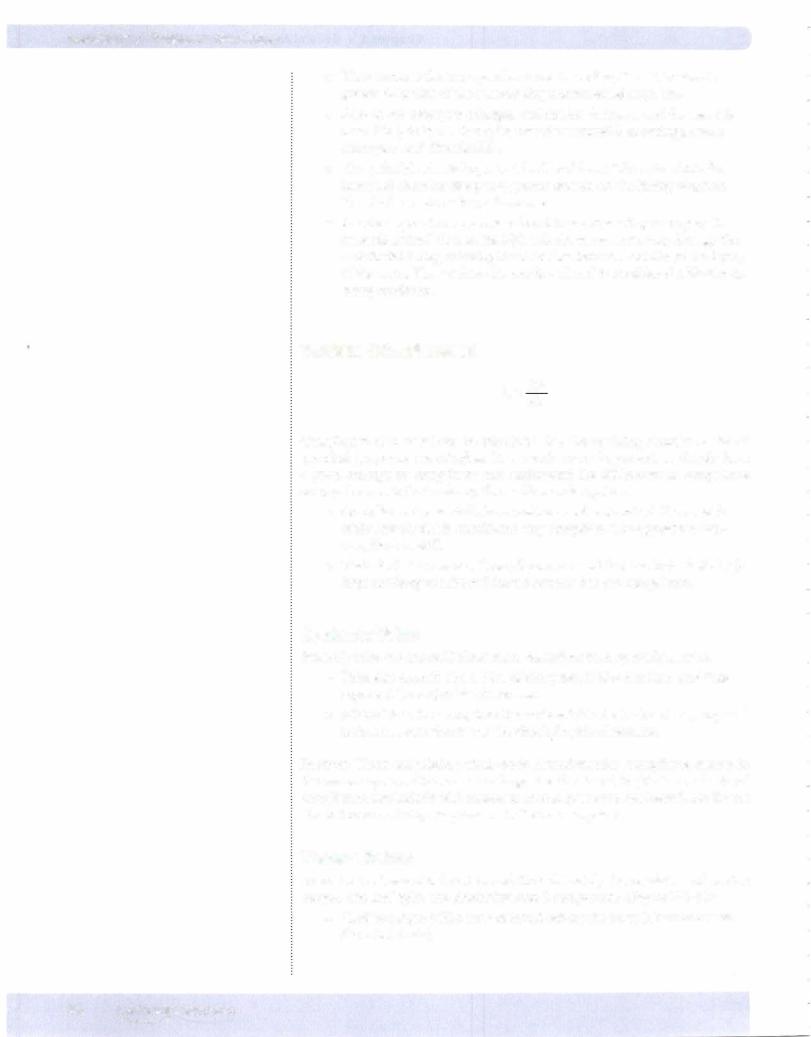
Section V • Peripheral Circulation
•Thus, because the aneurysm has a greater radius, its wall tension is greater than that of the surrounding normal vessel segments.
•Also, as the aneurysm enlarges, wall tension increases and the vessel is more likely to burst. Examples are subarachnoid hemorrhage, aortic aneurysm, and diverticulitis.
•This principle also is important in dilated heart failure, in which the increased chamber size places greater tension on the failing ventricle. This further reduces its performance.
•Another type of aneurysm is referred to as a dissecting aneurysm. In systemic arterial disease, the high velocity in the aorta may damage the endothelial lining, allowing blood to flow between and dissect the layers of the aorta. This weakens the aortic wall and is considered a life-threat ening condition.
VESSEL COMPLIANCE
C = !lV!lP
Compliance of a vessel can be calculated, but the resulting number is, for all practical purposes, meaningless. It is much more important to simply have a good concept of compliance and understand the differences in compliance among the vessels that make up the cardiovascular system.
•Compliance is essentially how easily a vessel is stretched. If a vessel is easily stretched, it is considered very compliant. The opposite is non compliant or stiff.
•Elasticity is the inverse of compliance. A vessel that has high elasticity (a large tendency to rebound from a stretch) has low compliance.
SystemicVeins
Systemic veins are about 20 times more compliant than systemic arteries.
•Veins also contain about 70% of the systemic blood volume and thus represent the major blood reservoir.
•If blood is in the veins, then it is not available for the heart to pump and is thus not contributing to the circulating blood volume.
In short: When considering whole-body hemodynamics, compliance resides in the venous system. One must not forget the functional implications of arterial compliance, particularly with respect to arterial pressures (see below), but for the circulation as a whole, compliance is in the venous system.
Venous Return
To understand vascular function and thus ultimately the regulation of cardiac output, one can "split" the circulation into 2 components (Figure V- 1 - 10):
•Cardiac output (CO): flow of blood exiting the heart (down arrow on the arterial side).
94 M EDICAL
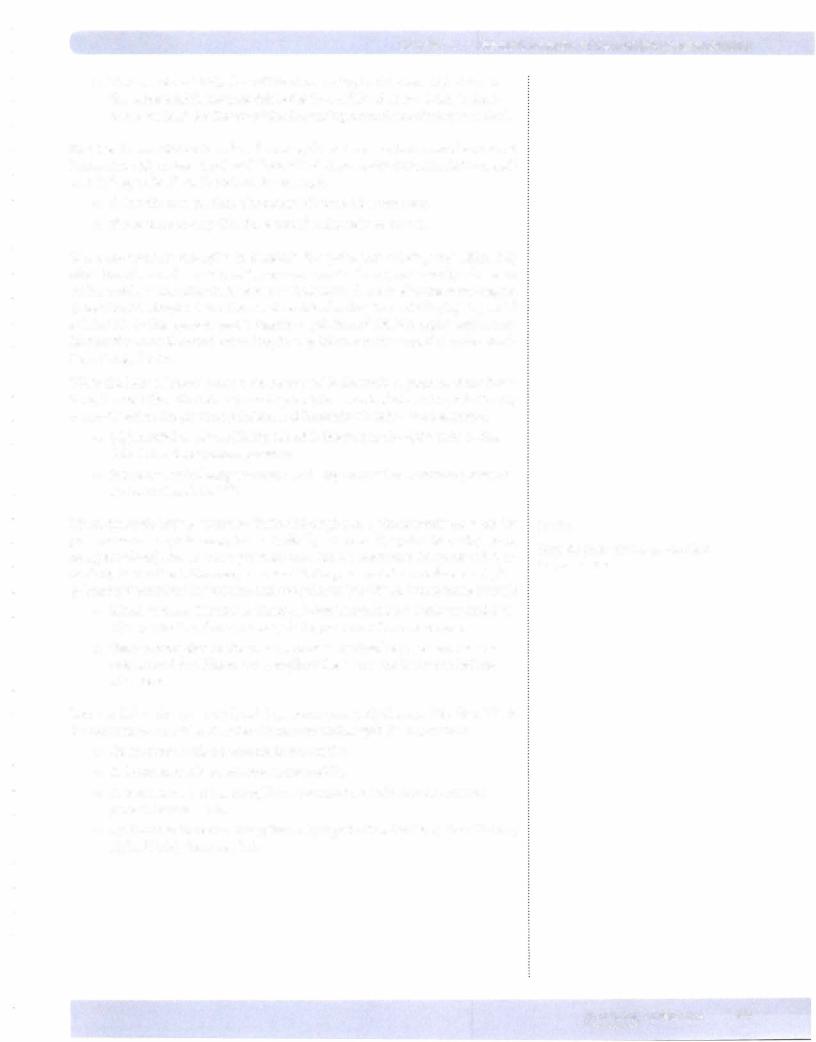
Chapter 1 • GeneralAspects of the cardiovascular System
•Venous return (VR): flow ofblood returning to the heart (up arrow on the venous side). Because this is the flow ofblood to the heart, it deter mines preload for the ventricles (assuming normal ventricular function).
Because the circulation is a closed system, these flows are intertwined and must be the same when one examines it"overtime" or at steady-state. In addition, each flow is "dependent" on the other. For example:
•If CO fell to zero, then ultimatelyVR would become zero.
•If one were to stop VR, there would ultimately be no CO.
These are extreme examples to illustrate the point that altering one ultimately alters the other and a variety of factors can transiently or permanently alter each ofthevariables, resulting in the other variable beingimpacted to the same degree. In Section IV, chapter 1, we discussed ventricular function, whichplays a pivotal role in CO. In this section, we discuss the regulation ofVR. VRrepresents vascu lar function and thus understanding its regulation sets the stage for understand ing CO regulation.
VR is the flow of blood back to the heart and it determines preload. Since it is a flow,it must follow the hemodynarnicprinciples describedabove,i.e., it is directly proportional to the pressure gradient and inversely related to the resistance.
•Right atrialpressure (RAP):blood is flowing to the right atrium, thus RAP is the downstream pressure.
•Mean systemic fillingpressure (Psf): represents the upstream pressure (pressure head) forVR.
Mean systemic fillingpressure (Psf): Although not a "theoretical" pressure (as per numerous experiments, Psf is typically -7 mm Hg prior to endogenous compensations), this is not a pressure that can be conveniently measured, par ticularly in a patient. However, because it is the pressure when no flow exists, it is primarily determined byvolume and compliance (seeVessel Compliance above):
•Blood volume: There is a direct relation between blood volume and Psf. The greater the blood volume, the higher the Psf and vice versa.
•Venous compliance: There is an inverse relation between venous com pliance and Psf. The more compliant the veins, the lower the Psf and vice versa.
Because Psf is the pressure head (upstream pressure) driving VR, then VR is directly related to Psf. If allother factors are unchanged, it follows that:
•An increase in blood volume increases VR.
•A decrease in blood volume decreases VR.
•A decrease in venous compliance (sympathetic stimulation; muscle
pump) increases VR.
• An increase in venous compliance (sympathetic inhibition; venodilators; alpha block) decreases VR.
Note
Engaging the muscle pump also increases Psf.
MEDICAL 95
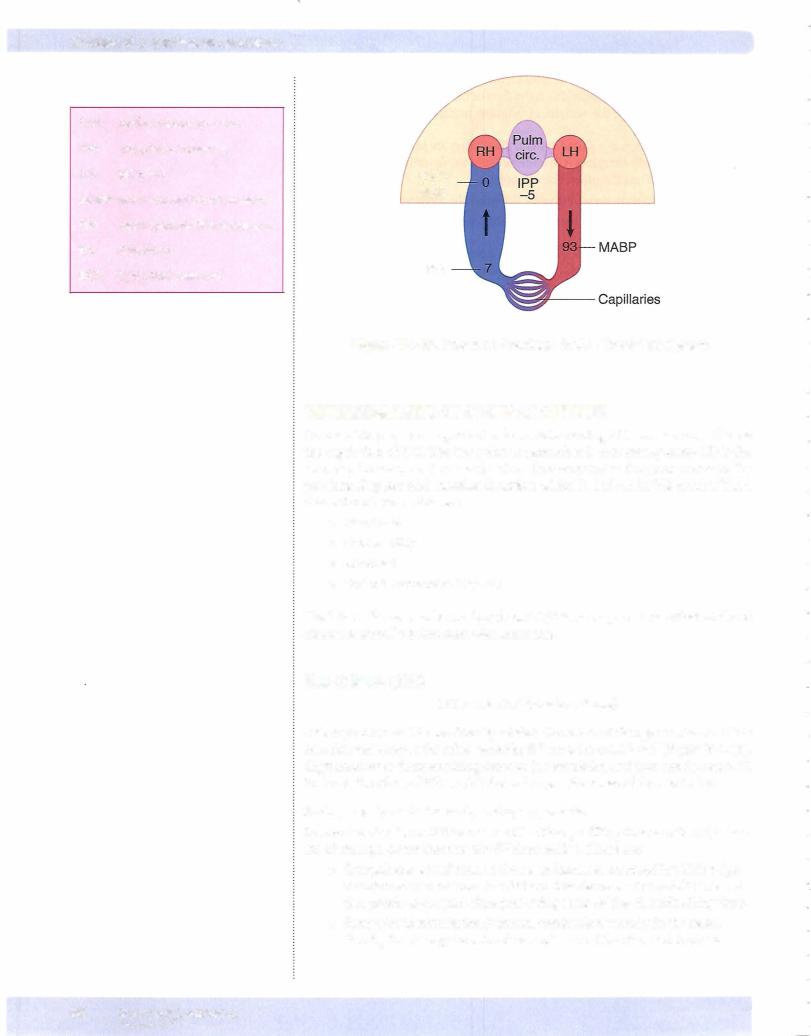
Section V • Peripheral Circulation
CVP: |
central venous pressure |
IPP: |
intrapleural pressure |
LH: |
left heart |
MABP: mean arterial blood pressure
Psf: |
mean systemic filling pressure |
RH: |
right heart |
RAP: |
right atrial pressure |
CVP/
RAP
Psf
Figure V-1-10. Pressure Gradients in the Circulatory System
DETERMINANTS OF CARDIAC OUTPUT
Because VR plays an important role in determining CO, we can now discuss the regulation of CO. The key point to remember is that steady-state CO is the interplay between ventricular function (see ventricular function curves in the previous chapter) and vascular function, which is defined by VR curves. The 4 determinants are as follows:
•Heart rate
•Contractility
•Afterload
•Preload (determined by VR)
The latter 3 factors can be combined on CO/VR curves, which are illustrated and discussed later. Let's first start with heart rate.
Heart Rate (HR)
CO = HR x SV (stroke volume)
Although HR and CO are directly related, the effect of changes in HR on CO is complicated because the other variable, SV must be considered (Figure V- 1 - 1 1). High heart rates decrease filling time for the ventricles, and thus can decrease SV. In short, the effect of HR on CO depends upon the cause ofthe rise in HR.
Endogenouslymediated tachycardia,e.g., exercise
In exercise, the rise in HR increases CO. Although filling time is reduced, a vari ety of changes occur that prevent SV from falling. These are:
• Sympathetic stimulation to the heart increases contractility. This helps maintain stroke volume. In addition, this decreases the systolic interval (see previous chapter) thus preserving some of the diastolic filling time.
•Sympathetic stimulation increases conduction velocity in the heart, thereby increasing the rate of transmission of the electrical impulse.
96 MEDICAL
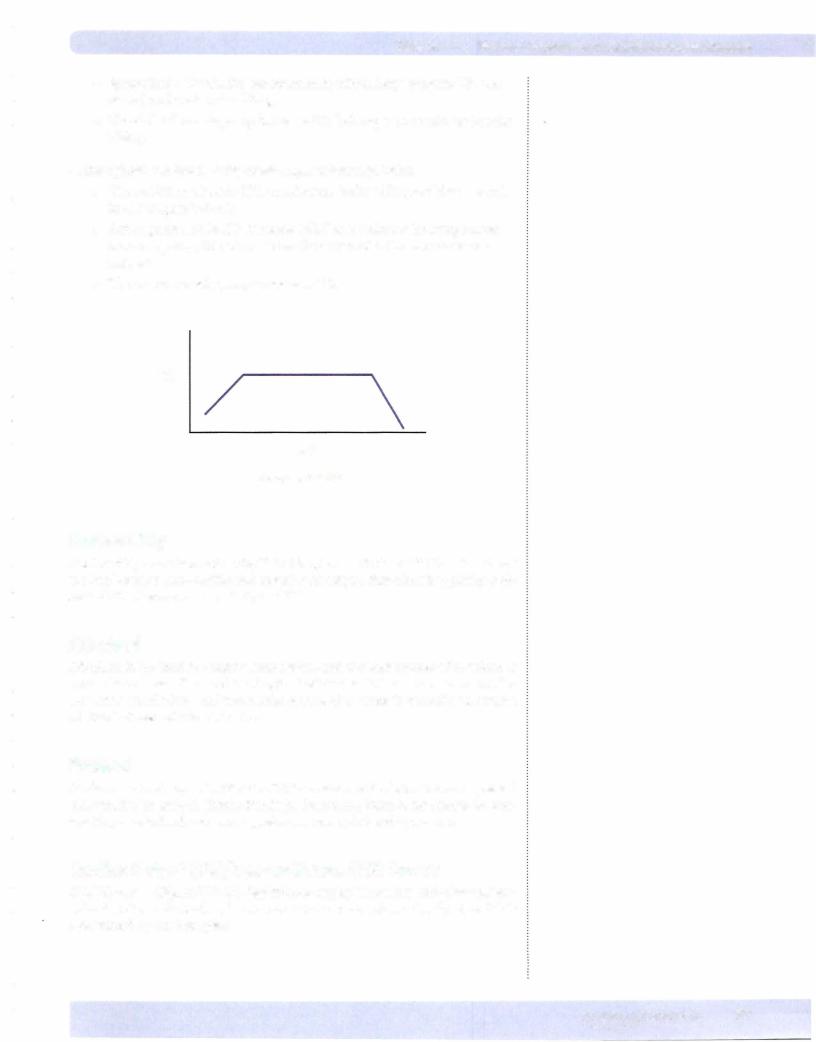
Chapter 1 • GeneralAspects of the Cardiovascular System
•Sympathetic stimulation venoconstricts, which helps preserve VR (see above) and ventricular filling.
•The skeletal muscle pump increasesVR, helping to maintain ventricular filling.
Pathologically mediated tachycardia,e.g.,tachyarrhythmias
•The sudden increase in HR curtails ventricular filling resultingafallin in CO (Figure V-1-11).
•Although the fall in CO decreases MAP and activates the sympathetic nervous system, this occurs "after the fact" and is thus unable to com pensate.
•There is no muscle pump to increase VR.
co
HR
Figure V-1-11
Contractility
Contractility was discussed in depth in Chapter 1 ofSection IV. There is a direct relation between contractility and ventricular output, thus there is typically a di rect relation between contractilityand CO.
Afterload
Afterload is the load the heart works against and the best marker of afterload is TPR. This was also discussed in Chapter 1 ofSection IV. There is an inverse rela tion between afterload and ventricular output, thus there is generally an inverse relation between afterload and CO.
Preload
As discussedin Chapter 1 ofSection IV, there is a direct relation between preload and ventricular output (Frank-Starling). Presuming there is no change in con tractility or afterload, increasing preload increases CO and vice versa.
Cardiac Output (CO)/Venous Return (VR) Curves
CO/VR curves (Figure V-1-12) depict the interplay between ventricular and vas cular function indicated in the venous return section above. Steady-state CO is determined bythis interplay.
MEDICAL 97

Section V • Peripheral Circulation
A = steady-state cardiac output
All individuals operate at the intersection ofthe ventricular function and venous return curves.
B = mean systemic filling pressure (Pst)
This is directly related to vascular volume and inversely related to venous compliance.
Ventricularfunction (solid line ofFigure V-1-12)
•X-axis is RAP, a marker ofpreload.
•Y-axis is CO.
•Thus, this curve is the same as depicted in Figures N-1-3 and IV-1-4 and it defines ventricular function.
•This curve shows that RAP has a positive impact on CO (Frank-Starling mechanism)
Vascularfunction (dashed line ofFigure V-1-12)
•X-axis is RAP, the downstream pressure forVR.
•Y-axis is VR.
•The curve shows that as RAP increases, VR decreases. This is because RAP is the downstream pressure for VR. As RAP increases, the pressure gradient for VR falls, which in turn decreases VR. Thus, RAP has a nega tive impact on VR.
•X-intercept for the VR curve is Psf (point B on the graph). This is the pressure in the circulation when there is no flow (see section on venous
return). Psf is the pressure head (upstream pressure) forVR. Thus, when RAP = Psf, flow (VR) is zero.
Steady-state CO
•The intersection of the ventricular and vascular function curves deter mines steady-state CO (point A in Figure V-1-12). In other words, point A represents the interplay between ventricular and vascular function.
•Discounting HR, the only way steady-state CO can change is ifventricu lar function, or vascular function, or both change.
CONR
Right Atrial Pressure (RAP)
Figure V-1-12
98 MEDICAL

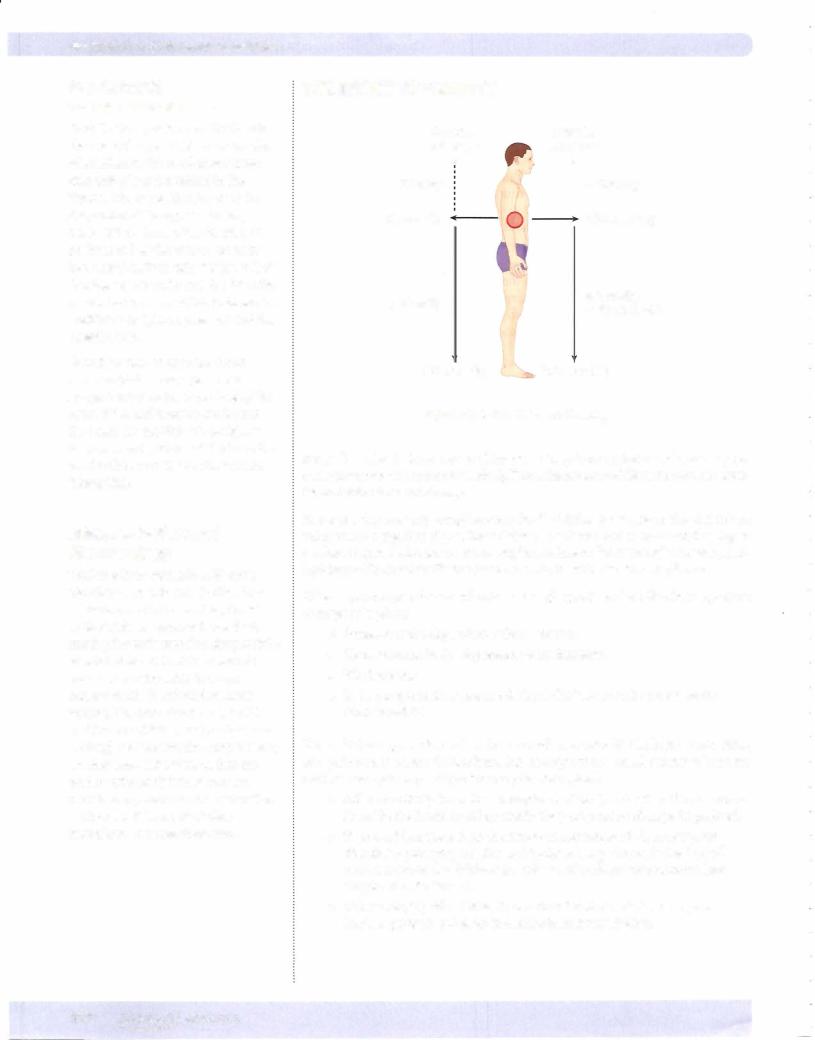
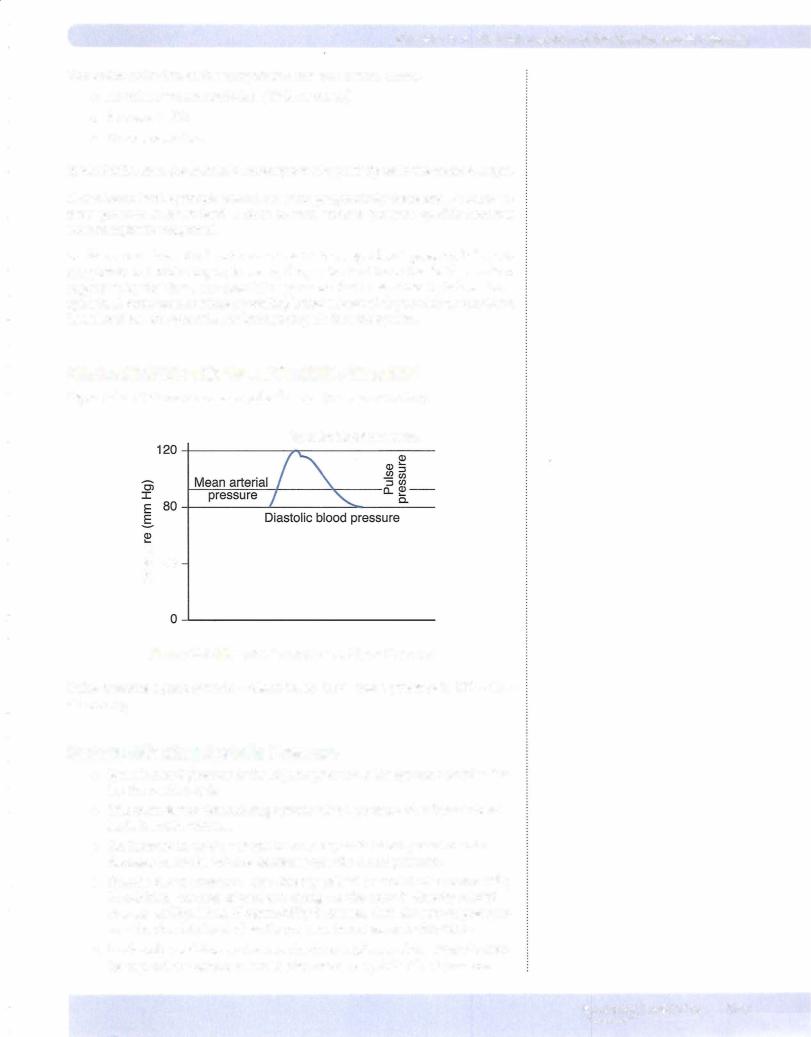
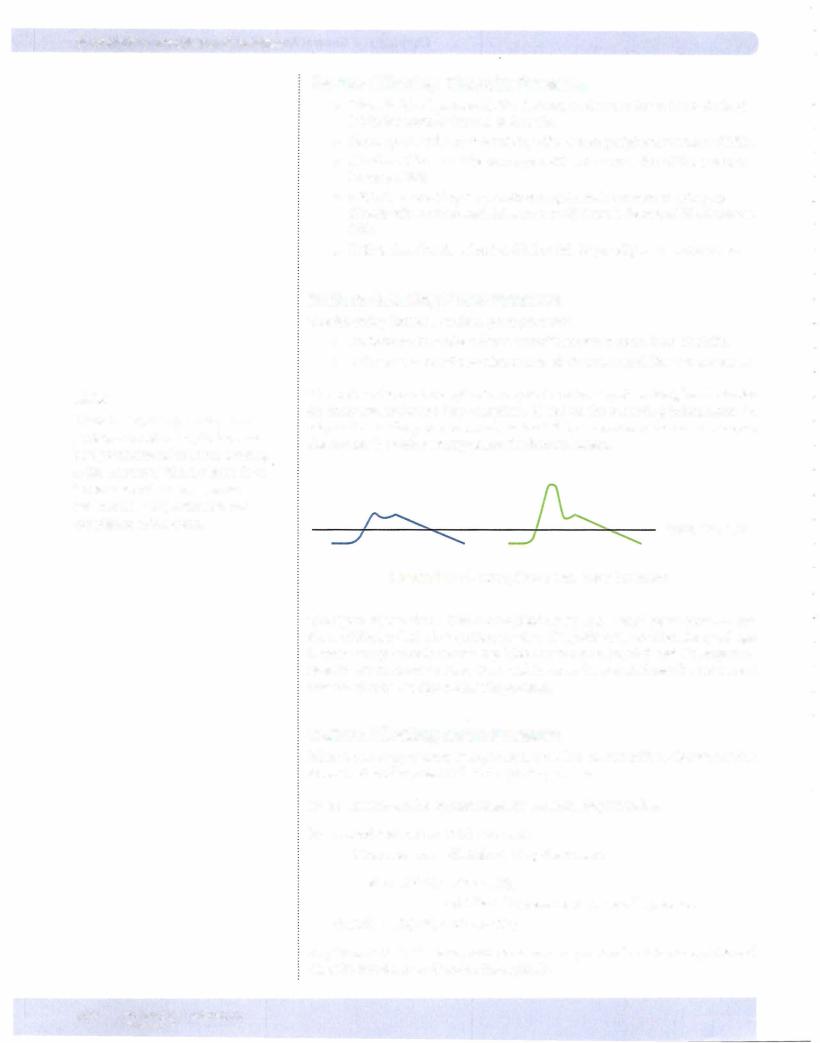
Section V • Peripheral Circulation
Factors Affecting Diastolic Pressure
•Diastolic blood pressure (DBP) is directly related to the volume of blood left in the aorta at the end of diastole.
•One important factor determining DBP is total peripheral resistance (TPR).
•Dilation ofthe arterioles decreases DBP and constriction of the arterioles increases DBP.
•HR is the second key factor influencing diastolic pressure and they are directly related: increased HR increases DBP, while decreased HR decreases DBP.
•DBP is also directly related to SV, but this is typically not a major factor.
Note
Theoretically, the systemic pulse pressure can be conceptualized as being proportional to stroke volume, or the amount of blood ejected from the left ventricle during systole, and inversely proportional to the compliance ofthe aorta.
Factors Affecting Pulse Pressure
The following increase (widen) pulse pressure:
•An increase in stroke volume (systolic increases more than diastolic)
•A decrease in vessel compliance (systolic increases and diastolic decreases)
The aorta is the most compliant artery in the arterial system. Peripheral arteries are more muscular and less compliant. Based on the preceding information, in Figure V-1-16 the pressure record on the left best represents the aorta, whereas the one on the right best represents the femoral artery.
- ---=-----1.....(L----="-- |
||
_/ |
""' |
.....Mean pressure |
-- |
|
|
Figure V-1-1 6. Compliance and Pulse Pressure
The figure demonstrates that a compliant artery has a small pulse pressure and that a stiffartery has a large pulse pressure. Also, pulse pressure increases with age because compliance is decreasing. This can produce isolated systolic hyperten sion, in which mean pressure is normal because the elevated systolic pressure is associated with a reduced diastolic pressure.
Factors Affecting Mean Pressure
Mean pressure is pressure averaged over time. It is not the arithmetic mean and is closer to diastolic pressure than to systolic pressure.
Mean pressure can be approximated by the following formulas:
For a blood pressure of 120/80 mm Hg:
Mean pressure = diastolic + 1/3 pulse pressure
80 + 1/3(40) = 93 mm Hg
= 2/3 diastolic pressure + 1/3 systolic pressure
2/3(80) + 1/3(120) = 93 mm Hg
Any formula that calculates mean pressure must give a value between systolic and diastolic but closer to diastolic than systolic.
102 MEDICAL
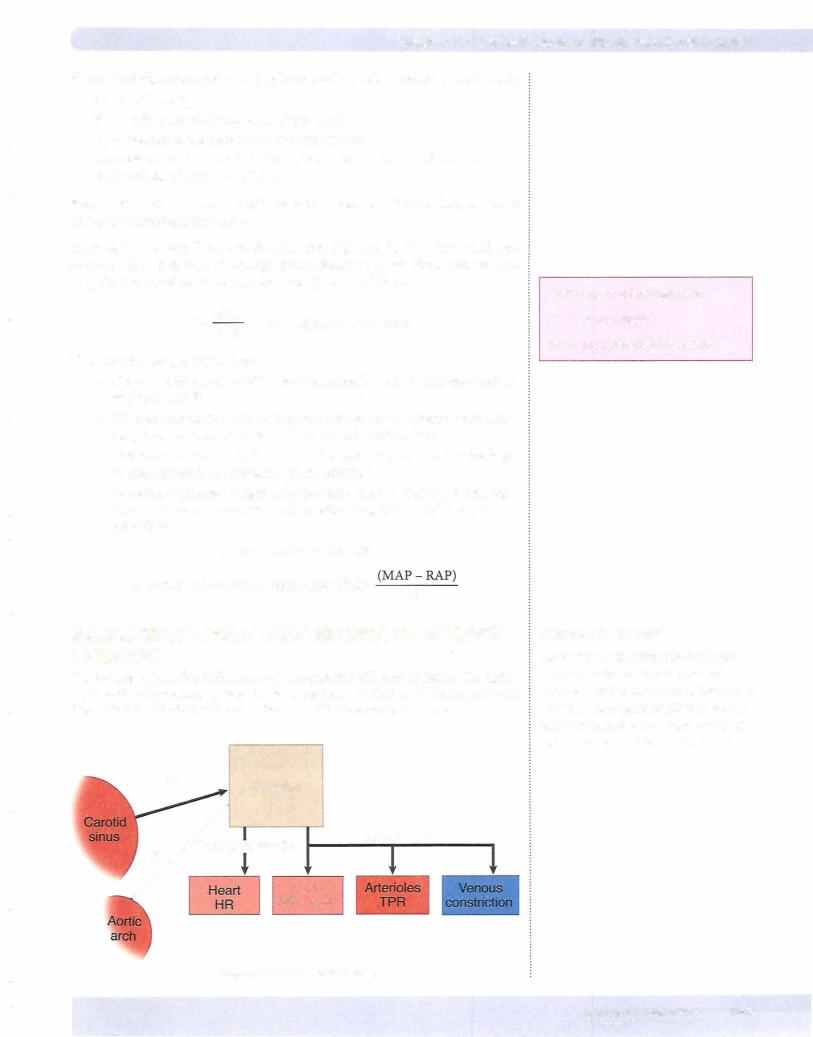
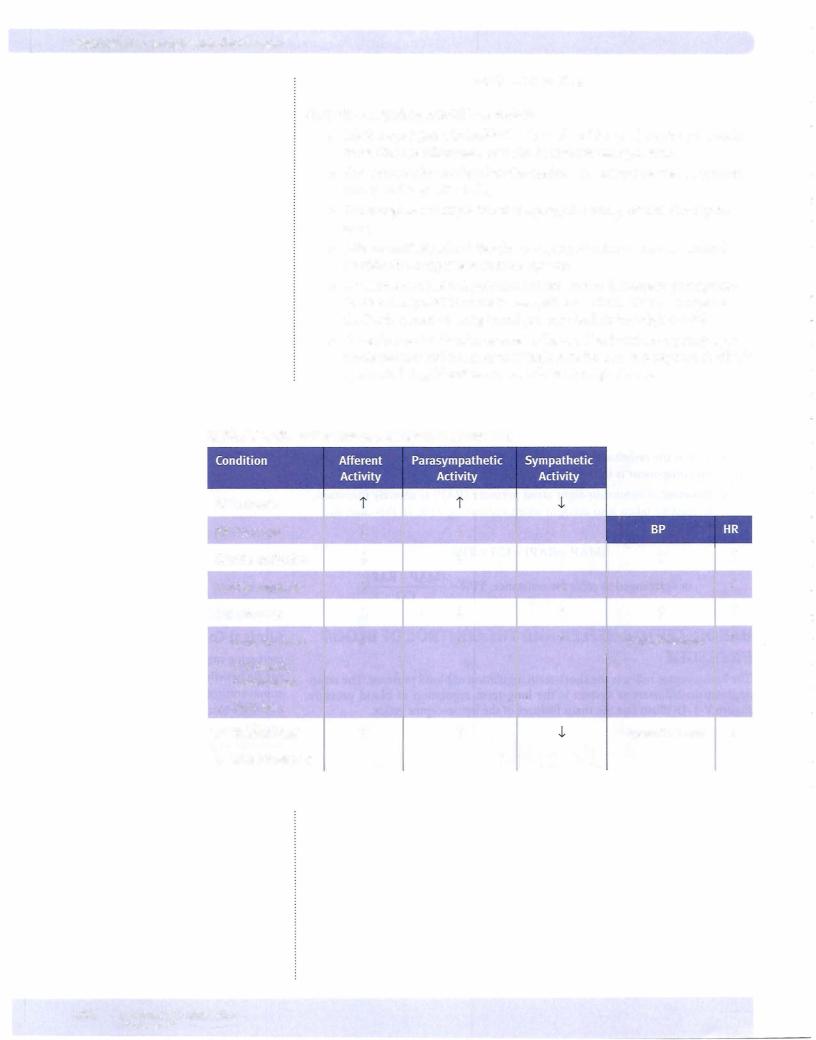
Section V • Peripheral Circulation
MAP=CO x TPR
Key points regarding arterial barorectors:
•Mechanoreceptors irnbedded in the walls of the aortic arch and carotid sinus that are stimulated by a rise in intravascular pressure.
•Afferent activity is relayed to the medulla via cranial nerves IX (carotid sinus) and X (aortic arch).
•Baroreceptor activity exists at the person's resting arterial blood pres sure.
•Afferent activity stimulates the parasympathetic nervous system and inhibits the sympathetic nervous system.
•A fall in arterial blood pressure evokes a reflex decrease in parasympa thetic activity and increase in sympathetic activity. This is a negative feedback system to bring blood pressure back to its original level.
•A rise in arterial blood pressure evokes a reflex increase in parasympa thetic activity and fall in sympathetic activity. This is a negative feedback system to bring blood pressure back to its original level.
Table V-1-2. Reflex Changes for Specific Maneuvers
BP increase |
|
|
|
|
|
|
|
BP decrease |
J. |
J. |
i |
i |
|
i |
|
Carotid occlusion |
J. |
J. |
i |
|
|||
|
|||||||
Carotid massage |
i |
i |
J. |
J. |
|
J. |
|
Cut afferents |
J. |
J. |
i |
i |
|
i |
|
• |
Lying to stand |
J. |
J. |
i |
i toward normal |
|
i |
• |
Orthostatic |
|
|
|
|
|
|
|
|
|
|
|
|
||
|
|
|
|
|
|
||
• |
hypotension |
|
|
|
|
|
|
Fluid loss |
|
i |
|
-1. toward normal |
|
J. |
|
• |
Volume load |
i |
|
|
|||
• |
Weightlessness |
|
|
|
|
|
|
104 MEDI CAL

Chapter 1 • General Aspects of the Cardiovascular System
Chapter Summary
•The cardiovascular system consists oftwo circuits and two pumps connected in series.
•Systemic pressure decreases slightly through the arteries, decreases markedly through the arterioles, and then decreases only slightly more through the major veins. The loss of pressure is determined by regional resistance.
•The cross-sectional area increases from a minimum in the aorta to a maximum in the capillaries. Velocity ofthe blood is inversely related to a region's cross-sectional area.
•The main blood reservoir is the systemic veins.
•Ofthe factors affecting a vessel's resistance, radius is the most important. The radius ofthe arterioles determines total peripheral resistance.
•The cardiovascular system is a laminar flow system. The factors that promote turbulence include decreased fluid viscosity, large-diameter tubes, increased fluid velocity, and vessel branching.
•Psf is the pressure-head driving VR. It is directly related to blood volume and inversely related to venous compliance.
•Ifventricular function is normal, VR determines preload.
•CO is determined by HR, contractility, afterload, and preload. It is the interplay ofventricular and vascular function.
•Ventricular function curves describe ventricular function, while VR curves illustrate vascular function.
•Structures connected in series produce high resistance, and flow is dependent and equal atall points.
•Mean arterial pressure is determined only by the circulating blood volume (cardiac output) and the resistance ofthe arterioles.
•Vessel wall tension is directly proportional to pressure and radius.
•The aorta is the most compliant artery, but veins are more compliant than arteries.
•Gravity causes the pooling of blood in the dependent veins. This blood does not contribute to cardiac output.
•The baroreceptor reflex alters parasympathetic and sympathetic outflow to minimize acute changes in blood pressure.
MEDICAL 105




Chapter 2 • Regulation of Blood Flow and Pressure
Organ X
Arterial |
Venous |
Figure V-2-2. Application of the Fick Principle
BLOOD FLOW REGULATION
Flow is regulated by constricting and dilating the smooth muscle surrounding the arterioles.
Intrinsic Regulation (Autoregulation)
The control mechanisms regulating the arteriolar smooth muscle are entirely within the organ itself.
•What is regulated is blood flow, not resistance. It is more correct to say that resistance is changed in order to regulate flow.
•No nerves or circulating substances are involved in autoregulation. Thus, the autonomic nervous system and circulating epinephrine have nothing to do with autoregulation.
There are 2 main mechanisms to explain autoregulation.
Metabolic mechanism
•Tissue produces a vasodilatory metabolite that regulates flow, e.g., ade nosine, C02, H+, and K+.
•A dilation of the arterioles is produced when the concentration of these metabolites increases in the tissue. The arterioles constrict if the tissue concentration decreases.
Myogenic mechanism
•Increased perfusing pressure causes stretch of the arteriolar wall and the surrounding smooth muscle.
•Because an inherent property of the smooth muscle is to contract when stretched, the arteriole radius decreases, and flow does not increase sig nificantly.
MajorCharacteristics of an Autoregulating Tissue
Blood flow should be independent ofblood pressure.
This phenomenon is demonstrated for a theoretically perfect autoregulating tissue in Figure V-2-3. The range of pressure over which flow remains nearly constant is the autoregulatory range.
MEDICAL 109


Chapter 2 • Regulation of Blood Flow and Pressure
•Epinephrine can evoke vasodilation by binding to vascular 2 receptors.
•With the exception of the penis, the parasympathetic nervous system does not affect arteriolar tone.
Control of Restingversus Exercising Muscle
Resting muscle
Flow is controlled mainly by increasing or decreasing sympathetic a:-adrenergic activity.
Exercising muscle
The elevated metabolism in exercising skeletal muscle demands an increase in blood flow (see application of the Fick principle above). In addition, the increased tissue 02 consumption results in a fall the Pv02 of blood leaving the working muscle. The primary mechanisms for increasing flow are:
•Production ofvasodilator metabolites, e.g., adenosine, C02, H+, and K+ causes marked vasodilation. In addition, these metabolites diminish NE's ability to vasoconstrict the arterioles. Further, the increased endo thelial shear-stress of the high flow liberates NO.
•Muscle pump
BLOOD FLOWTO THEVARIOUS ORGANS
CoronaryCirculation
Coronaryflowpatterns
Characteristics ofleft coronary flow (flow to the left ventricular myocardium):
Left ventricular contraction causes severe mechanical compression ofsubendocar dial vessels. Therefore:
•Verylittle if any blood flow occurs during systole.
•Most ofthe blood flow is during diastole.
•Some subepicardial flow occurs during systole.
Characteristicsofrightcoronarybloodflow(flowtotherightventricularmyocardium):
Right ventricular contraction causes modest mechanical compression of intra myocardial vessels. Therefore:
•Significant flow can occur during systole.
•The greatest flow under normal conditions is still during diastole.
Oxygenation
In the coronary circulation, the tissues extract almost all the oxygen they can from the blood, even under "basal" conditions. Therefore:
•The venous P02 is extremelylow. It is the lowest venous P02 in a resting individual.
MEDICAL 1 1 1
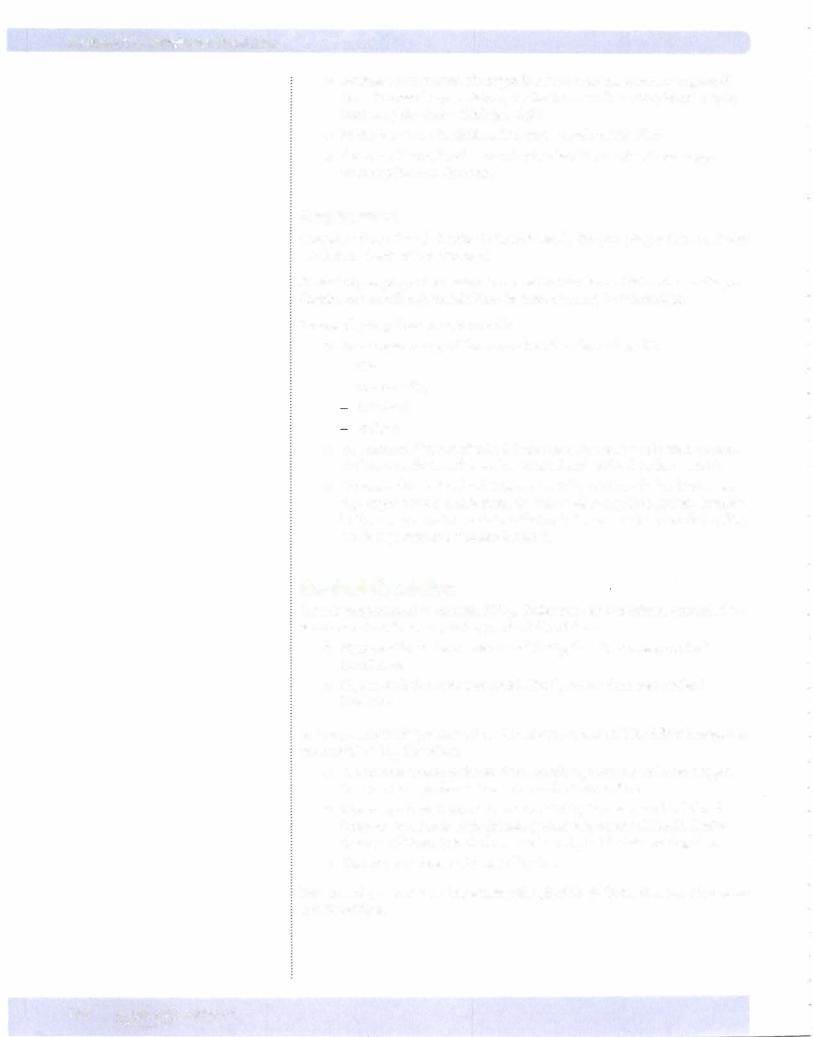
Section V • Peripheral Circulation
•Because the extraction ofoxygen is almost maximal under resting condi tions, increased oxygen deliveryto the tissue can be accomplished onlyby increasing blood flow (Fickprinciple).
•In the coronary circulation, flowmust match metabolism.
•Coronary blood flow is most closelyrelated to cardiac tissue oxygen consumption and demand.
Pumping action
Coronary blood flow (mL/min) is determined by the pumping action, or stroke worktimes heart rate, ofthe heart.
Increased pumping action means increased metabolism, which increases the pro duction ofvasodilatorymetabolites. In turn, coronaryflow increases.
Increased pump function occurs with:
•An increase in any of the parameters that determine CO:
-HR
-Contractility Afterload Preload
•HR, contractility, and afterload (often calledpressure work) are more met abolicallycostlythan theworkassociatedwith preload (volume work).
•Thus, conditions in which HR, contractility, and/or afterload increase, e.g., hypertension, aortic stenosis, and exercise require a greater increase in flow compared to conditions that only increase volume work (supine, aortic regurgitation, volume loading).
Cerebral Circulation
Flow is proportional to arterial PC02. Under normal conditions, arterial PC02 is an important factor regulating cerebral blood flow.
• Hypoventilation increases arterial PC02, thus it increases cerebral blood flow.
• Hyperventilation decreases arterial PC02, thus it decreases cerebral blood flow.
As long as arterial P02 is normal or above normal, cerebral blood flow is regulated via arterial PC02. Therefore:
•If a normal person switches from breathing room air to 100% oxygen, there are no significant change in cerebral blood flow.
•However, a (large) decrease in arterial P02 increases cerebral blood flow; an example is high-altitude pulmonaryedema (HAPE). Under these conditions, it is the low arterial P02 that is determining flow.
•Baroreceptor reflexes do not affect flow.
Intracranial pressure is an important pathophysiologic factor that can affect cere bral blood flow.
112 MEDICAL
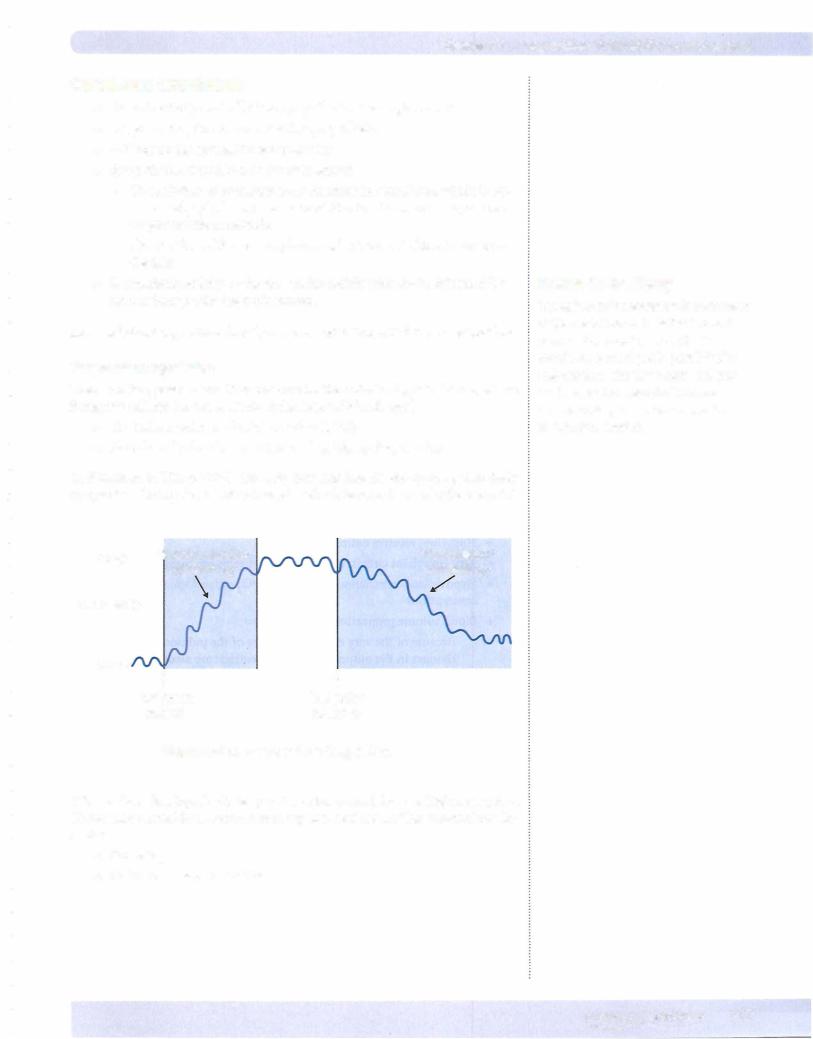
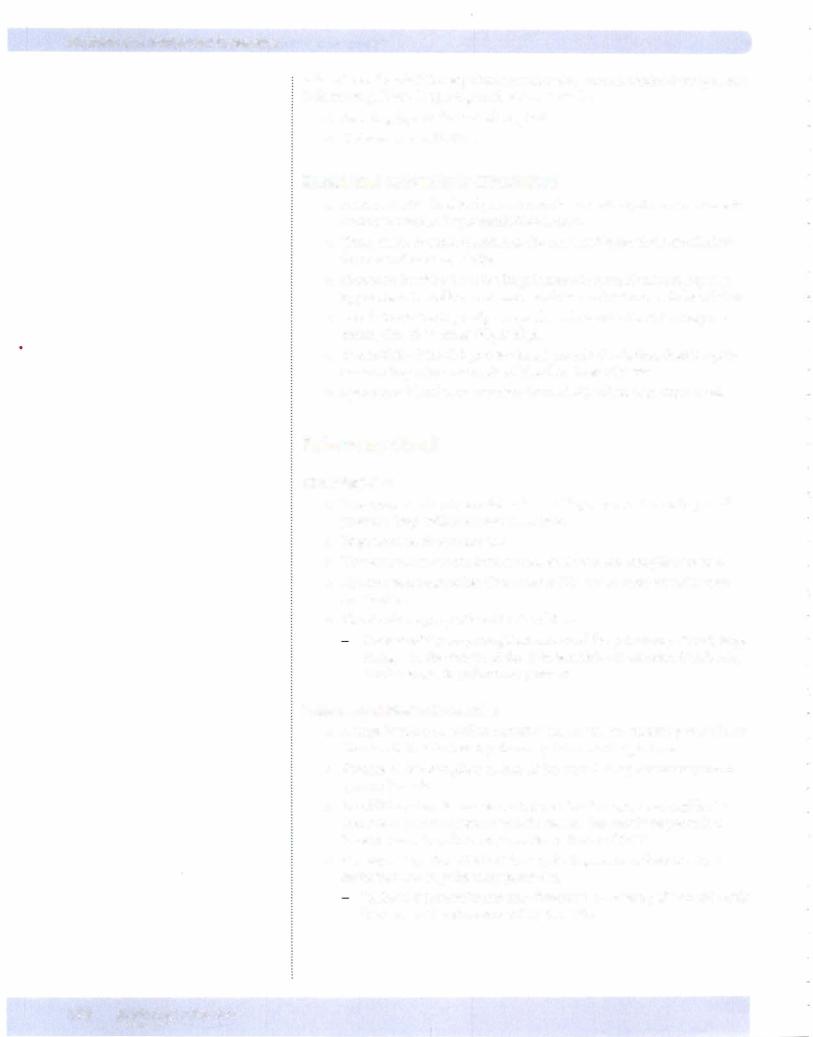
Section V • Peripheral Circulation
Aftera fever "breaks;' theset point has returned to normal, andbody temperature is decreasing. Heat-dissipating mechanisms include:
•Sweating (sympathetic cholinergics)
•Cutaneous vasodilation
Renal and Splanchnic Circulation
•A small change in blood pressure invokes an autoregulatory response to maintain renal and splanchnic blood flows.
•Thus, under normal conditions, the renal and splanchnic circulations demonstrate autoregulation.
•Situations in which there is a large increase in sympathetic activity (e.g., hypotension) usually cause vasoconstriction and a decrease in blood flow.
•Renal circulation is greatly overperfused in terms of nutrient require ments, thus the venous P02 is high.
•About 25% of the CO goes to the splanchnic circulation, thus it repre sents an important reservoir of blood in times of stress.
•Splanchnic blood flow increases dramatically when digesting a meal.
PulmonaryCircuit
Characteristics
•Low-pressure circuit, arterial = 15 mm Hg, venous = 5 mm Hg; small pressure drop indicates a low resistance.
•High flow, receives entire CO
•Very compliant circuit; both arteries and veins are compliant vessels
•Hypoxic vasoconstriction (low alveolar P02 causes local arteriolar vaso constriction)
•Blood volume proportional to blood flow
Because of the very compliant nature of the pulmonary circuit, large changes in the output of the right ventricle are associated with only small changes in pulmonary pressures.
Pulmonaryresponse to exercise
•A large increase in cardiac output means increased volume pumped into the circuit. This increases pulmonary intravascular pressures.
•Because of the compliant nature of the circuit, the pulmonary arterial system distends.
•In addition, there is recruitment of previously unperfused capillaries. Because of this recruitment and distension, the overall response is a large decrease in pulmonary vascular resistance (PVR).
•Consequently, when CO is high, e.g., during exercise, there is only a slight increase in pulmonary pressures.
Without this recruitment and distension, increasing CO would result in a very high pulmonary artery pressure.
114 MEDICAL
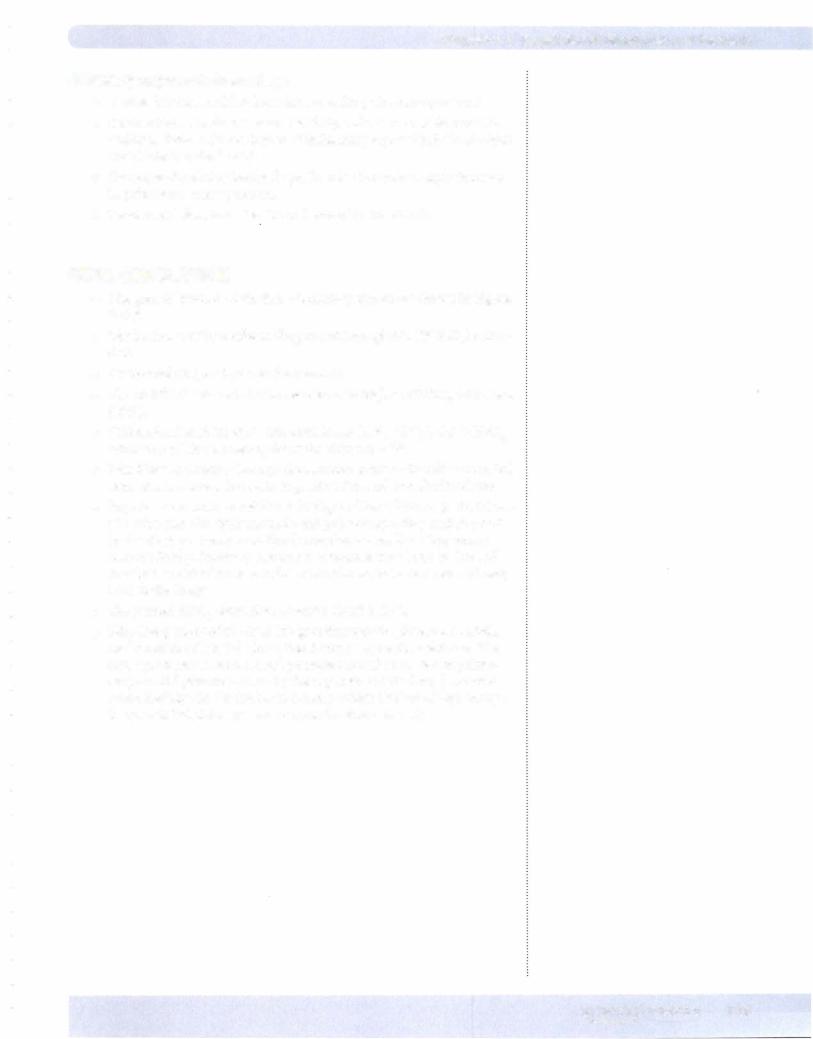
Chapter 2 • Regulation of Blood Flow and Pressure
Pulmonary response to hemorrhage
•A large decrease in CO reduces intravascular pulmonary pressures.
•Because these vessels have some elasticity, pulmonaryvessels recoil. In addition, there is derecruitment ofpulmonarycapillaries, both ofwhich contribute to a rise in PVR.
•Consequently, during hemorrhage, there is often only a slight decrease in pulmonary artery pressure.
•Vessel recoil also means less blood is stored in this circuit.
FETAL CIRCULATION
•The general features ofthe fetal circulatory system are shown in Figure V-2-6.
•The balded numbers refer to the percent hemoglobin (%Hb02) satura tion.
•Of the fetal CO, 55% goes to the placenta.
•The umbilical vein and ductus venosus have highest %Hb02 saturation (80%).
•When mixed with inferior vena caval blood (26% Hb02), the %Hb02 saturation ofblood entering the right atrium is 67%.
•This blood is directed through the foramen ovale to theleft atrium, left ventricle, and ascending aorta to perfuse the head and the forelimbs.
•Superior vena caval blood (40% Hb02) is directed through the tricus pid valve into the right ventricle and pulmonary artery and shunted by the ductus arteriosus to the descending aorta. Shunting occurs because fetal pulmonary vascular resistance is very high, so 90% of the right ventricular output flows into the ductus arteriosus and only 10% to the lungs.
•The percent Hb02 saturation of aortic blood is 60%.
•Fifty-five percent ofthe fetal CO goes through the placenta. At birth, the loss of the placental circulation increases systemic resistance. The subsequent rise in aortic blood pressure (as well as the fall in pulmo nary arterial pressure caused by the expansion of the lungs) causes a reversal of flow in the ductus arteriosus, which leads to a large enough increase in left atrial pressure to close the foramen ovale.
M EDICAL 1 1 5


Chapter 2 • Regulation of Blood Flow and Pressure
Systemic Circuit
Arterial system
•P02: no significant change, hemoglobin still fully saturated
•PC02: no significant change, increase in ventilation proportional to increase in metabolism
•pH: no change or a decrease due mainly to the production of lactic acid
•Mean arterial pressure: slight increase
•Body temperature: slight increase
•Vascular resistance (TPR): large decrease, dilation ofskeletal muscle beds
Venous system
•P02: decrease
•PC02: increase
Regional Circulations
Exercising skeletal muscle
•Vascular resistance decreases.
•Blood flow increases.
•Capillary pressure increases.
•Capillary filtration increases.
•Lymph flow increases.
•As predicted by the Fick principle, oxygen extraction increases and venous P02 falls.
Cutaneous bloodflow
Initial decrease, then an increase to dissipate heat
Coronarybloodflow
Increase due to increased work ofthe heart
Cerebral bloodflow
No significant change (arterial C02 remains unchanged)
Renaland GI bloodflow
Both decrease
MEDICAL 117

Section V • Peripheral Circulation
Physical conditioning
•Regular exercise increases maximal oxygen consumption (V02max) by:
-Increasing the ability to deliver oxygen to the active muscles. It does this byincreasing the CO.
The resting conditioned heart has a lower heart rate but greater stroke volume (SV) than does the resting unconditioned heart.
At anylevel ofexercise, stroke volume is elevated.
However, the maximal heart rate remains similar to that of untrained individuals.
• Regular exercise also increases the ability of muscles to utilize oxygen. There are:
An increased number of arterioles, which decreases resistance during exercise.
An increased capillary density, which increases the surface area and decreases diffusion distance.
An increased number of oxidative enzymes in the mitochondria.
Chapter Summary
•The Fick principle defines the relationship of 02 uptake (consumption), flow, and 02 extraction.
•The production ofvasodilatory metabolites and the myogenic mechanism explains autoregulation of blood flow.
•Sympathetic noradrenergic nerves represent the main control in extrinsically regulated systemic tissues.
•Restingskeletal muscle exhibits extrinsic regulation, but exercising muscle autoregulates.
•Mechanical compression ofthe intramyocardial vessels restricts perfusion to the myocardium during systole.
•Because oxygen extraction is almost complete from the blood perfusing the myocardium, coronary flow must match myocardial metabolism.
•The main factor regulating cerebral blood flow is arterial carbon dioxide.
•The cutaneous circulation exhibits extrinsic regulation, and flow responds to the need for heat exchange with the environment.
•Normally, the kidney exhibits strong autoregulation but sympathetic noradrenergic nerves can vasoconstrict.
•The compliant nature ofthe pulmonary circuit minimizes changes in pulmonary pressures with large changes in cardiac output.
118 MEDICAL
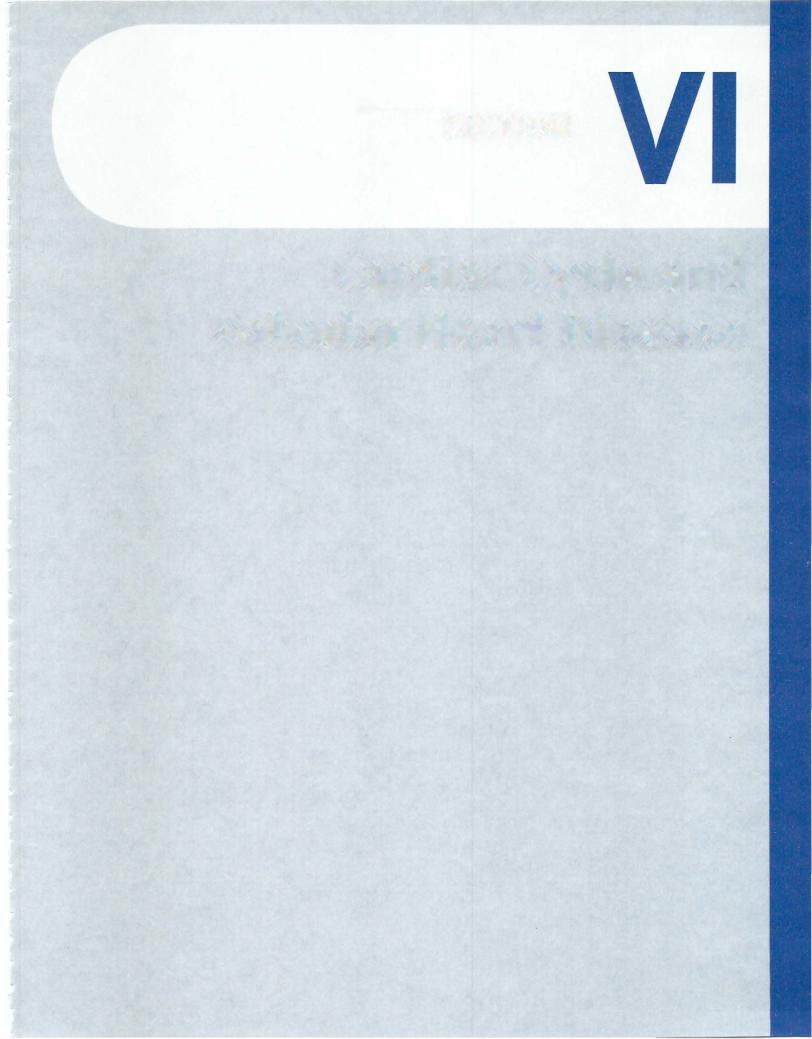
SECTION
Cardiac Cycle and
Valvular Heart Disease


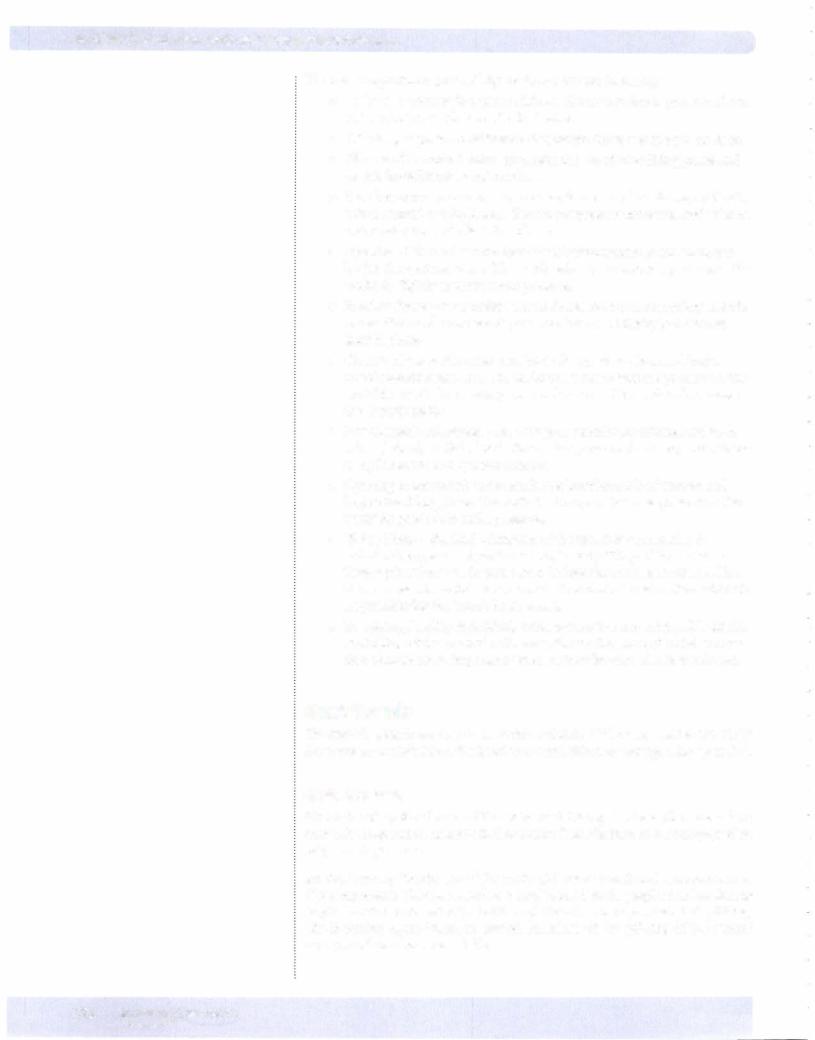
Section VI • Cardiac Cycle and Valvular Heart Disease
The most important aspects ofFigure VI-1-1 are the following:
•QRS contraction ofventricle rise in ventricular pressure above
atrial pressure closure of rnitral valve
•It is always a pressure difference that causes the valves to open or close.
•Closure of the mitral valve terminates the ventricular filling phase and begins iso-volumetric contraction.
•Isovolumetric contraction-no change in ventricular volume, and both valves (rnitral, aortic) closed. Ventricular pressure increases, and volume is equivalent to end-diastolic volume.
•Opening ofthe aortic valve terminates isovolumetric contraction and begins the ejection phase. The aortic valve opens because pressure in the ventricle slightly exceeds aortic pressure.
•Ejection Phase-ventricular volume decreases, but most rapidly in early stages. Ventricular and aortic pressures increase initially but decrease later in phase.
•Closure ofthe aortic valve terminates the ejection phase and begins isovolumetric relaxation. The aortic valve closes because pressure in the ventricle goes below aortic pressure. Closure ofthe aortic valve creates the dicrotic notch.
•Isovolumetric relaxation-no change in ventricular volume, and both valves (rnitral, aortic) closed. Ventricular pressure decreases, and volume is equivalent to end-systolic volume.
•Opening ofthe mitral valve terminates isovolumetric relaxation and begins the filling phase. The mitral valve opens because pressure in the ventricle goes below atrial pressure.
•Filling Phase-the final relaxation ofthe ventricle occurs after the mitral valve opens and produces a rapid early filling ofthe ventricle. This rapid inflow will in some cases induce the third heart sound. The final increase in ventricularvolume is due to atrial contraction, which is responsible for the fourth heart sound.
•In a young, healthy individual, atrial contraction doesn't provide signifi cant filling ofthe ventricle. However, the contribution of atrial contrac tion because more important when ventricular compliance is reduced.
HeartSounds
The systolic sounds are due to the sudden closure ofthe heart valves. Normally thevalves on the left side ofthe heart close first. Valves on the right side open first.
Systolic sounds
S1: Produced by the closure of the mitral and tricuspid valves. The valves close withonlya separation ofabout 0.01 secondswhichthehuman ear can appreciate only as a single sound.
S2: Produced by the closure of the aortic (A2 component) and pulmonic valves (P2 component). They are heard as a single sound during expiration but during inspiration the increased outputofthe right heart causes a physiological splitting. The following figure illustrates several situations where splitting of the second heart sound maybecome audible.
1 22 MEDICAL
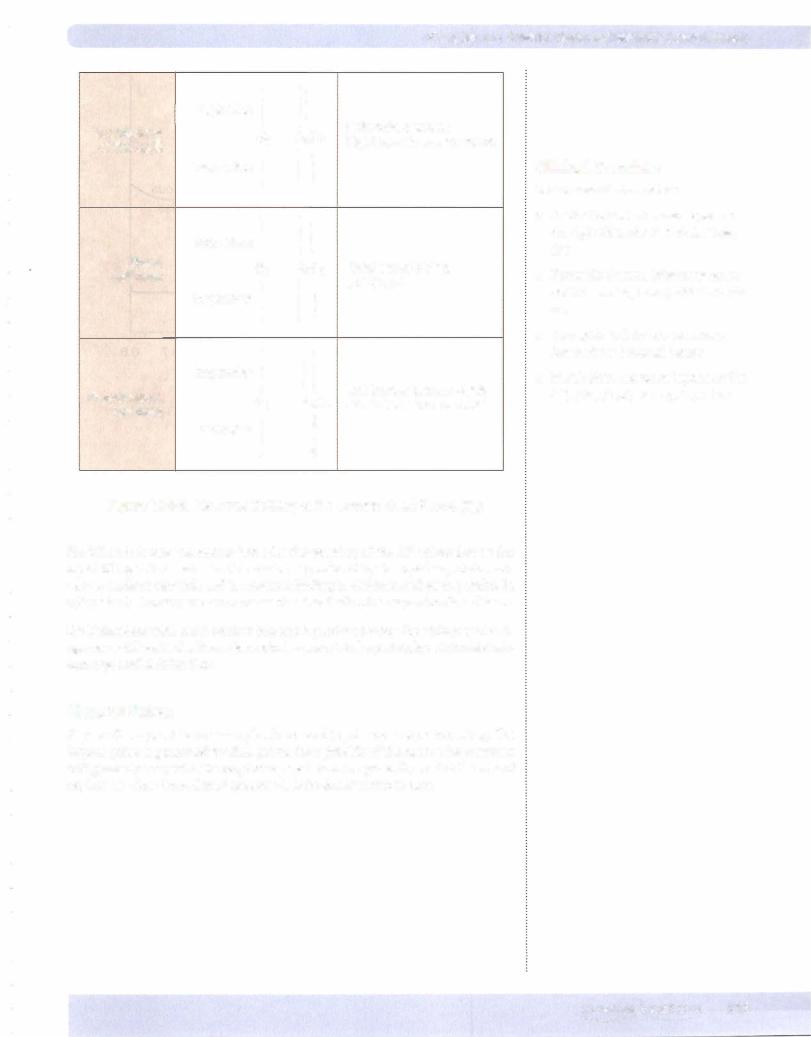


Chapter i. • Cardiac Cycle and Valvular Heart Disease
ydescent
•Produced by the rapid emptying of the right atrium immediately after the opening of the tricuspid valve
•A more prominent wave in tricuspid insufficiency and a blunted wave in tricuspid stenosis.
Some abnormalvenous pulses are shown in the following figure.
a |
Normal |
|
|
|
A Fib |
|
v |
a |
Tricuspid |
regurgitation |
Tricuspid
stenosis
Figure Vl-1-4. Normal Versus Abnormal Jugular Pulses
Similar recordings to the systemic venous pulse are obtained when recording pul monarycapillarywedgepressure. Left atriummechanicalevents aretransmittedin a retrograde manner, although theyare somewhat damped and delayed. The figure below shows the pressure recording from the tip ofa Swan-Ganz catheter inserted through a systemic vein throughthe right side ofthe heart into the pulmonarycir culation and finallywith the tip wedged in a small pulmonary artery. The pressure recorded at the tip ofthe catheter is referred to as pulmonary capillary wedge pres sureand is closeto left atrialpressureandis an index ofpreload on theleftventricle.
R. vent pressure = 25/2 |
25/8 |
|
|
|
Pulmonary arterial pressure = |
|
|
|
|
|
A |
= |
Passage across tricuspid valve |
|
(]) |
|
|
|
|
a:::; |
|
B = Passage across pulmonic valve |
||
(/) |
|
|
|
|
(/) |
|
C = Pulmonary capillary wedge pressure |
||
..... |
|
|||
(]) |
|
|
|
|
.. |
|
|
|
|
. . |
|
|
|
|
Time
Figure Vl-1 -5. Swan-Ganz Catheterization
MEDICAL |
125 |
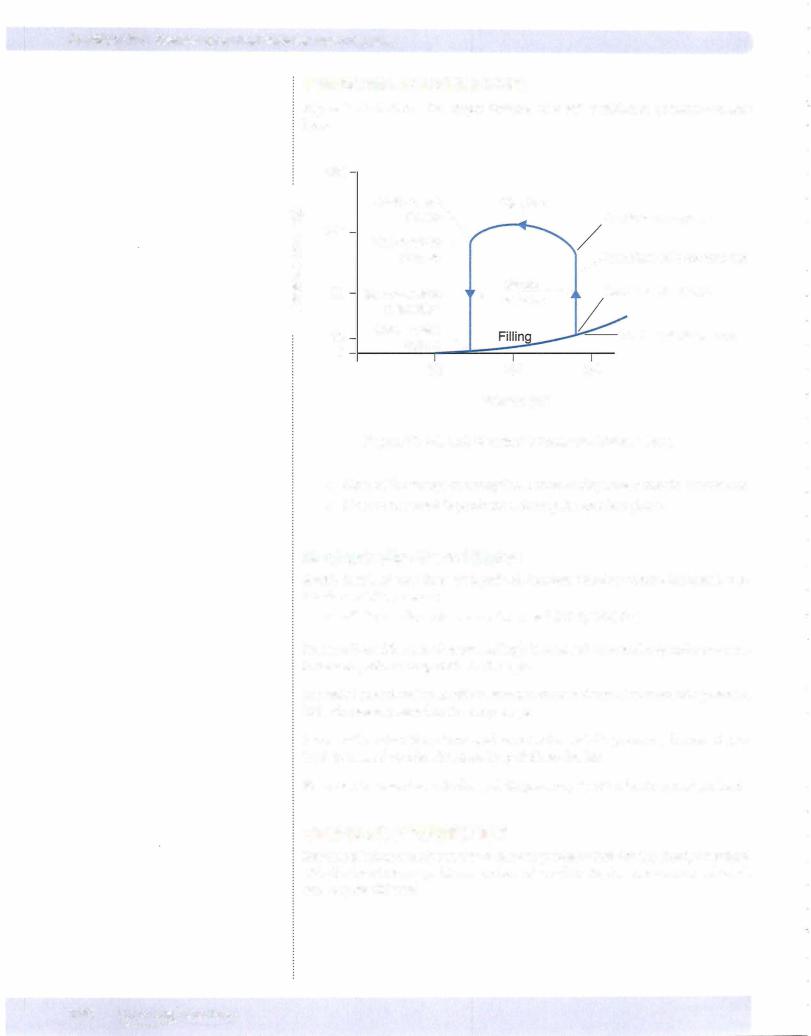

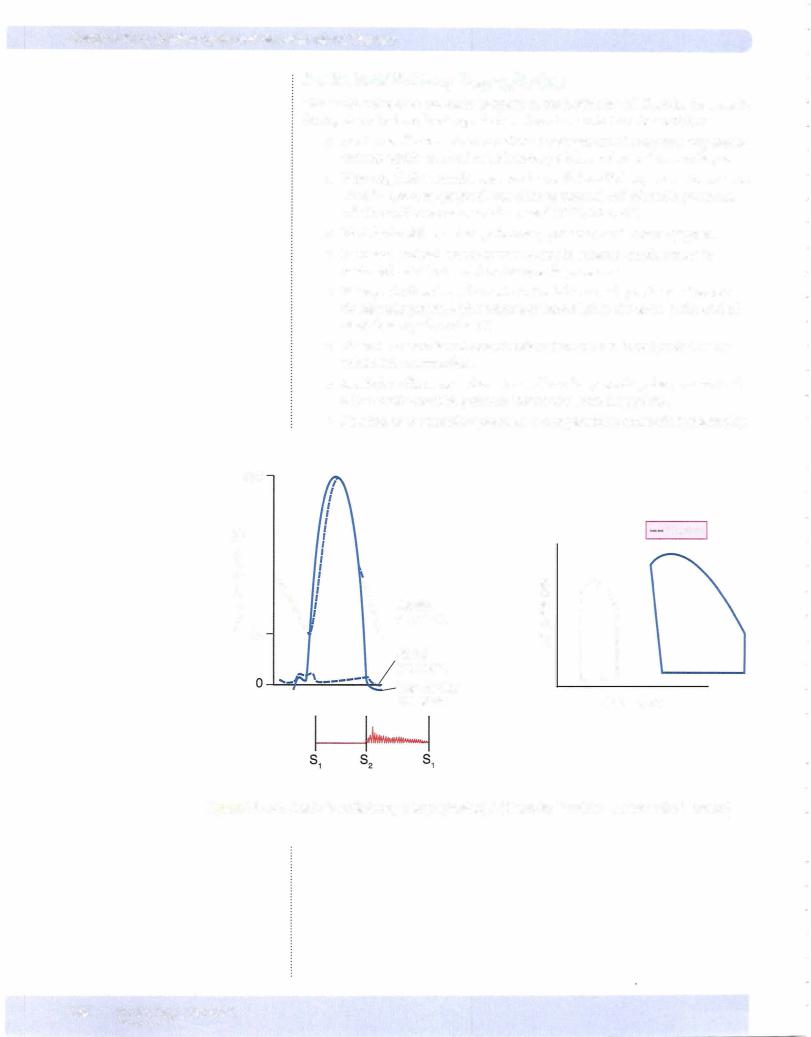

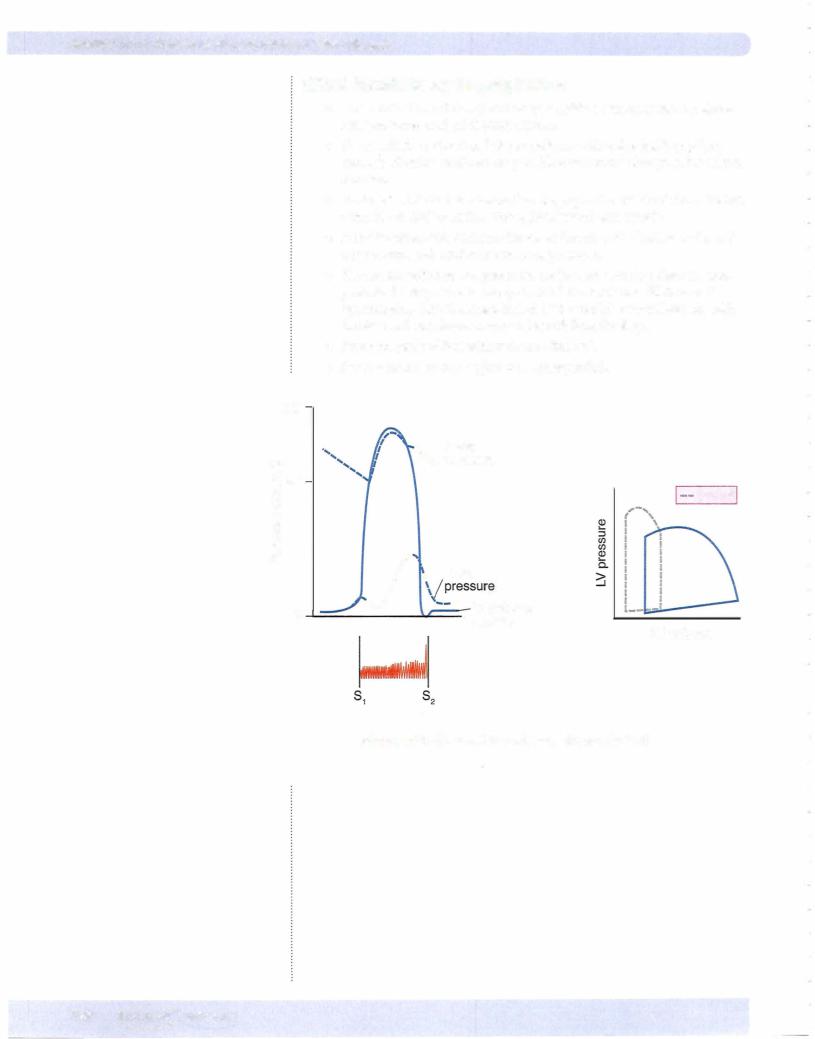
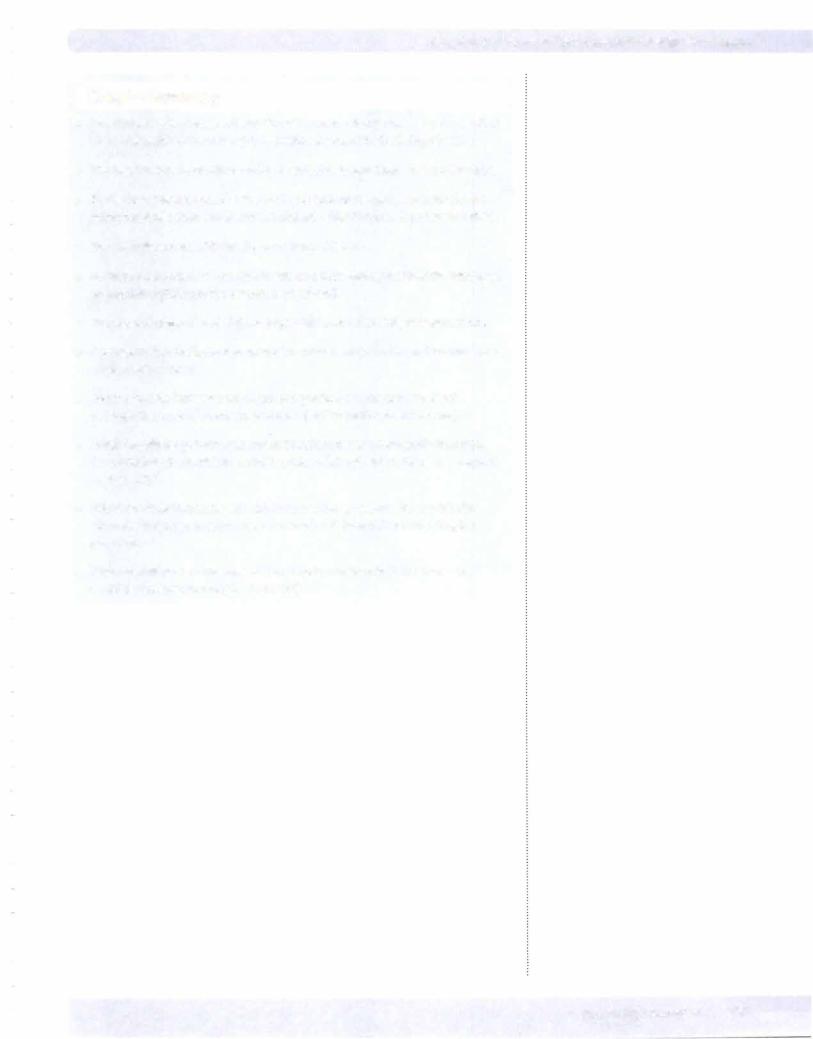
Chapter 2. • cardiac Cycle and Valvular Heart Disease
Chapter Summary
•The cardiac cycle consists of isovolumetric contraction followed by the ejection phase followed by isovolumetric relaxation followed by the filling phase.
• The heartvalves normally close on the left side before they close on the right.
•51 the first systolic sound is due to the closure of the AVvalves, and 52 the second systolic sound is due to the closure ofthe aortic and pulmonic valves.
•The diastolic sounds 53 and 54 are often not heard.
•An increased output ofthe right heart, as occurs during inspiration, produces an audible splitting ofthe second heart sound.
•The venous pulse recorded from a systemic vein reflects right heart events.
•A pressure-volume loop represents the changes in pressure and volume for a single cardiac cycle.
•Aortic stenosis increases afterload and produces a pressure gradient between the ventricle and aorta during ejection (midsystolic murmur).
•Aortic insufficiency increases preload and produces a retrograde flow from the aorta into the ventricle during isovolumetric relaxation (diastolic murmur begins at 52).
•Mitral stenosis increases left atrial volume and pressure, but ventricular volumes and pressures are normal or reduced (diastolic murmur begins after 52).
•Mitral insufficiency increases volumes and pressures in the atrium and ventricle (systolic murmur begins at 51).
MEDICAL |
131 |

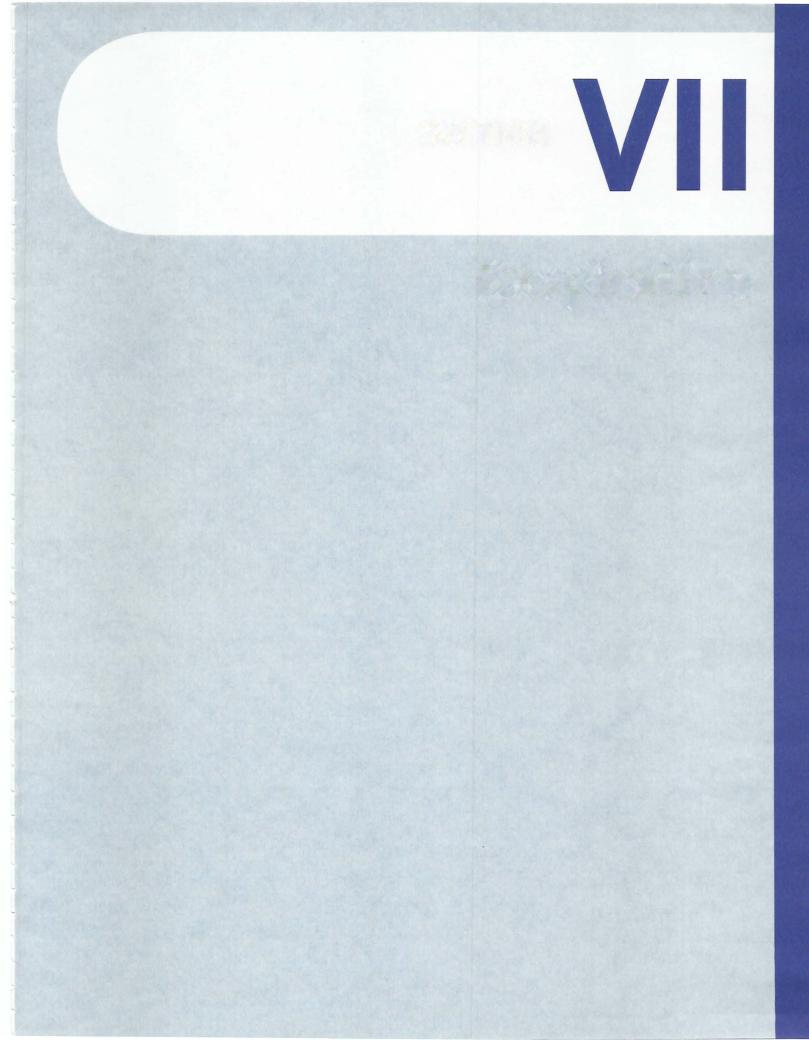
SECTION
Respiration

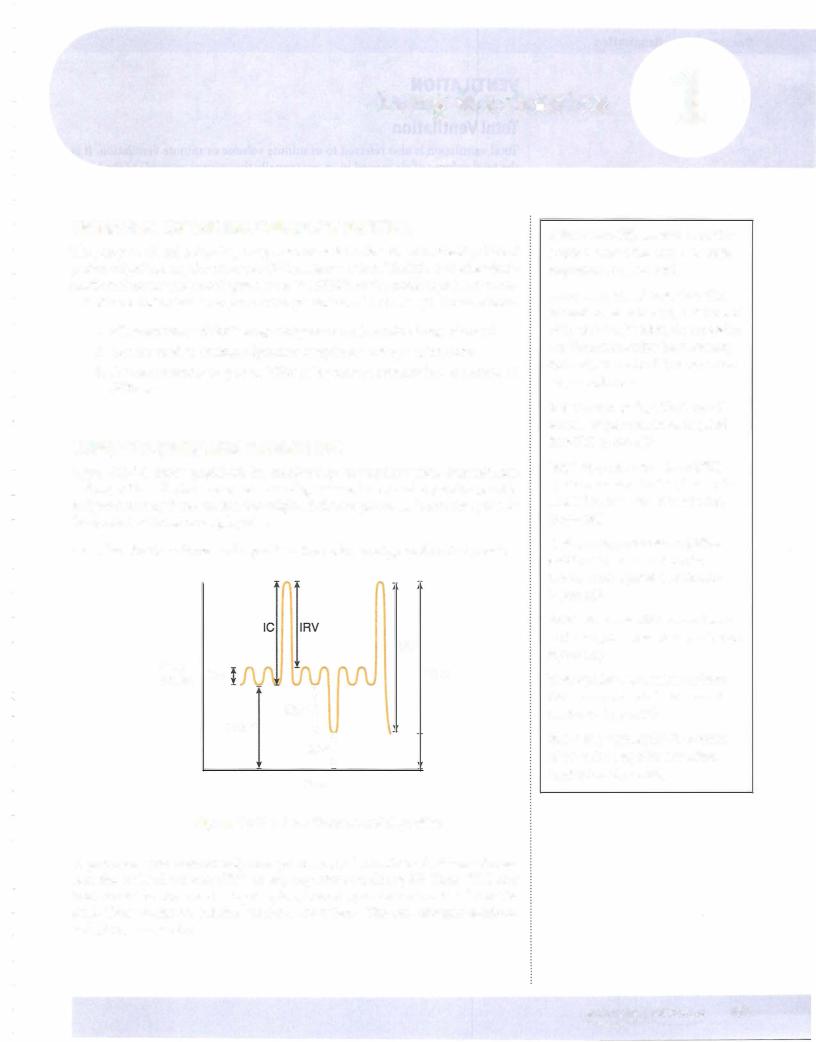
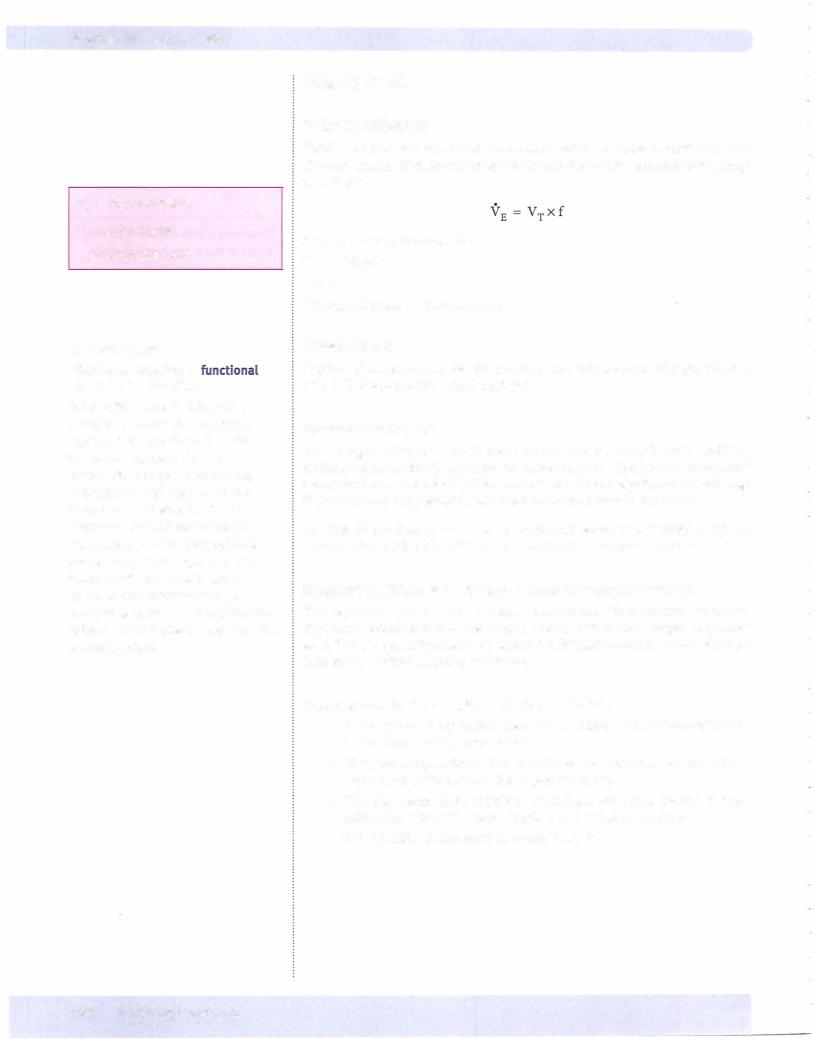
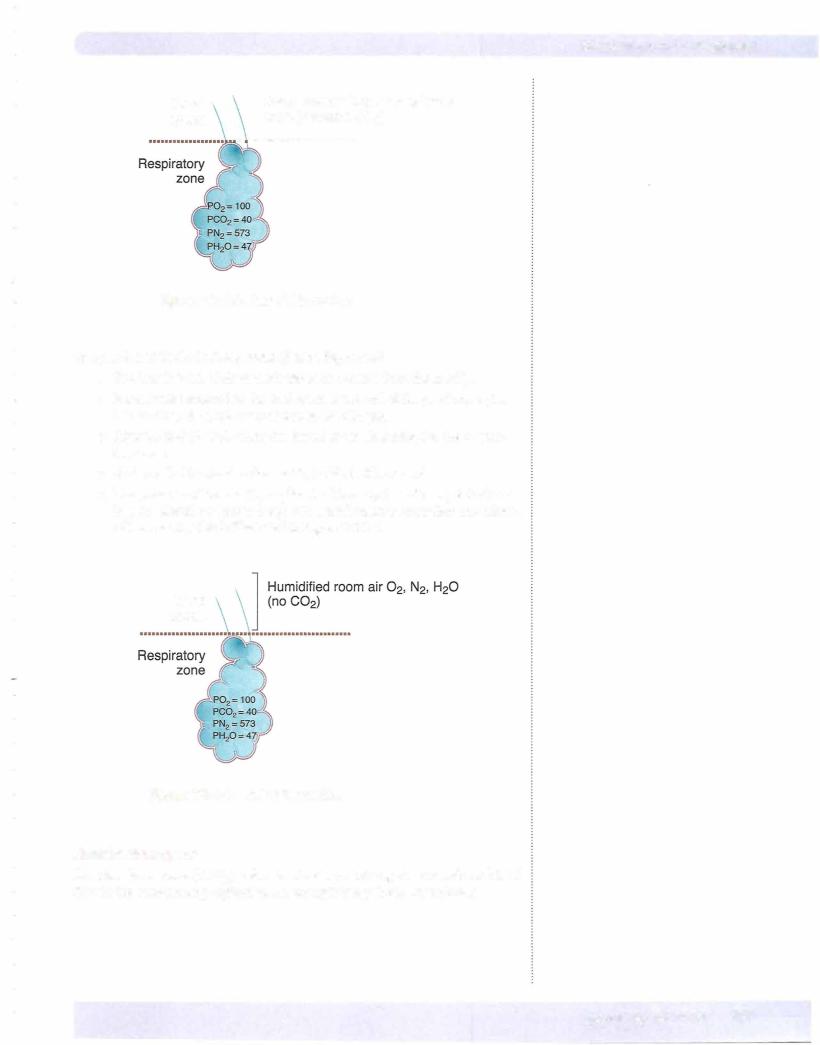
spaceDead |
lzoneSame(containscompositionC02as) respiratory |
Chapter 1 • Lung Mechanics
. . ...........................
Figure Vll-1-2. End of Expiration
Composition at the End of Inspiration (Before Expiration)
•The first 150 ml ofair to reach the alveoli comes fromthe anatV0.
•It is air that remained in the dead space at the end ofthe previous expira tion and has the same composition as alveolar gas.
•After the first 150 mL enters the alveoli, room air is added to the respira tory zone.
•At the end of inspiration the anatV0 is filled with room air.
•The presence ofthe anatV0 implies the following: in order to get fresh air
into the alveoli, one must always take a tidalvolume largerthanthe volume ofthe anatV0. This is illustrated in Figure VII-1-3.
Dead space
Figure Vll-1-3. End of Inspiration
Alveolardeadspace
Alveolar dead space (alvV0) refers to alveoli containing air but without blood flow in the surrounding capillaries. An example is a pulmonary embolus.
MEDICAL 137
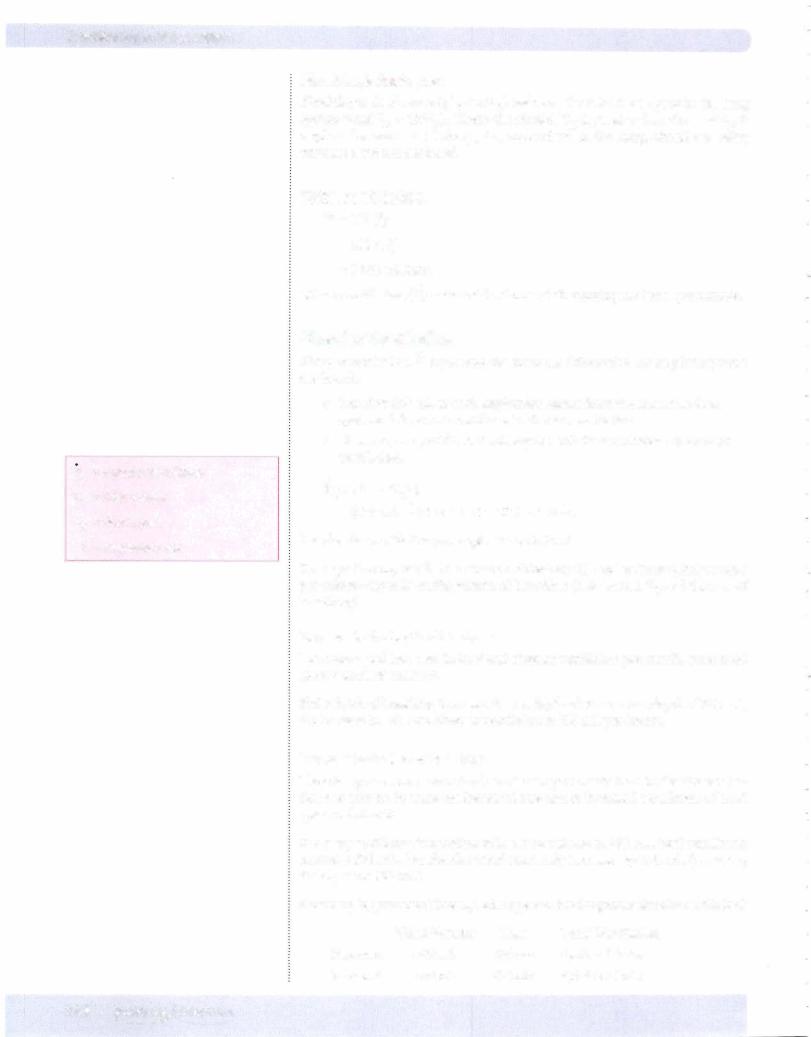
Section VII • Respiration
VA |
= alveolar ventilation |
Vr |
= tidal volume |
V0 |
= dead space |
f |
= respiratory rate |
Physiologic deadspace
Physiologic dead space (physioIVD) refers to the total dead space in the lung system (anatVD + alvVD). When the physiol VD is greater than the anatVD' it implies the presence of alvVD' i.e., somewhere in the lung, alveoli are being ventilated but not perfused.
Totalventilation
V= VT (f)
=500 ( 15)
=7,500 mL/min
Minute ventilation (\r) is the total volume of air entering the lungs per minute.
AlveolarVentilation
Alveolar ventilation VA represents the room air delivered to the respiratory zone per breath.
•The first 150 mL of each inspiration comes from the anatomic dead space and does not contribute to alveolar ventilation.
•However, every additional mL beyond 150 does contribute to alveolar ventilation.
VA = (VT - vD) f
= (500 mL - 150 mL) 15 = 5250 mL/min
The alveolarventilation per inspiration is 350 mL.
This equation implies that the volume offresh air that enters the respiratory zone per minute depends on the pattern of breathing (how large a VT and the rate of breathing).
Increases in the Depth of Breathing
There are equal increases in total and alveolar ventilation per breath, since dead space volume is constant.
If the depth ofbreathing increases from a depth of 500 mL to a depth of 700 mL, the increase in total and alveolar ventilation is 200 mL per breath.
Increases in the Rate of Breathing
There is a greater increase in total ventilation per minute than in alveolar ventila tion per minute, because the increased rate causes increased ventilation of dead space and alveoli.
For every additional inspiration with a tidal volume of 500 mL, total ventilation increases 500 mL, but alveolar ventilation only increases by 350 mL (assuming dead space is 150 mL).
For example, giventhe following, which person hasthe greater alveolar ventilation?
|
TidalVolume |
Rate |
Total Ventilation |
Person A |
600 mL |
10/min |
6,000 mL/min |
Person B |
300 mL |
20/min |
6,000 mL/min |
1 38 MEDICAL
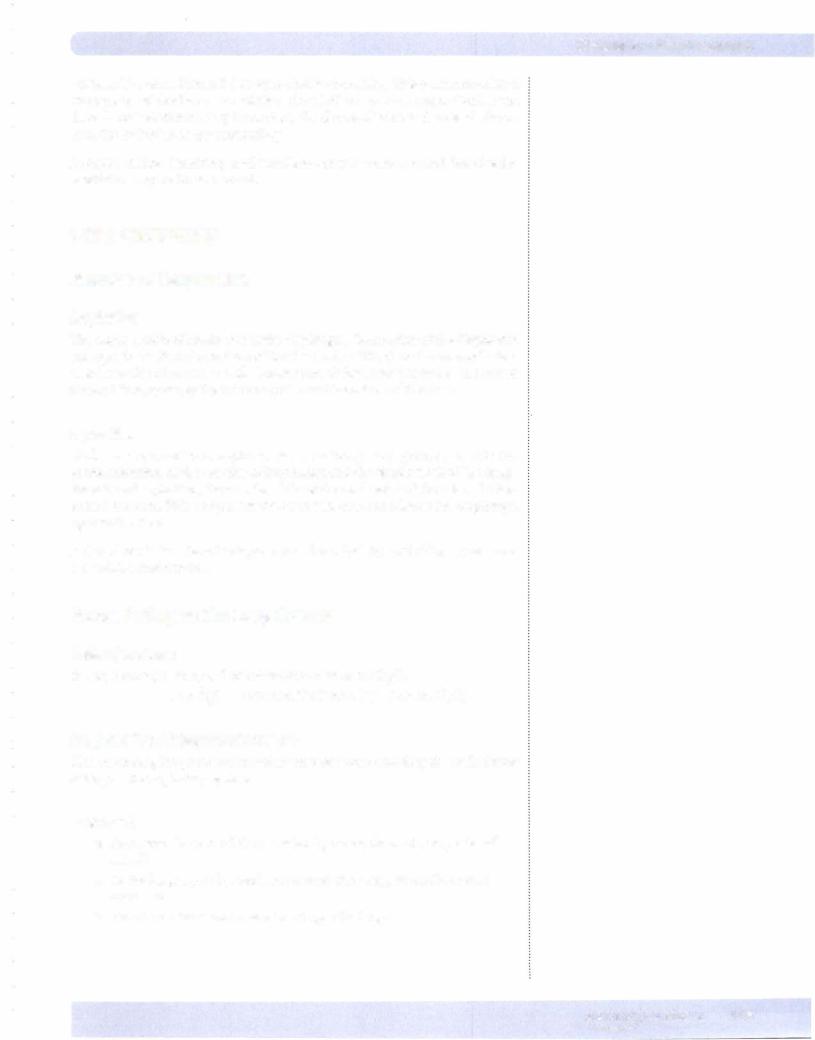
Chapter 1 • Lung Mechanics
Answer: Person A. Person B has rapid, shallowbreathing. This person has a large component of dead-space ventilation (first 150 mL of each inspiration). Even though total ventilation may be normal, alveolar ventilation is decreased. There fore, the individual is hypoventilating.
In rapid, shallow breathing, total ventilation may be above normal, but alveolar ventilation may be below normal.
LUNG MECHANICS
Muscles of Respiration
Inspiration
The major muscle of inspiration is the diaphragm. Contraction of the diaphragm enlarges the vertical dimensions ofthe chest. Also utilized are the external inter costal muscles of the chest wall. Contraction of these muscles causes the ribs to rise and thus increases the anterior-posterior dimensions of the chest.
Expiration
Under resting conditions, expiration is normally a passive process, i.e., it is due to the relaxation of the muscles of inspiration and the elastic recoil of the lungs. For a forced expiration, the muscles ofthe abdominal wall and the internal inter costals contract. This compresses the chest wall down and forces the diaphragm up into the chest.
Included would be external oblique, rectus abdominal, internal oblique, and trans verse abdominal muscles.
Forces Acting on the LungSystem
Units ofpressure
In respiratory physiology, they are usually given as cm H20.
1 cm H20 = 0.74 mm Hg (1 mm Hg = 1 .36 cm H20)
Lung recoil and intrapleural pressure
Understanding lung mechanics mainly involves understanding the main forces acting on the respiratory system.
Lung Recoil
•Represents the inward force created bythe elastic recoil properties of alveoli.
•As the lung expands, recoil increases; as the lung gets smaller, recoil decreases.
•Recoil, as a force, always acts to collapse the lung.
MEDICAL 139
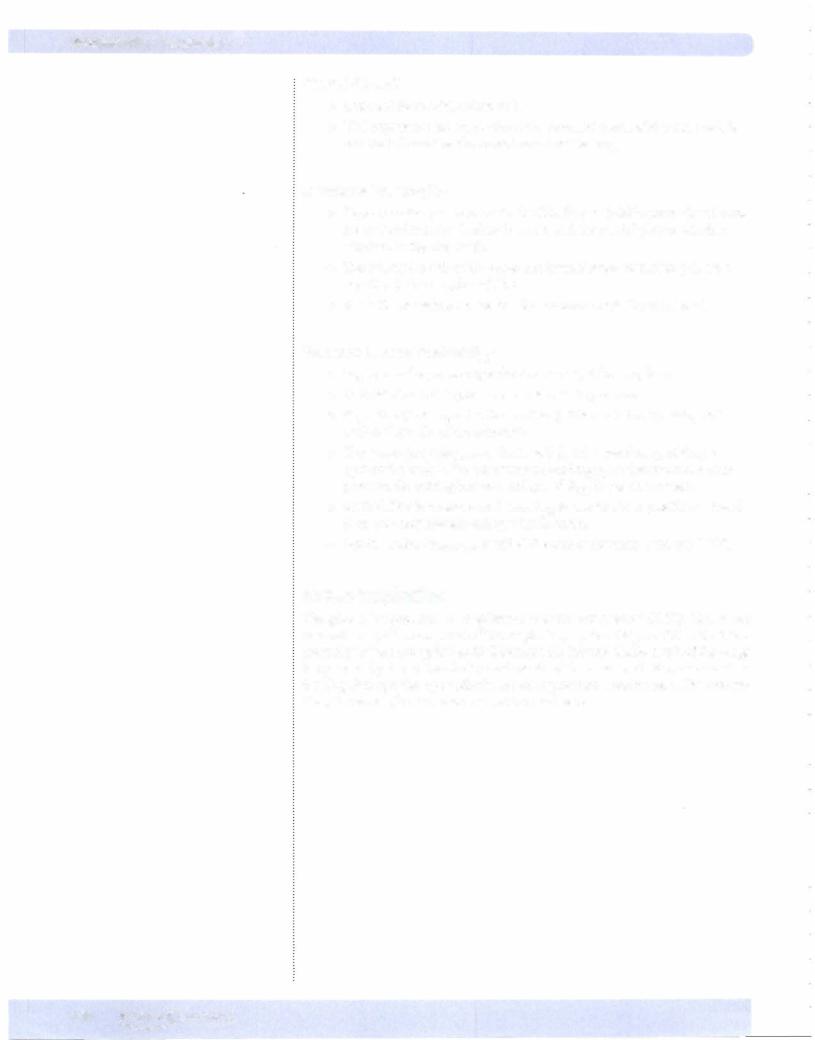
Section VII • Respiration
Chest Wall Recoil
•Outward force of the chest wall
•FRC represents the point where this outward recoil of the chest wall is counterbalanced by the inward recoil of the lung.
lntrapleural Pressure (IPP)
•Represents the pressure inside the thin film of fluid between the visceral pleura, which is attached to the lung, and the partial pleura, which is attached to the chest wall.
•The outward recoil of the chest and inward recoil of the lung create a negative (subatmospheric) IPP.
•IPP is the outside pressure for all structures inside the chest wall.
Transmural Pressure Gradient (P1M)
•Represents the pressure gradient across any tube or sphere
•Calculated as inside pressure minus outside pressure
•If positive (inside greater than outside), it is a net force pushing out against the walls of the structure
•If negative (outside greater than inside), it is a net force pushing in against the walls of the structure; depending upon the structural com ponents, the tube/sphere can collapse if PTM is negative or zero
•At FRC, IPP is negative, and thus PTM is positive. This positive outward force prevents alveolar collapse (atelectasis).
•For the entire lung, PTM is called the transpulmonary pressure (TPP).
Before Inspiration
The glottis is open, and all respiratory muscles are relaxed (FRC). This is the neutral or equilibrium point of the respiratory system (Figure VII- 1 -4). Intra pleural pressure is negative at FRC because the inward elastic recoil ofthe lungs is opposed by the outward-directed recoil of the chest wall. Because no air is flowing through the open glottis, alveolar pressure must be zero. By conven tion, the atmospheric pressure is set to equal zero.
140 MEDICAL
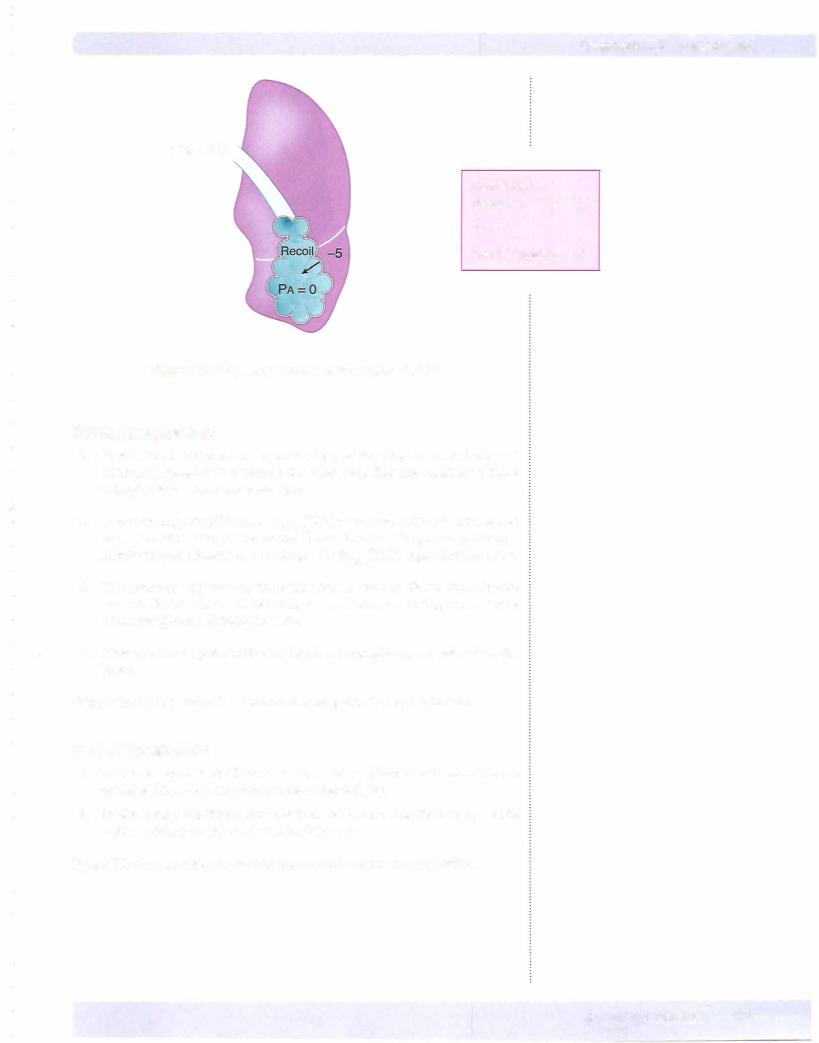
Chapter 1 • Lung Mechanics
Patm = 0
Intrapleural
pressure = -5 cm H20
PTM = 5
Alveolar pressure = O
Figure Vll-1-4. Lung Force Relationships at FRC
During Inspiration
1 . Inspiration is induced by the contraction of the diaphragm and external intercostal muscles that expand the chest wall. The net result is to make intrapleural pressure more negative.
2. The more negative IPP causes PTM (TPP) to increase, which in turn causes expansion of the lungs. The greater the contraction, the greater the change in intrapleural pressure and the larger the P™ (TPP) expanding the lung.
3.The expansion of the lung increases alveolar volume. Based upon Boyle's law, the rise in volume causes pressure to decrease, resulting in a negative (subatmospheric) alveolar pressure.
4.Because alveolar pressure is now less that atmospheric, air rushes into the lungs.
Figure VII- 1 -5 illustrates the situation at some point during inspiration.
End of Inspiration
1 . The lung expands until alveolar pressure equilibrates with atmospheric pressure. The lungs are at their new, larger volume.
2. Under resting conditions, about 500 mL ofair flows into the lung system in order to return alveolar pressure back to zero.
Figure VII- 1 -6 illustrates the situation at the end of a normal inspiration.
MEDICAL 141
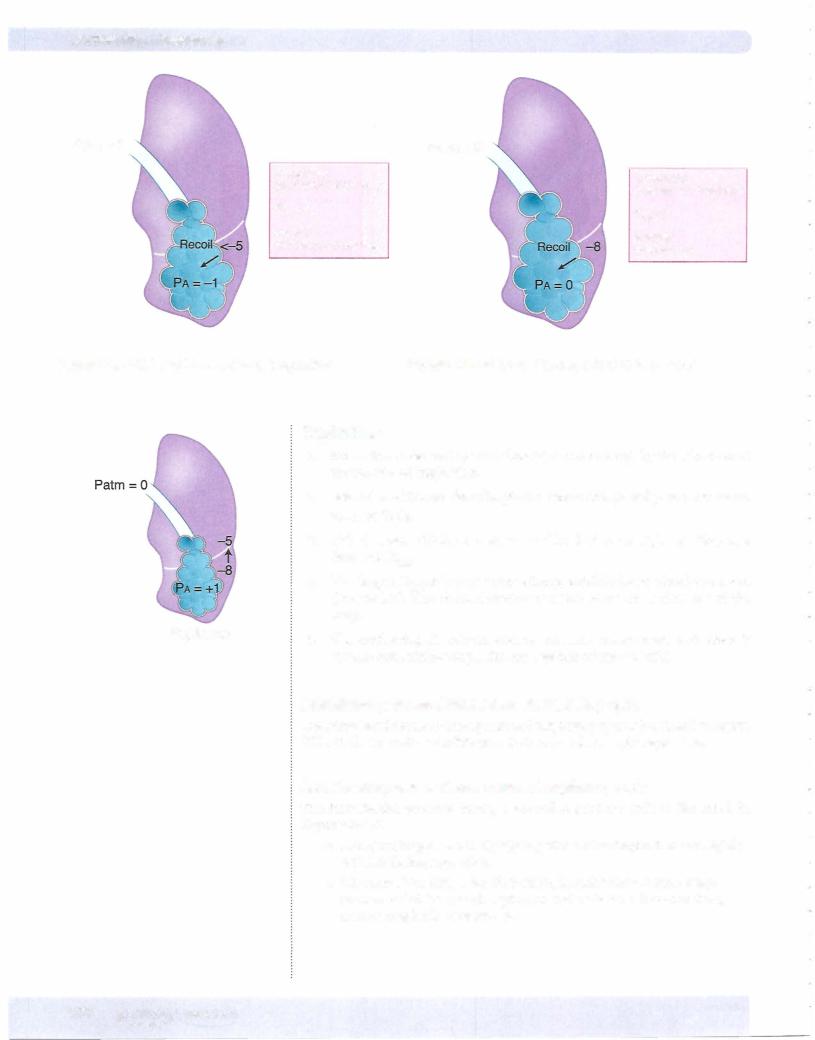
Section VII • Respiration
Patm 0 |
|
Patm O |
|
|
||
lntrapleural |
|
|||||
lntrapleural |
|
|||||
= |
pressure |
-5 cm H20 |
= |
-8 cm H20 |
||
pressure = |
||||||
|
PTM > 5 |
< |
PTM = 8 |
|
||
|
Alveolar |
|
Alveolar |
0 |
||
|
pressure = -1 cm H20 |
|
pressure = |
|||
Figure Vll-1 -5. Lung Forces during Inspiration |
Figure Vll-1-6. Lung Forces at End of Inspiration |
Expiration
1 . Expiration under resting conditions is produced simply by the relaxation of the muscles of inspiration.
Expiration
2. Relaxation ofthe muscles of inspiration causes intrapleural pressure to return to -5 cm H20.
3. This decreases IPP back to its original level of -5 cm H20, resulting in a decreased PTM·
4.The drop in PTM reduces alveolar volume, which increases alveolar pressure (Boyle's law). The elevated alveolar pressure causes air to flow out of the lungs.
5. The outflowing air returns alveolar pressure toward zero, and when it reaches zero, airflow stops. The lung system returns to FRC.
lntrapleuralpressure during a normal respiratory cycle
The intrapleural pressure during a normal respiratory cycle is illustrated in Figure VII-1-7. Under resting conditions, it is always a subatmosphere pressure.
lntraalveolarpressure during a normal respiratory cycle
The intraalveolar pressure during a normal respiratory cycle is illustrated in Figure VII-1-7.
•Intraalveolar pressure is slightly negative during inspiration and slightly positive during expiration.
•No matter how large a breath is taken, intraalveolar pressure always returns to 0 at the end of inspiration and expiration. By convention, total atmospheric pressure = 0.
142 MEDICAL
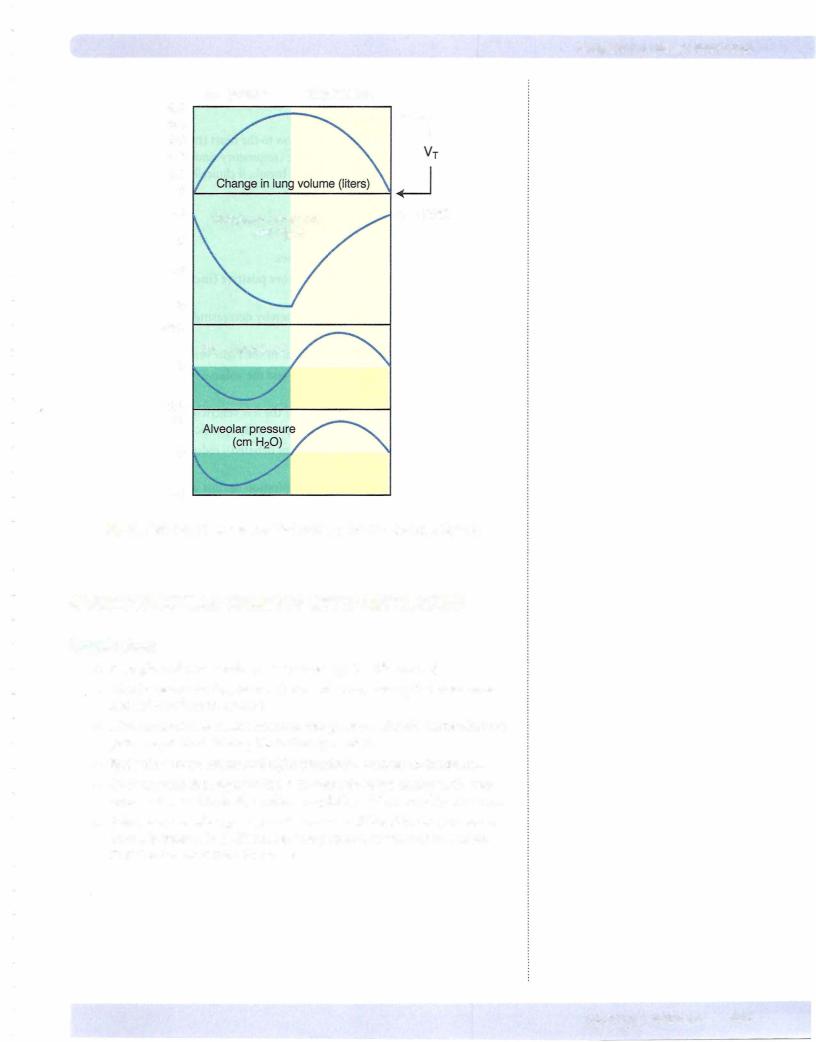

Section VII • Respiration
•In turn, venous return to the leftheart, and the output of the left ven tricle is decreased, causing decreased systemic arterial pressure (drop in systolic most prominent).
•This inspiration reduces vagal outflowto the heart (mechanism debatable)
resulting in a slight rise inheartrate (respiratorysinus arrhythmia). This is why patients are asked to holdtheirbreath, ifclinically possible, when an EKG is taken.
Expiration
•In short, reverse the above processes.
•Intrapleural pressurebecomesmorepositive (increases), i.e., returns to original negative value.
•PTM returns to its original level, thereby decreasing the pressure gradient forVR.
•Systemic venous return and output ofthe right ventricle are decreased.
•Pulmonary vessels are compressed, andthevolume ofblood in the pulmo nary circuit decreases.
•The return ofblood and output of the left ventricle increases, causing systemic arterial pressure to rise (primarily systolic).
•Vagal outflow increases (mechanism debated), reducing HR (respiratory sinus arrhythmia).
•A Valsalva maneuver is a forced expiration against a closed glottis. This forced expiration creates a positive IPP (see later in this chapter), which compresses the great veins in the chest. This in turn reduces VR.
POSITIVE-PRESSURE VENTILATION
Assisted Control ModeVentilation (ACMV)
Inspiratory cycle initiated by patient or automatically if no signal is detected within a specified time window. Expiration is not assisted. Expiration is accom plished in the normal manner (passive recoil ofthe lungs).
Positive End-Expiratory Pressure (PEEP)
PEEP (positive end-expiratorypressure)-positive pressure is applied at the end ofthe expiratory cycle to decrease alveolar collapse.
•Small alveoli have a strong tendency to collapse, creating regions of atel ectasis.
•The larger alveoli are also better ventilated, and supplementary oxygen is more effective at maintaining a normal arterial P02•
•PEEP is useful in treating the hypoxemia ofacute respiratory distress syndrome (ARDS). (See section on Hypoxemia.)
•One downside to positive pressure ventilation and accentuated by PEEP is a decrease in venous return and cardiac output.
•Assisted positive pressure ventilation and the addition ofPEEP are illus trated below.
144 MEDICAL
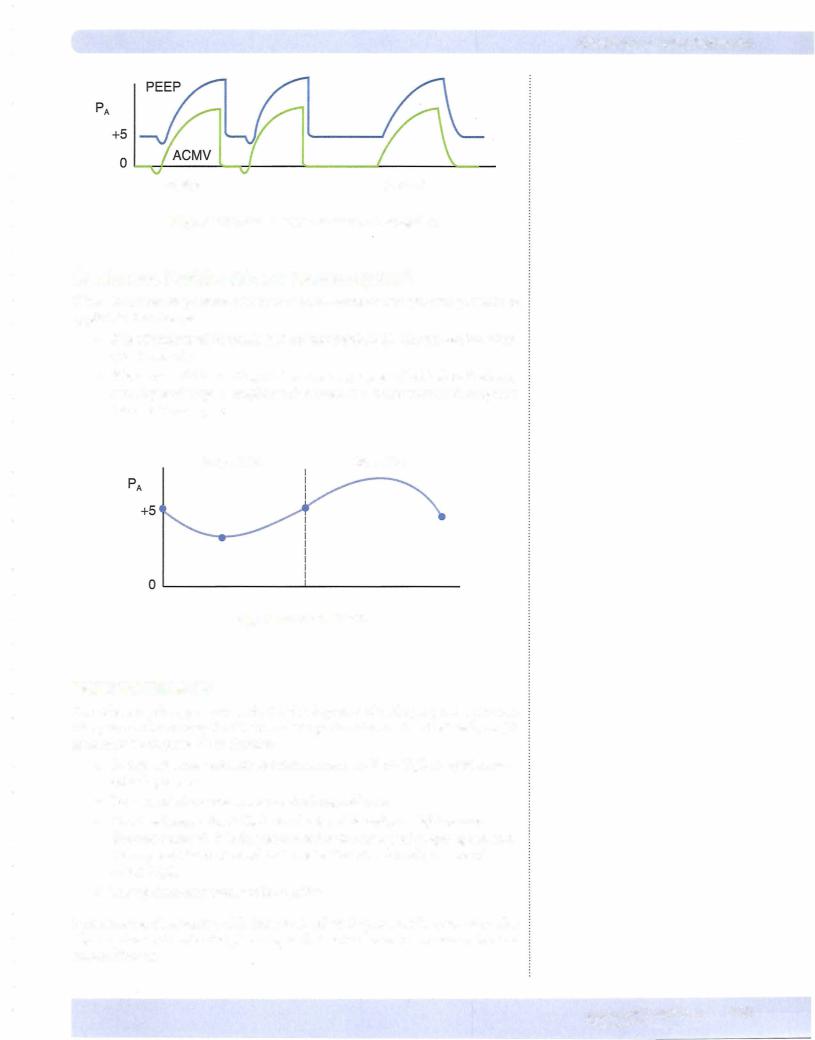
Chapter s • Lung Mechanics
Assist Control
Figure Vll-1-Sa. Positive-Pressure Ventilation
Continuous Positive Airway Pressure (CPAP)
CPAP (continuous positive airway pressure)-continuous positive pressure is applied to the airways.
•It is administered by mask (patient not intubated). The patient breathes spontaneously.
•It is very useful in treating obstructive sleep apnea (OSA) since the lung and upper airways (nasopharynx) remain at a larger volume throughout the respiratory cycle.
Inspiration Expiration
Figure Vll-1 -Sb. CPAP
PNEUMOTHORAX
The following changes occur with the development of a simple pneumothorax. The pneumothorax may be (1) traumatic: perforation of the chest wall, or (2) spontaneous: rupture ofan alveolus:
•Intrapleural pressure increases from a mean at -5 cm HzO to equal atmo sphericpressure.
•Lung recoil decreases to zero as the lung collapses.
•Chest wall expands.At FRC, the chestwall is under a slight tension directed outward. It is this tendency for the chestwall to spring out and the opposed force of recoil that creates the intrapleural pressure of
-5 cm H20.
•Transpulmonary pressure is negative.
In some cases, the opening ofthe lung to the pleural space mayfunction as avalve allowing the air to enter the pleural space but not to leave. This creates a tension pneumothora.x.
MEDICAL 145
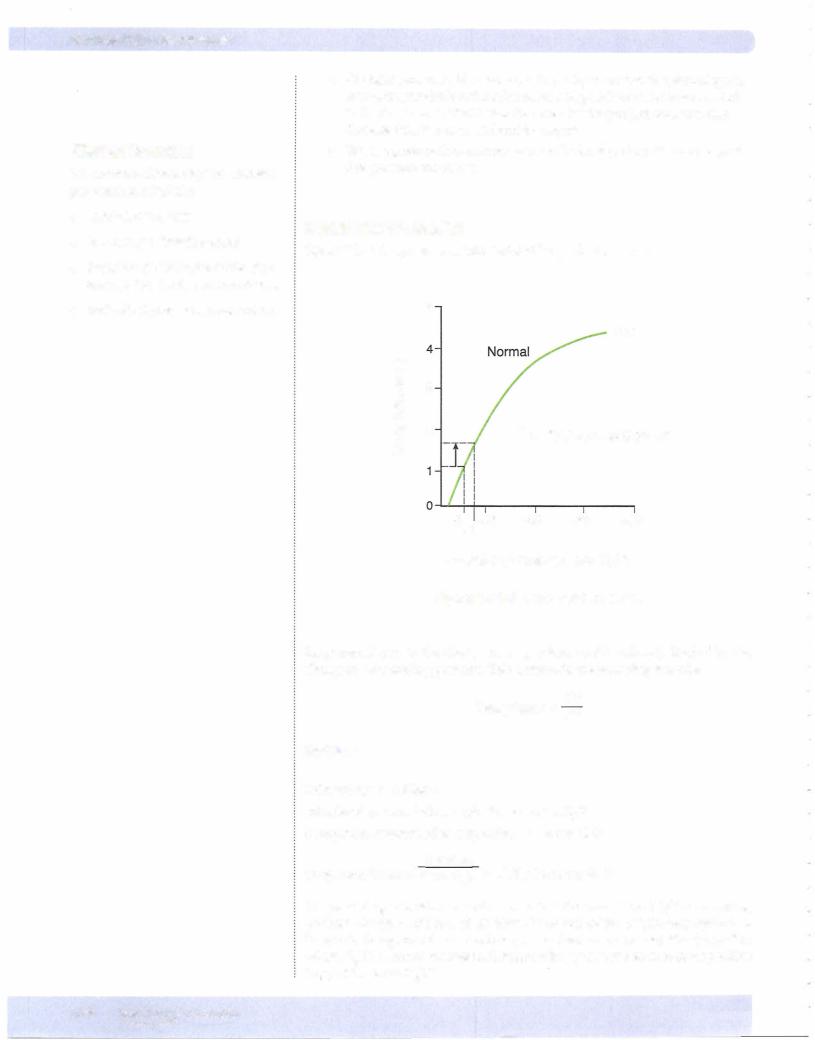
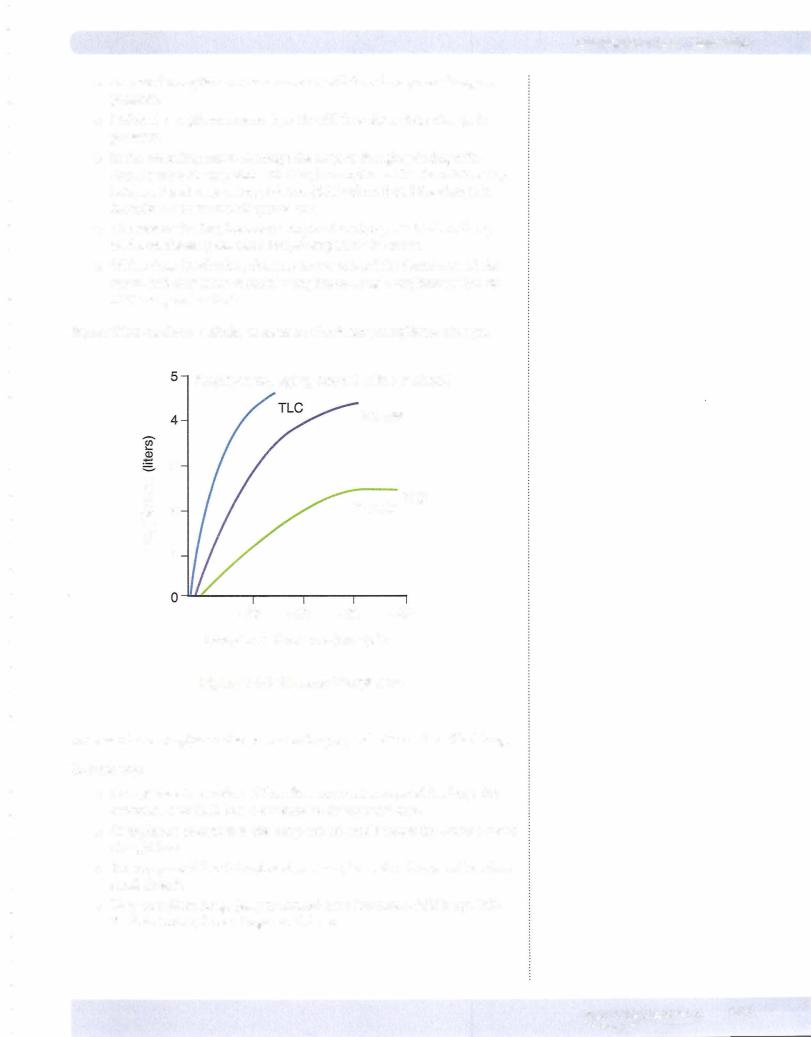
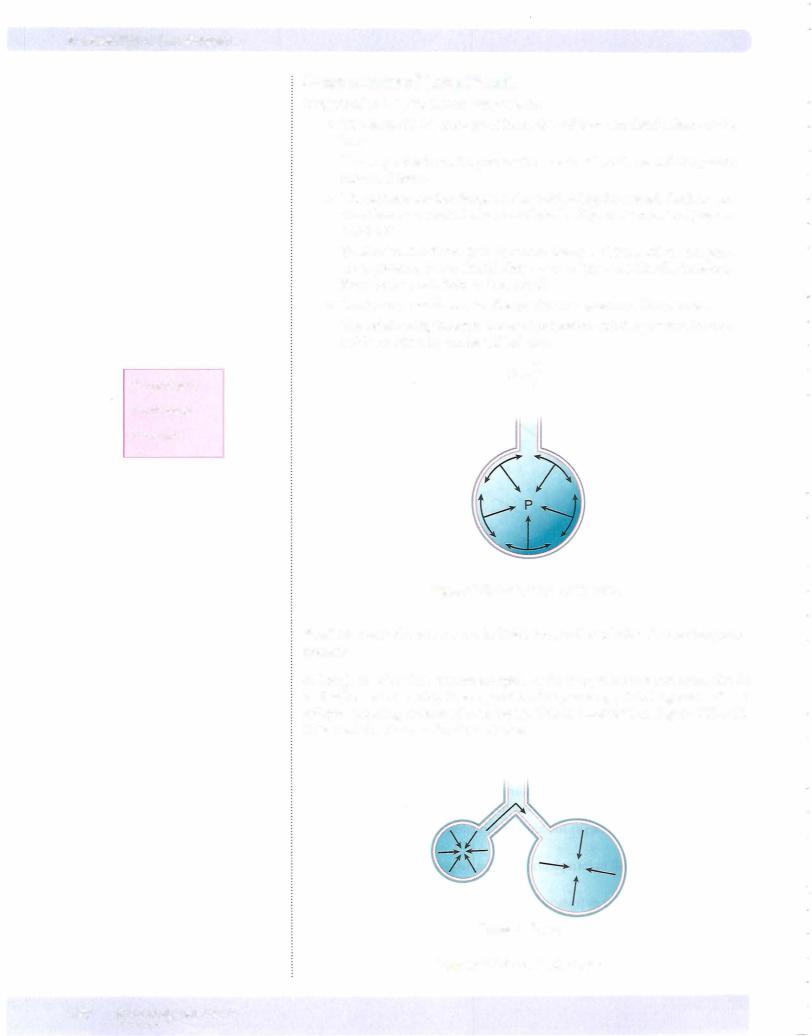
Section VII • Respiration
Components of Lung Recoil
Lung recoil has the following components:
•The tissue itself; more specifically, the collagen and elastin fibers of the lung.
The larger the lung, the greater the stretch of the tissue and the greater the recoil force.
•The surface tension forces in the fluid liningthe alveoli. Surface ten sion forces are created whenever there is a liquid-air interface (Figure
VII-1-11).
Surface tension forces tend to reduce the area of the surface and gener ate a pressure. In the alveoli, they act to collapse the alveoli; therefore, these forces contribute to lung recoil.
•Surface tensionforcesarethe greatest component oflungrecoil.
The relationship between the surface tension and the pressure inside a bubble is given by the law of LaPlace.
|
P |
T |
|
|
= |
P = pressure |
|
r |
T = tension |
|
|
r = radius |
|
|
|
|
|
Figure Vll-1-11 . Surface Tension
Ifwall tension is the same in two bubbles, the smaller bubble willhave the greater pressure.
Although the situation is more complex in the lung, it follows that small alveoli tend to be unstable. They have a great tendency to empty into larger alveoli and collapse (creating regions of atelectasis). This is illustrated in Figure VII-1-12. Collapsed alveoli are difficult to reinflate.
Psmall > P1arge
Figure Vll-1 -1 2. Atelectasis
148 MEDICAL
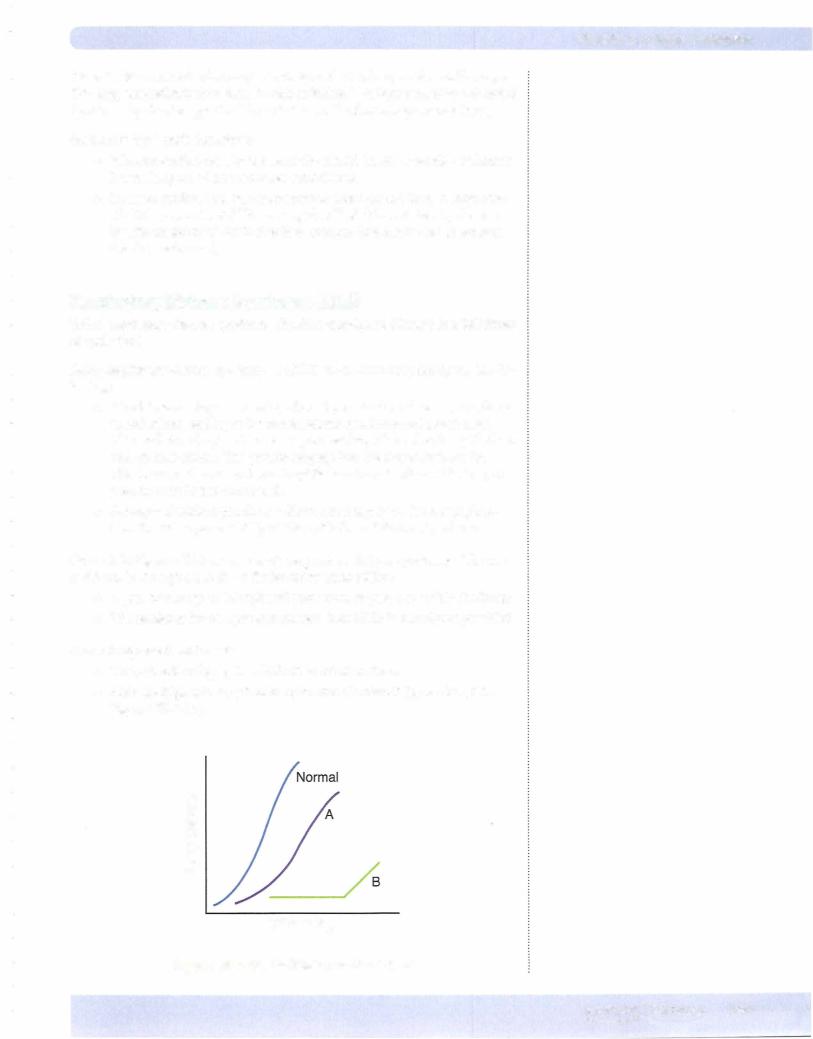
Chapter 1 • Lung Mechanics
Ifthealveoliwerelinedwithasimpleelectrolyte solution, lungrecoilwouldbesogreat that lungs theoretically should not be able to inflate. This is prevented by a chemical (produced byalveolartype II cells), surfactant, in the fluid lining a normal lung.
Surfactant has 2 main functions:
• It lowers surface tension forces in the alveoli. In other words, surfactant lowers lung recoil and increases compliance.
• It lowers surface tension forces more in small alveoli than in large alve oli. This promotes stability among alveoli of different sizes by decreas ing the tendency of small alveoli to collapse (decreases the tendency to develop atelectasis).
Respiratory Distress Syndrome (RDS)
Infant respiratory distress syndrome (hyalinemembrane disease) is a deficiency ofsurfactant.
Adult respiratory distress syndrome (ARDS) is an acute lung injury via the fol lowing:
•Bloodstream-Sepsis-develops from injury to the pulmonary capillary endothelium, leading to interstitial edema and increased lymph flow. This leads to injury and increased permeability ofthe alveolar epithelium and alveolar edema. The protein seepage into the alveoli reduces the effectiveness ofsurfactant. Neutrophils have been implicated in the pro gressive lung injury from sepsis.
•Airway-Gastric aspirations-direct acute injury to the lung epithe lium increases permeability of the epithelium followed by edema.
Curve A in FigureVII-1-13 represents respiratory distress syndrome. The curve is shifted to the right, and it is a flatter curve (lung stiffer).
•A greater change in intrapleural pressure is required to inflate the lungs.
•The tendency for collapse is increased,thus PEEP is sometimes provided.
Curve B represents atelectasis.
•Once alveoli collapse, it is difficult to reinflate them.
•Note the high TPP required to open atelectic alveoli (green line, B in Figure VIl-1-13).
EQ)
::::J
C> c
::::J
...J
TPP or PTM
Figure Vll-1-13. Deficiency of Surfactant
MEDICAL 149
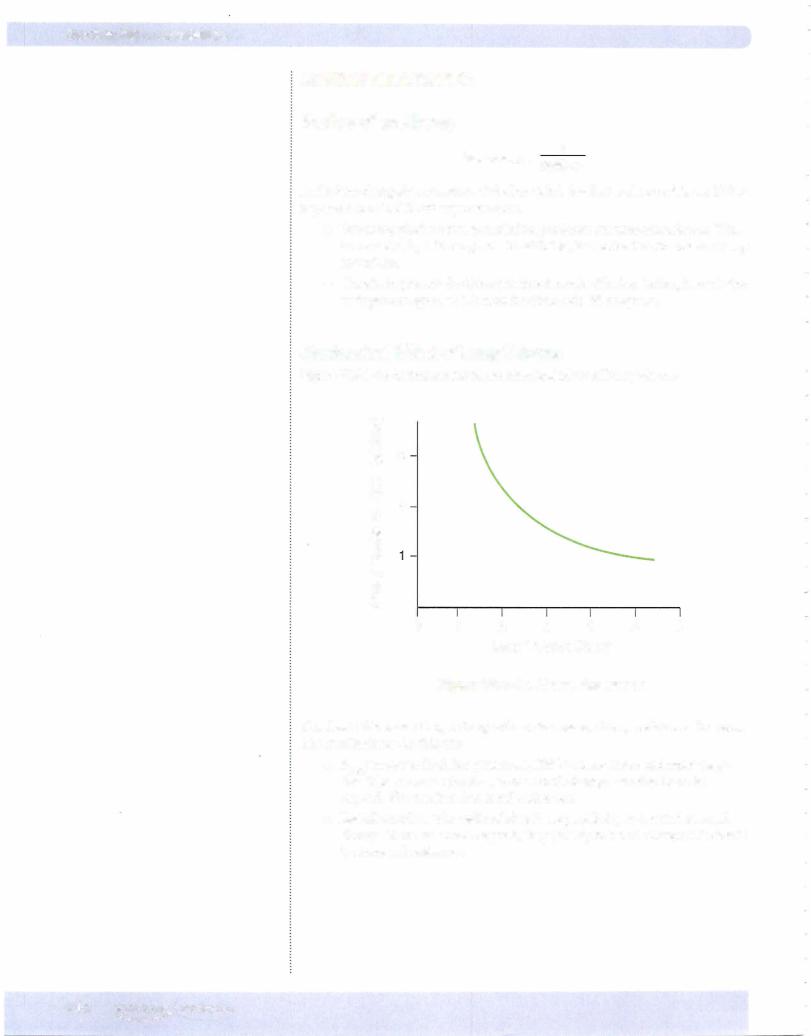
Section VII • Respiration
AIRWAY RESISTANCE
Radius ofan Airway
1
Resistance = radius4
In the branching airway system ofthe lungs, it is the first and second bronchi that represent most of the airway resistance.
•Parasympathetic nerve stimulation produces bronchoconstriction. This is mediated by M3 receptors. In addition, M3 activation increases airway secretions.
•Circulating catecholamines produce bronchodilation. Epinephrine is the endogenous agent and it bronchodilates via 2 receptors.
Mechanical Effect of LungVolume
Figure VII- 1 - 14 demonstrates the mechanical effect oflung volume.
u |
|
|
|
|
|
|
|
Q) |
|
|
|
|
|
|
|
st!. |
|
|
|
|
|
|
|
0I |
3 |
|
|
|
|
|
|
Q)EN |
2 |
|
|
|
|
|
|
|
|
|
|
|
|
|
|
c |
|
|
|
|
|
|
|
(.) |
|
|
|
|
|
|
|
Cll |
|
|
|
|
|
|
|
- |
|
|
|
|
|
|
|
(/) |
|
|
|
|
|
|
|
'Ci) |
|
|
|
|
|
|
|
Q) |
|
|
|
|
|
|
|
a: |
|
|
|
|
|
|
|
>. |
|
|
|
|
|
|
|
Cll |
|
|
|
|
|
|
|
:J: |
|
|
|
|
|
|
|
<..... |
0 |
1 |
Lung2 |
Volume3 |
(liters)4 |
5 |
6 |
Figure Vll-1 -1 4. Airway Resistance
The figure illustrates that, as lung volume increases, airway resistance decreases.
The mechanisms for this are:
•PTM: To get to high lung volumes, IPP becomes more and more nega
tive. This increases the PTM across small airways, causing them to expand. The result is decreased resistance.
•Radialtraction: The walls of alveoli are physically connected to small airways. Thus, as alveoli expand, they pull open small airways. The result is decreased resistance.
1 50 M EDICAL

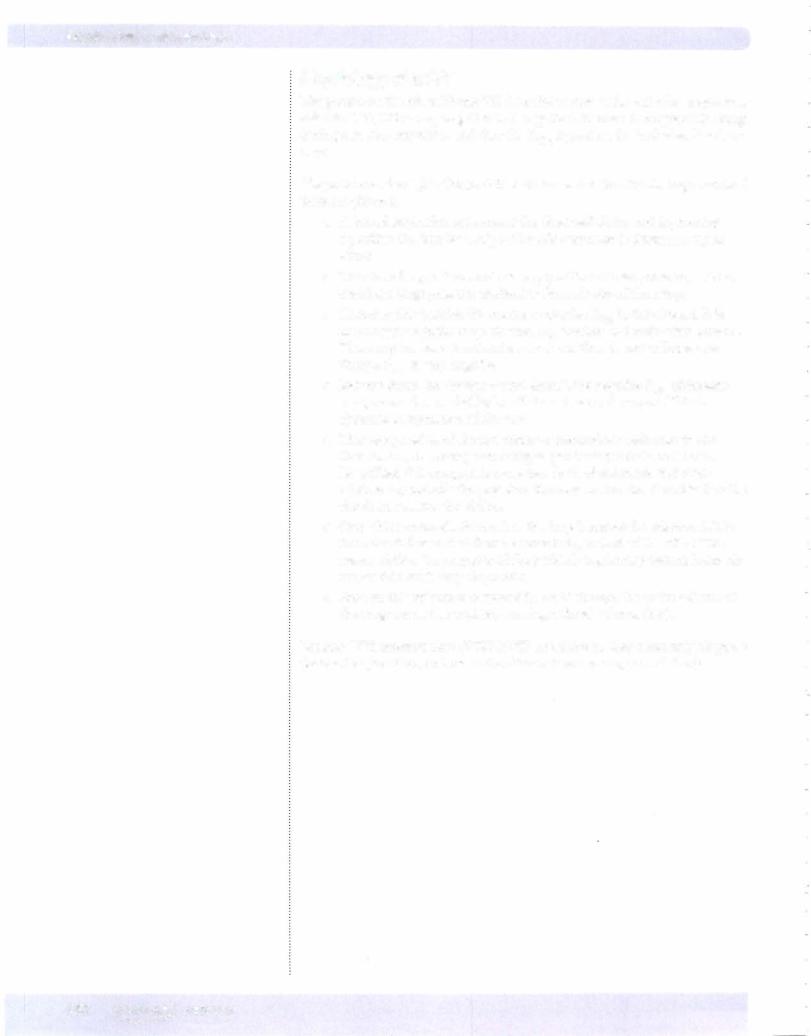
Section VII • Respiration
Physiology ofa PFT
The picture on the left of Figure VII-1 - 16 shows that at the end ofan inspiratory effort to TLC, IPP is very negative. This negative IPP exists throughout the lungs during a passive expiration and thus the PTM is positive for both alveoli and air ways.
The picture on the right of Figure VII- 1-16 shows the situation during a maximal forced expiration.
•A forced expiration compresses the chest wall down and in, creating a positive IPP. The level of positive IPP generated is dependent upon effort.
•This forced expiration creates a very positive alveolar pressure, in turn creating a large pressure gradient to force air out of the lungs.
•However, this positive IPP creates a negative PTM in the airways. It is more negative in the large airways, e.g., trachea and main-stem bronchi. These regions have structural support and thus do not collapse even though PTM is very negative.
•Moving down the airways toward alveoli, the negative PTM ultimately compresses airways that lack sufficient structural support. This is dynamic compression of airways.
•This compression of airways creates a tremendous resistance to air- flow. In fact, the airway may collapse, producing infinite resistance.
Regardless, this compression creates a level of resistance that over whelms any and allother resistors that exist in the circuit and is thus the dominant resistor for airflow.
•Once this occurs, elastic recoil of the lung becomes the effective driving force for airflow and airflow becomes independent of the effort. This means airflow is a property of the patient's respiratory system, hence the reason this test is very diagnostic.
•Because this resistance is created in small airways, the entire volume of the lungs cannot be expired, creating residual volume (RV).
Because PFTs measure flow (FEVl/FVC) and volume, they accurately diagnose obstructive (low flow) and restrictive disease (low volume, normal flow).
1 52 MEDICAL
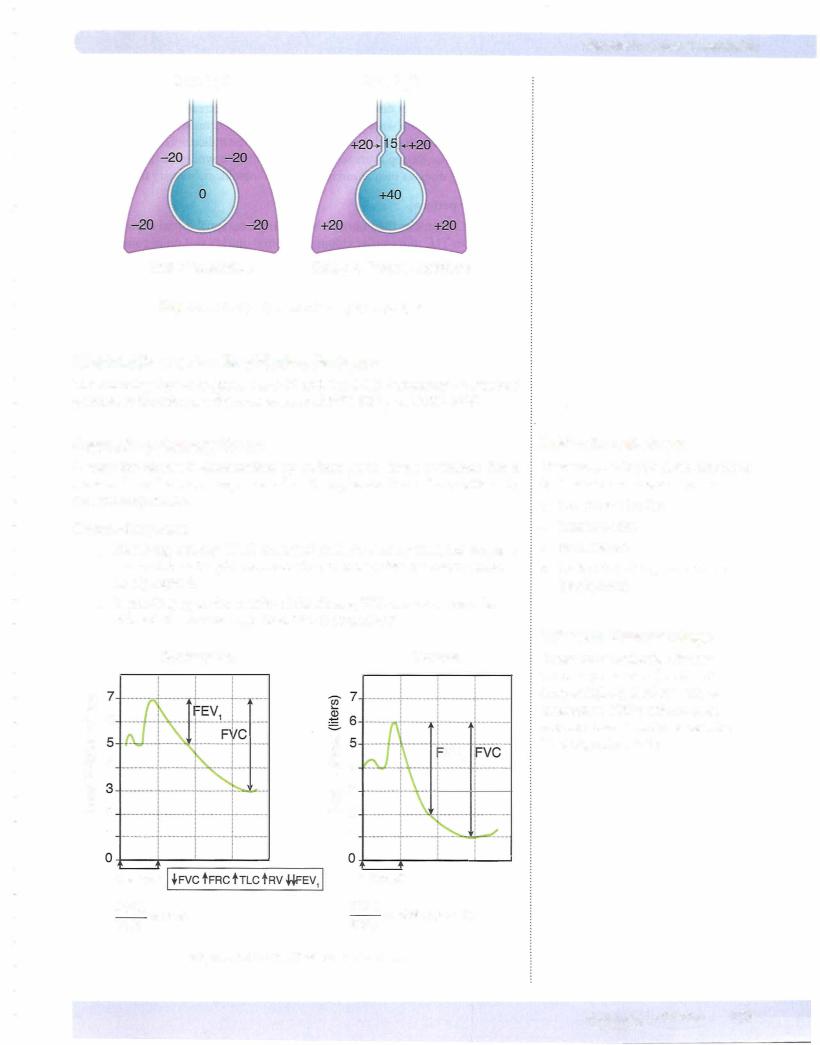
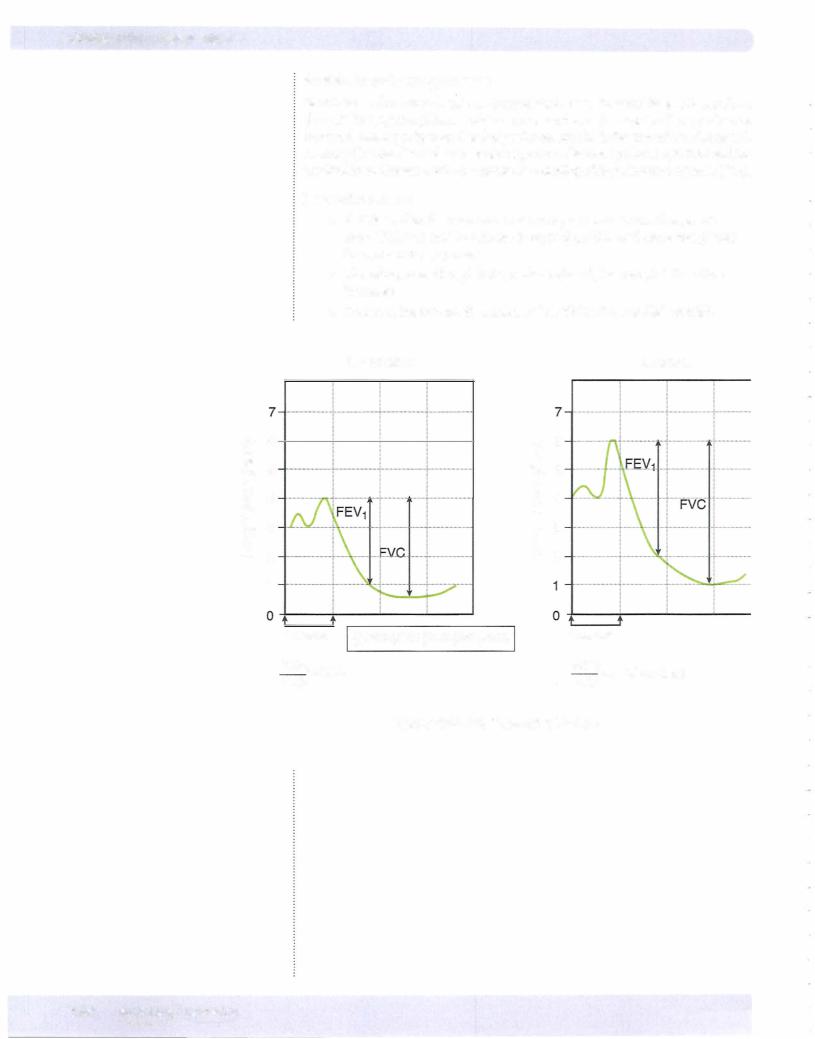
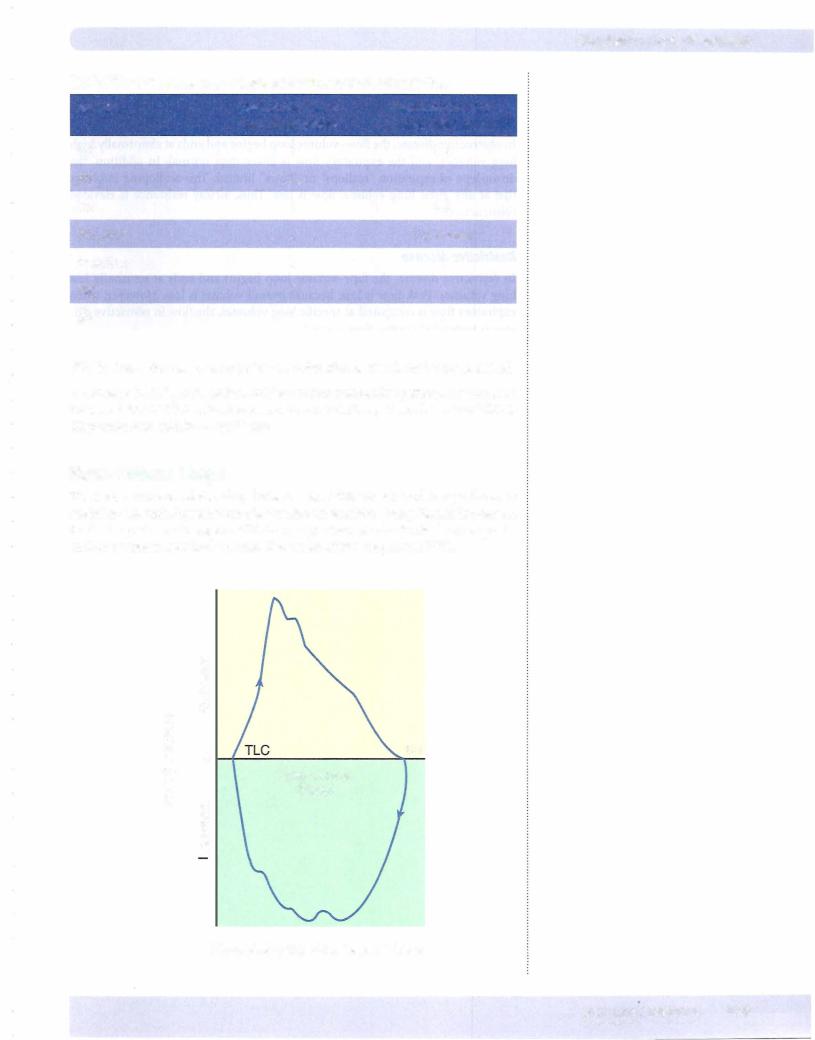
Chapter 1 • Lung Mechanics
TableVll-1-1. Summary of ObstructiveVersus Restrictive Pattern
Variable |
Obstructive Pattern |
Restrictive Pattern |
|
e.g., Emphysema |
e.g., Fibrosis |
TLC |
i |
J, J, |
FEV1 |
J, J, |
J, |
FVC |
J, |
J, J, |
FEV1/FVC |
J, |
i or normal |
Peak flow |
J, |
J, |
FRC |
i |
J, |
RV |
i |
J, |
FVC is always decreased when pulmonary function is significantly compromised.
A decrease in FEV/FVC ratio is evidence of an obstructive pattern. A normal or increased FEV/FVC ratio is evidence of a restrictive pattern, but a low TLC is diagnostic of restrictive lung disease.
Flow-Volume Loops
The instantaneous relationship between flow (liters/sec) and lung volume is useful in determining whether obstructive or restrictive lung disease is present. In the loop shown in Figure VII- 1 - 19, expiration starts at total lung capacity and continues to residual volume. The width of the loop is the FVC.
|
c: |
|
|
|
0 |
|
|
|
·a.. .. |
|
|
|
|
|
|
|
x |
|
|
Q |
UJ |
|
|
(]) |
0 |
|
RV |
..... |
|
||
en |
|
|
|
--(]) |
|
|
|
(/) |
|
Lung volume |
|
0 |
c: |
|
|
.. |
(liters) |
|
|
"=- |
0 |
|
|
:5: |
|
|
|
[L |
·ac:. |
|
|
|
|
|
|
|
..en .. |
|
|
Figure Vll-1-1 9. Flow-Volume Loop
MEDICAL 1 5 5

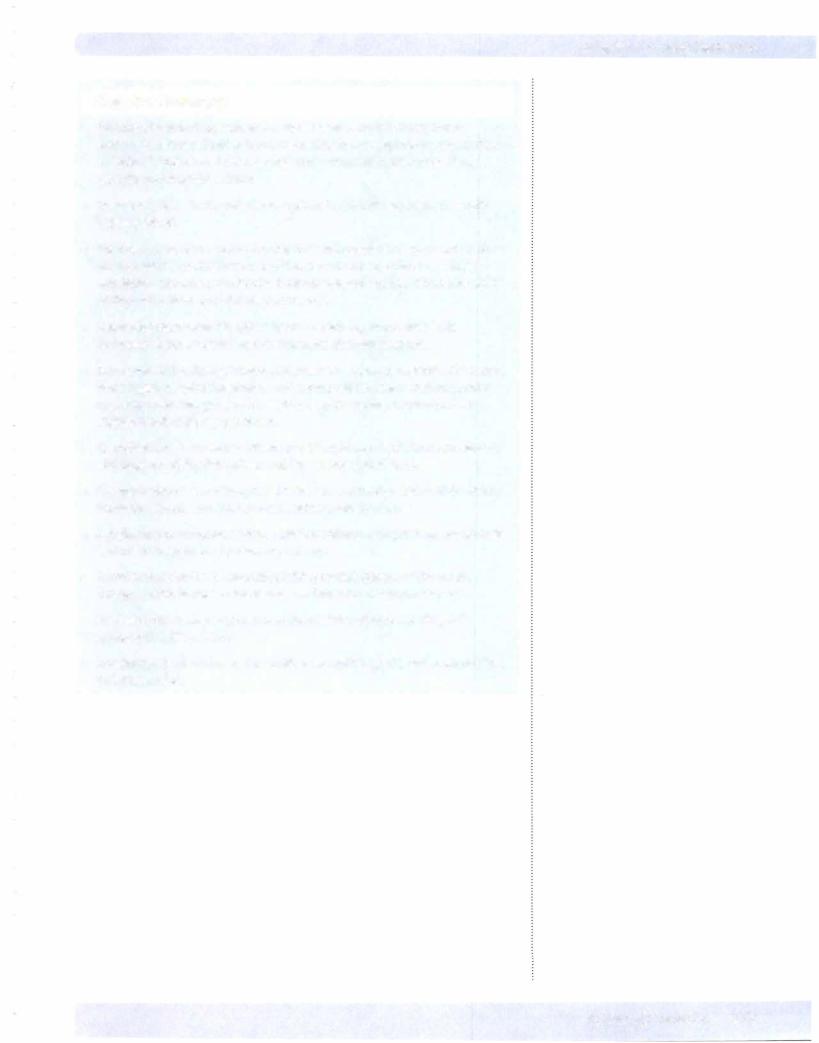
Chapter 1 • Lung Mechanics
Chapter Summary
•Functional residual capacity is the equilibrium point ofthe respiratory system. Residual volume is the air remaining in the respiratory system after a maximal expiration. Vital capacity is the difference between total lung capacity and residual volume.
•Dead space is air in the respiratory system that is not exchanging gas with capillary blood.
•The first 150 ml of an inspiration fills the anatomical dead space with room
air. This volume contributes to total but not alveolarventilation. Alveolar ventilation represents the inspired volume beyond 150 ml. It is the inspired air that actually reaches the respiratory zone.
•Inspiration decreases IPP, which in turn causes PrM to increase. This increases alveolar volume, which decreases alveolar pressure.
•During restful breathing, intrapleural pressure is always negative. It becomes more negative during inspiration and more positive (less negative) during expiration. Alveolar pressure is slightly negative during inspiration and slightly positive during expiration.
•Compliant lungs are easy to inflate and possess low recoil. Noncompliant or
stifflungs are difficult to inflate and have a large recoil force.
•The main component of lung recoil is the surface tension forces of the fluid lining the alveoli. Surfactant reduces surface tension forces.
•A deficiency of surfactant reduces lung compliance and promotes atelectasis and the development of pulmonary edema.
•A maximal expiration is associated with a partial collapse ofthe small airways, which increases resistance and limits the maximum flow rate.
•An obstructive pattern is often associated with a diminished FEVJFVC, elevated TLC, FRC, and RV.
•A restrictive pattern is associated with a normal FEVJFVC, but a reduced FVC, TLC, FRC, and RV.
MEDICAL 1 57

